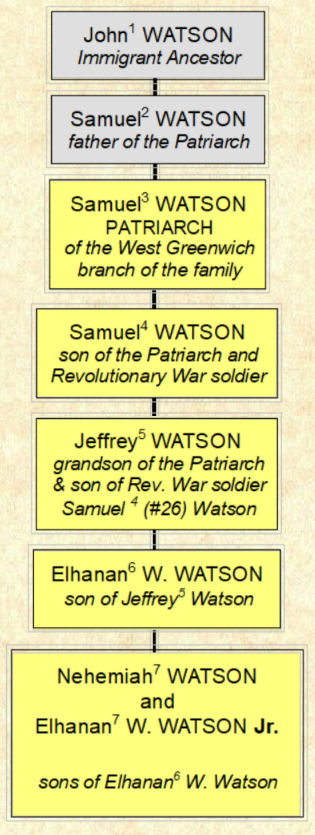
The WATSON Family of West Greenwich, Rhode Island – Part 3
A branch of the Watson family of Rhode Island settled in West Greenwich and lived there for nearly one hundred years.
The patriarch of this branch was Samuel, designated #7 in The American Family of John Watson of the Narragansett Country, Rhode Island. Samuel was the grandson of John Watson, and the son of Samuel2 and 1st wife Mercy (Helme) Watson. His line of descent as a 3rd‐generation Watson is rendered Samuel3 (Samuel2, John1).
To read Part One, click here.
To read Part Two, click here.
Table of Contents
Dedication
Part Three
Jeffrey Watson, son of Samuel #26 Watson
Hessie W. (George) (Wade) Hammond (1879‐1970)
Elhanan W. Watson Jr. (1844‐1888)
Things We Learned from Elhanan Jr.’s Civil War Pension File
Death of Elhanan W. Watson Jr.
Appendix
Samuel Gallop of West Greenwich
More About the Draper Family of West Greenwich
About Eunice, Jeffrey Watson’s Second Wife
Watson Burials in Gallup Cemetery, Sterling, Connecticut
Harriet Hempstead After Elhanan
Sources
Home
Dedication
The WATSON Family of West Greenwich, Rhode Island – Part 3 is dedicated to the memory of Pete Watson (shown below, at left) and Don Watson (on the right).
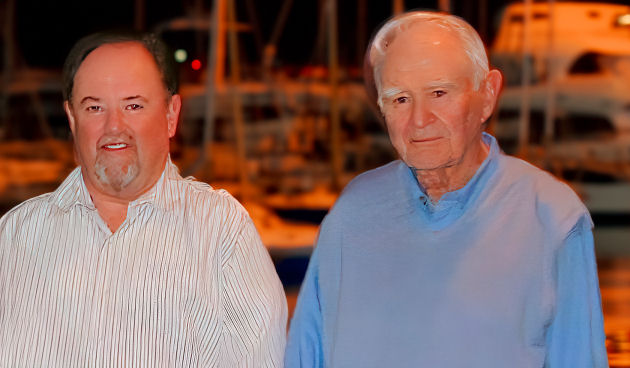
Don laid the foundation for our Watson family history many years before online research became possible. He interviewed elderly relatives to capture memories before they were gone; he visited town halls to delve into old records. He also met with the folks who published The American Family of John Watson of the Narragansett Country, Rhode Island—knowing this was the right place to look; not knowing they’d inadvertantly scrambled two different generations of men named Samuel Watson, obscuring his line of descent. We got this sorted out later (see Samuel #26 Watson), and Don rejoiced in knowing where the Connecticut line linked to its Rhode Island origins.
Pete enjoyed digging into Watson research, and he applied some critical thinking to the family lore. We learned from Pete, not long before he died, that he’d arrived at the same conclusion about Elhanan W. Watson Sr. having participated in the California Gold Rush: Not likely. (Sorry, Don.)
We’re grateful that Pete participated with us in the Watson Y‐DNA Project. His data gave rise to a new haplogroup at FamilyTree DNA; and it put the direct male line of John Watson of the Narragansett Country on the map there. It is Pete’s legacy, and an enduring gift to future Watsons seeking their roots.
Thank you, Pete and Don, for sharing your research data and your passion for the process. We hope you’re looking up our ancestors in Heaven and finally getting answers to our toughest brick‐wall questions.
Part Three
Jeffrey Watson, son of Samuel #26 Watson
Jeffrey5 WATSON (Samuel4, Samuel3, Samuel2, John1) was born circa 1786 in West Greenwich, Rhode Island, the sixth of Samuel4 #26 and Abiah (Young) Watson’s nine children.
DISAMBIGUATION:
Jeffrey5 Watson had no middle name.
Jeffrey5 Watson is often confused with Jeffrey Hazard Watson of South Kingstown, who was born around the same year and died apparently on the same month and day as Jeffrey5 (January 6th) but twenty-six years earlier, in 1838. Jeffrey5 Watson died in 1864.
Jeffrey5 Watson never shows up in the Rhode Island census under his own name, though his presence is noted in the enumeration of his father’s household in 1790 and 1800. Even in Connecticut, where he spent the majority of his adult life, Jeffrey did not leave much of a paper trail. Finding evidence of Jeffrey5 Watson’s life is largely a matter of tracing the people around him, beginning with his first wife, Joanna Gallop.
Jeffrey’s wife, Joanna Gallop
Her surname occasionally appears as Gallup but more often was spelled Gallop. Her first name appears in various places and records as Joan, Joanna, Joanah, and Joannah. In the 1800 census she was listed as Joanah Gallop: in the 1850 census she was “Annie,” which is how she was remembered by some of her descendants.
Joanna Gallop’s name appears a dozen times in West Greenwich, RI, town council records. The first entry is dated May 29, 1797; the last on November 27, 1809. Joanna’s presence in these records involves the children she had as a young unmarried woman.
Joanna Gallop in Census & WG Town Council records
On May 29, 1797, the town council of West Greenwich paid Joanna Gallop $15.00 toward the upkeep of her child “laid to” Paul Rathbun (WG TC: Book 4, unpaginated). A child “laid to” a man meant that the mother had identified the father of her out‐of‐wedlock child, so that the town could assess the father for child support. The town council would then dole it out over time to the person caring for the child, often the mother.
Town council records for March 26, 1798, mention Joanna twice – once in reference to midwife Phoebe Mowry’s fee for attending to Sarah and Joanna Gallop “when they Lay In with Bastard Children;” and again with regard to $6.00 granted to Joanna for caring for her child, laid to Paul Rathbun, “up to this date” (WG TC: Book 4, unpaginated).
On October 29, 1798, the town doled out $4.25 to “Joannah Gallup” for the upkeep of her child, laid to Paul Rathbun, “seven weeks from the last Monday in March last at 1:6 per week” (WG TC: Book 4, unpaginated).
On November 25, 1799, Joanna received $7.25 from the town. This was the last time that Paul Rathbun’s name was noted in a town council record regarding child support given to Joanna Gallop (WG TC: Book 4, unpaginated).
On February 3, 1801, the town gave Joanna Gallop $2.00 “for supporting herself the present winter” (WG TC: Book 4, unpaginated).
Seven years pass before Joanna shows up in WG town council records again. An entry for March 28, 1808, notes that $3.97 was provided to “Joan” Gallop “for keeping her child Mary 27 weeks to this day” (WG TC: Book 5, unpaginated). This entry is notable for naming Joanna’s child, a rarity in these records.
The 1800 census accurately notes Joanna’s child as a girl, recorded in the column for females under 10 years of age. We find Joanna recorded in the column for females aged 26 through 44. We think she was actually 24 years old at the time.

Given Joanna Gallop’s circumstances, it’s fairly impressive that she is on record as head of her own household.
Other names on that census page, shown excerpted here, indicate that Joanna lived in the Escoheag area of West Greenwich, basically the same neighborhood in which the Watsons lived. If Amasa Pratt (here listed as “Ammesa” Pratt) is buried on what used to be his property, this gives us some idea of where Joanna lived in 1800. The Amasa Pratt Lot, also known as RI Historic Cemetery West Greenwich #7 (WG007), is located along the east side of Escoheag Hill Road across from the Escoheag Baptist Church (the “Palmer Meeting House”). The coordinates for this cemetery are 41.6008830, ‐71.7612080.
“Joan Gallup” was mentioned again in town council records for September 3, 1808, when she was allowed $2.90 (no particular reason cited).
By April 24, 1809, things had changed. Joanna Gallop appears three times in that day’s record of the town council meeting (WG TC: Book 5, unpaginated):
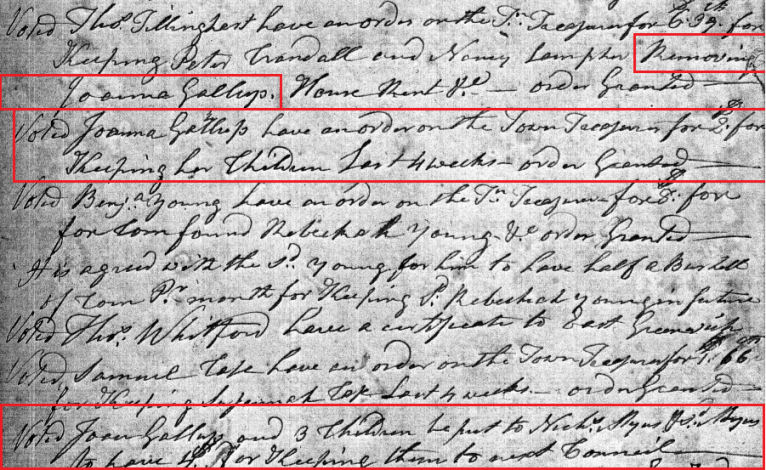
“Voted Thomas Tillinghast have an order on the Town Treasurer for $6.39 for Keeping Peter Crandall and Nancy Lampher; Removing Joanna Gallup. House rent etc.”
“Voted Joanna Gallup have an order on the Town Treasurer for $2 for Keeping her Children Last 4 weeks”
“Voted Joan Gallup and 3 Children be put to Nicholas Myers & sd Myers to have $4 for Keeping them to next Council”
Not quite eight months after her last mention in town council records, Joanna went from having one child to having three. While it’s possible she took in orphaned nieces or nephews, more likely Joanna gave birth to twins. Apparently these children were born in March, and the town was just catching up to that fact.
In light of Joanna’s new situation, the town took action by having Thomas Tillinghast literally remove Joanna and her children from wherever they were living and put them in the household of Nicholas Myers. Myers was paid $4.00 up front for “keeping them” until the council’s next meeting. This action wasn’t meant to be helpful to Joanna and her family. It was a means of controlling one of the town’s poor from doing anything else that would cost the town more money.
Two more town council entries referring to Joanna suggest she managed somehow to reassert her independence from the worst aspects of West Greenwich’s poor relief system.
On June 26, 1809, Joanna was given $4.00 for “keeping her children.” If she were still being “kept” by a townsman, he would have been paid that money. And on November 27, 1809, she was paid the sum of $7.50, with no reason given. (WG TC: Book 5, unpaginated)
The father of Joanna’s younger children was never named in town council records. Joanna might have refused to divulge the man’s name. Or – heavens! – she didn’t know who the father was. It’s also possible the man involved convinced the town fathers not to enter his name into the record.
After November 27, 1809, Joanna Gallop disappears from West Greenwich town council records. She does not appear as a head of household in the 1810 census listing for that town.
Jeffrey Watson is not accounted for in his father’s household in the 1810 census; he does not appear as head of his own household until 1820.
We have found that people who marry in a census year tend to show up twice in that year’s census record; or, more frequently, not at all. We think it likely that Jeffrey and Joanna wed in 1810.
Section Summary:
Jeffrey5 Watson, son of Samuel4 #26 Watson, was born circa 1786 in West Greenwich, Rhode Island.
Jeffrey5 Watson had no middle name.
While Jeffrey never shows up in the Rhode Island census under his own name, the woman he married – Joanna Gallop – does, in the 1800 census for West Greenwich. Joanna Gallop’s name appears numerous times in WG town council records, owing to the fact that she had children out of wedlock.
Jeffrey and Joanna likely got married in 1810.
Jeffrey Watson in Connecticut
Jeffrey is first of record in Connecticut in the 1820 census. His name, spelled “Jeffery,” appears following his brother Benjamin Watson, separated by only one other name, that of Josiah Tanner.
Ancestry.com shows the Watson brothers’ 1820 census listing as being in the town of Sterling, CT. For reasons we discuss in detail on page 38 of brother Benjamin’s story, we believe those census pages were in fact for Voluntown, CT, the town abutting Sterling to the south. At that time, both towns were part of Windham county.
The household numbers for Jeffrey Watson’s family in 1820 include five children – three males and two females under the age of 10 – and a male and female aged 26 through 44 (Jeffrey and Joanna).
These numbers don’t include the children Joanna had before marrying Jeffrey. While we’re not surprised that Joanna’s eldest child, Mary – born circa 1797 – isn’t enumerated with the family, we wonder what happened to the children who were born in spring of 1809. Perhaps they died young.
The 1830 census shows Jeffrey Watson living in Voluntown. By then, his brother Benjamin was dead. The names of Jeffrey’s neighbors had changed, but enough of the same ones remain (Elias Ney; Thomas Gordon; Benjamin and James Briggs) that we think Jeffrey was still residing in the same area as in 1820. In 1830, Jeffrey and Joanna’s household included one male between the ages of 40 and 49 (Jeffrey); one female between 50 and 59 (Joanna); one male between 15 and 19; two males between 10 and 14; two females between 15 and 19; and one female between 5 and 9 – for a total of eight people.
In 1840, Jeffrey Watson and his family were living in Sterling. Their neighbors now included Benadam and Nathaniel Gallup (father and son); Porter Thayer; Benoni Lewis; and Reuben Harris. In this census year, the numbers for Jeffrey’s household had fallen to a total of four. Two of them account for Jeffrey and Joanna, both listed as between 50 and 60 years of age. Joanna’s age should have fallen into the next category, “of 60 and under 70.” In 1840 she would have been around 64 years old.
Also enumerated in Jeffrey’s household in 1840 were two females under the age of 20. We can assume that the female aged 15 through 19 was Jeffrey and Joanna’s youngest child, born at the outer limits of Joanna’s childbearing years. This daughter would have been about 19 years old in 1840. The girl enumerated as being between 10 and 14 years of age, however, has to be someone else’s daughter – a grandchild, perhaps, or a local girl boarding with the Watsons.
Jeffrey and Joanna (Gallop) Watson’s Children
We have identified four of Jeffrey and Joanna’s six children and found possible candidates for the other two.
- ESTHER6, born on or around June 30, 1811 in West Greenwich, RI; died April 17, 1894, in Cranston, RI. Esther Watson married Henry P. JORDAN, with whom she had ten children.
- SON, possibly named Benjamin.
- DAUGHTER, possibly named Sarah.
- ELHANAN W., born June 30, 1816, in West Greenwich, RI; died September 6, 1903, in New London, CT. His first wife was Ardelia LAMB, with whom he had two sons. His second wife was Harriet M. HEMPSTEAD, with whom he had one son. His third wife was Fidelia C. WALKER.
- JEFFREY, born December 16, 1818, in West Greenwich, RI; died March 6, 1909, in Sprague, CT. Jeffrey Jr. married Lurancy Melvina BROWN, with whom he had four children.
- WEALTHY ANN, born February 26, 1821, likely in Voluntown, CT; died February 18, 1907, in N. Kingstown, RI. Wealthy Ann married Stephen Bowen GREENE, with whom she had three children.
Jeffrey and Joanna’s Final Years: 1850‐1864
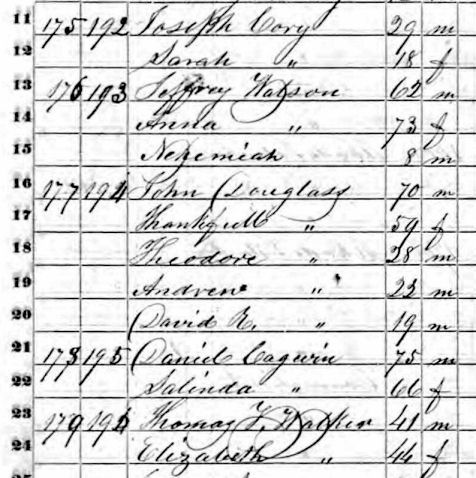
By 1850 Jeffrey and Joanna were back in Voluntown. Enumerated with Jeffrey and “Anna” in that census year was their eight‐year‐old grandson Nehemiah Watson, the child of their son Elhanan W.
Viewed over the course of decades, the life of this couple and their family seems relatively stable. Unlike two of his brothers, Jeffrey Watson left no paper trail of court cases and prison records.
But it’s fairly likely that Jeffrey Watson moved his household more times than four decennial census records can show us. We say this because we have found no record of Jeffrey Watson ever owning property in either Sterling or Voluntown.
The place where Jeffrey and Joanna lived in 1850 belonged, on paper, to their son Elhanan W. Watson. That property was purchased by Elhanan on behalf of his two young sons, Nehemiah and Elhanan Jr., as part of a guardianship arrangement.
Estate Money
The inheritance Elhanan W. Watson Sr. handled on behalf of his sons wasn’t a happy windfall. It came following the early death of the boys’ mother, Ardelia (Lamb) Watson, in 1845; and then the passing of Ardelia’s father, William Lamb Jr., in 1847.
The portion of William Lamb Jr.’s estate that would have gone to Ardelia went, instead, to her children. Elhanan Sr., appointed as guardian, was allowed by the courts to sell that property in Ledyard, CT, and re‐invest it in such a way as to grow its value. Elhanan Sr. did this by purchasing 100 acres of land from Jareb Lewis and his wife Olive. That property lay mostly in northern Voluntown, with some of it overlapping into the town of Sterling.
Descriptions of the Voluntown property in the guardianship papers; census records; a couple of historic maps; and Voluntown’s Index to Deeds together provide the data needed to ascertain roughly where this property lay.
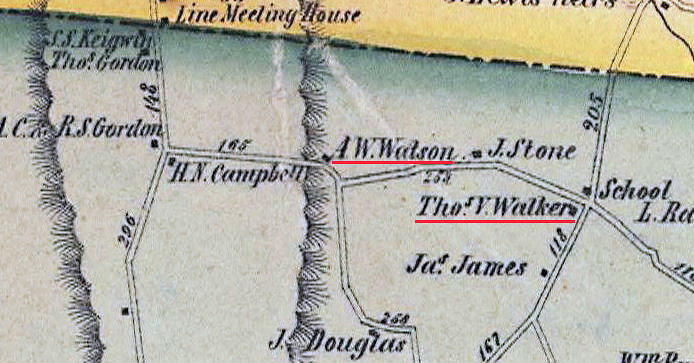
In 1850, Jeffrey and Annie Watson were enumerated on the same page as Thomas V. Walker. Only two other households, those of John Douglass and Daniel Cagwin, separated the Watson and Walker households.
A map of Voluntown, with a circa date of 1856, shows the house locations of “A. W. Watson” and “Thos V. Walker” along what is present‐day Congdon Road. (We aren’t worried about the incorrect first initial for Elhanan.)
Between June 1857 and March 1858, Elhanan Sr. disposed of this property, the proceeds presumably going to the benefit of his sons Nehemiah and Elhanan Jr.
Another map of Voluntown, dated 1868, shows the house previously marked as belonging to “A. W. Watson” now labeled with the name “B. Mathewson.”
This property seems to have percolated at least partially through the hands of Thomas V. Walker and his wife Elisabeth. Voluntown deed indexes record a quitclaim deed granted by Elhanan W. Watson to Elisabeth Walker on March 5, 1858. On that same day, recorded on the same page, Thomas V. and Elisabeth Walker granted a warranty deed to Bowen Matthewson. That man’s name is pretty much a match for the new name on the 1868 map.
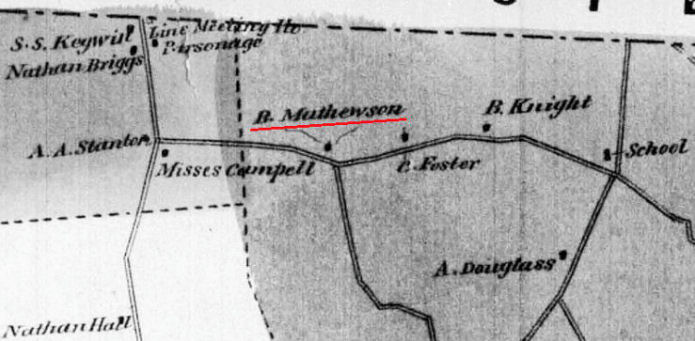
(It is the author’s intention to obtain all of the land evidence records pertinent to Elhanan W. Watson’s Voluntown property. We will update this part of the story once we know what we’re talking about.)
We do not know where Elhanan, his sons, and his elderly parents went in the immediate aftermath of selling the Voluntown property.
Death of Joanna
On May 22, 1858, Joanna “Annie” (Gallop) Watson died at 82 years of age. She was laid to rest in Gallup Cemetery, in Sterling, Connecticut.
The name inscribed on Joanna’s headstone is “Joan” (why, we don’t know). It does specify that she was the wife of Jeffrey Watson. We have not located any record of Joanna’s death, in Connecticut or elsewhere.
The 1860 census recorded 74‐year‐old Jeffrey Watson as a boarder in the household of Henry and Priscilla (Adams) Bennett in nearby Griswold, CT. Jeffrey’s occupation was listed as “farm laborer.”
A Second Marriage
In Voluntown, on December 12, 1861, Jeffrey married for a second time. His bride was Eunice Adams. The record of their marriage provides the following details:
Jeffrey was 75 years old and a farmer. Eunice was 45 years old. Both were then residents of Voluntown; it was a second marriage for each. Eunice’s birthplace was given as Massachusetts (more likely it was Connecticut); Jeffrey’s place of birth was given as West Greenwich, Rhode Island. Jeffrey and Eunice were joined in marriage by Christopher Colgrove, J.P.
For more about Jeffrey Watson’s second wife, please see Eunice’s section in the Appendix.
Death of Jeffrey5 Watson
Jeffrey Watson, age 77, died in Voluntown in 1864. Jeffrey’s death record says he died on January 6th; his gravestone says he died on January 5th. This discrepancy may be due to something as simple as the death occurring the night before it was reported to the town.
Jeffrey was laid to rest next to his first wife, Joanna, in Gallup Cemetery, Sterling, CT. (For a brief description of the Watson burials in Gallup Cemetery, please see that section in the Appendix.)
Eunice survived Jeffrey by little more than a year. She died in Voluntown at age 49 on February 23, 1865. We do not know where she is buried.
Section Summary:
Jeffrey and Joanna Watson had probably six children together, five of whom likely were born in Rhode Island before this family moved to Connecticut.
Jeffrey Watson is first of record in Connecticut in 1820. Census records from 1820 to 1850 place Jeffrey and his family in Voluntown and in Sterling, towns that share a border with Rhode Island.
To the best of our knowledge, Jeffrey Watson never owned property. He didn’t leave behind much of a paper trail. While others in his family left Rhode Island for places much further west, Jeffrey managed only to move a few miles west of the Rhode Island‐Connecticut border. Yet he did something else that mattered greatly: He created a family and helped it to survive. And it looks like he enjoyed a long life with Joanna, the mother of his children.
Joanna (Gallop) Watson died in 1858. Jeffrey Watson died in 1864, following a brief second marriage. Jeffrey and Joanna are buried together in Gallup Cemetery in Sterling, Connecticut.
Elhanan W. Watson (1816‐1903)
Elhanan W.6 Watson was born on June 30, 1816, in West Greenwich, RI.
Elhanan’s birth data comes from his death certificate; no record of his birth is found in West Greenwich. The informant for Elhanan’s death record was Gurdon W. Watson, his grandson, in whose household Elhanan was living at the time of his death. Gurdon gave Elhanan’s father’s name as Jeffrey Watson, but did not name his mother. We think it reasonable to assume that Joanna Gallop was Elhanan’s mother (especially given that Jeffrey Watson Jr.’s death record names his mother as “Annie Gallup”).
We don’t know for certain what Elhanan’s middle initial W stood for. But we surmise that he was named for the Rev. Elhanan Winchester (b. 1751 in Brookline, MA; d. 1797 in Hartford, CT), a Universalist preacher and revivalist. The fact that Elhanan’s grandson Gurdon Watson was given Winchester as his middle name supports this notion.
Elhanan likely grew up in the Voluntown, CT, area, where Jeffrey Watson and family were enumerated in the 1820 census.
First Marriage and Children
Elhanan W. Watson is first of record on January 26, 1840, the date on which he married Ardelia LAMB. They wed not in Ardelia’s hometown of Ledyard, Connecticut, but in the town of Washington on the western side of the state, in Litchfield county. Ardelia was the daughter of William Lamb Jr. (circa 1791‐1847). She was born around 1820, likely in Ledyard, CT. To learn more about Ardelia (Lamb) Watson’s family of origin, click here.
Elhanan and Ardelia made their home in Newtown, CT. But apparently Ardelia traveled back to her hometown, roughly 80 miles east, to give birth to their children.
Elhanan and Ardelia had two sons:
- NEHEMIAH7, born June 10, 1841 in Ledyard, CT
- ELHANAN W. Jr., born circa 1843, most likely in Ledyard, CT
This young family’s life together was tragically short. According to what is carved on her tombstone, “Ardelia, wife of Elhanan W. Watson, died Nov. 26, 1845, Æ 25 years.” Ardelia is buried in Lambtown Cemetery No. 1, a country graveyard on Lambtown Road in Ledyard Center. We wonder if the reason Ardelia’s body lies buried in Lambtown rather than in Newtown is because she came home to birth another child but died in the process, an all‐too‐common occurrence back then.
California Gold Rush
Family lore says that Elhanan W. Watson Sr. was a “Forty‐Niner”– one of thousands who flocked to California in 1849 after gold was discovered there. Supposedly he journeyed to California via ship, taking the sea route around Cape Horn at the southernmost tip of Chile, South America.
Our efforts to trace Elhanan Watson Sr.’s whereabouts during this time period ultimately showed us a gap of less than two years.
We know Elhanan Sr. was in Connecticut as of late March 1849: That’s when he purchased property in Voluntown with his sons’ inheritance money, as described in “Estate Money,” above. Elhanan Sr. set up his parents Jeffrey and Joanna in residence on that land. The 1850 census shows Jeffrey, “Anna,” and Nehemiah living there. (An excerpt of this census listing is shown above.)
Between late March 1849 and the spring of 1851, we find only one record placing him in Connecticut – the 1850 census.
The fact that Elhanan Sr. was enumerated in the 1850 census in Newtown, CT, on August 30th of that year, is no guarantee that he was actually there at the time. That census recorded “The Name of every Person whose usual place of abode on the first day of June, 1850, was in this family.” In 1850 Elhanan Sr. was listed as boarding in the household of Lorain L. Platt and his wife Jane. That his birth place was given as Connecticut instead of Rhode Island implies that someone other than Elhanan himself provided that information.
We know that Forty‐Niners were often enumerated twice – once in their usual place of abode and again in California. That was true for some of Ardelia (Lamb) Watson’s first cousins. More about these Lamb men who were Forty‐Niners can be found in Ardelia (Lamb) Watson’s Family of Origin, in the section entitled “Lamb Men in the California Gold Rush.”
We found an E. W. Watson enumerated in California in 1850; but that man’s place of birth was listed as Ohio.
Elhanan Sr. next shows up definitively in the spring of 1851 when trouble came calling. Land evidence records show that three men from Newtown placed attachment liens on the Voluntown property Elhanan had bought originally with his sons’ estate money. Records pertinent to the liens named Elhanan and Harriet Watson as debtors. Were it not for these property records, we wouldn’t have known that Elhanan Watson Sr. had remarried.
We have concluded, based on other records detailed below, that Elhanan Sr. likely did not participate in the California Gold Rush. The sea route around Cape Horn took upwards of five to six months, in one direction. At most there is a 17‐ to 18‐month time period during which it’s possible he made the journey out to the west coast. It just doesn’t seem probable that he paid for passage out and back, only to spend a short time in California.
A Second Marriage (That Didn’t Endure)
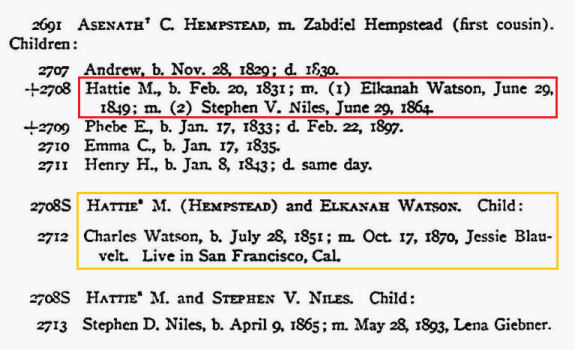
We looked in all the ‘usual places’ online for evidence of Elhanan’s and Harriet’s marriage, but found nothing.
Our suspicion that Harriet’s maiden name was HEMPSTEAD (based on where we find her in 1860) led us to the Genealogy of the descendants of William Chesebrough of Boston, Rehoboth, Mass. Here we found Harriet—“Hattie”—listed as the daughter of first cousins Zabdiel R. and Asenath Caroline (Hempstead) Hempstead. This genealogy mentions both of Harriet’s marriages, first to Elhanan Sr. and second to Stephen V. Niles of Pennsylvania (see image excerpt at right).
Are we surprised to find Elhanan Sr.’s name spelled as Elkanah? Not at all. The given name Elkanah likely was used more widely than Elhanan, though both are obscure Old Testament names.
We do, however, have a problem with the date of their marriage as given in this Chesebrough genealogy. Harriet Hempstead married twice, managing to have both weddings take place on the 29th of June. We are suspicious of repetitive dates like this; they suggest a transcription error from the original data.
Clues From the 1850 Census
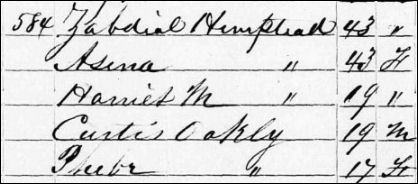
On August 3, 1850, Harriet was first enumerated in her parents’ household in Newtown, CT. A month later, on September 4th, she was enumerated a second time in Newtown, this time as a boarder in the household of James Bennet. Her occupation was listed as carder; apparently she worked in a carding mill or in the carding room of a textile mill. The fact that Harriet was recorded with her maiden name, not once but twice, tells us that she had not yet wed Elhanan Sr.
Considering the birth date of Harriet’s son in late July 1851, we would guess that Elhanan W. Watson Sr. married Harriet in or around October 1850.
The other clue we get from the 1850 census is the name of Harriet’s sister’s husband, who lived with the Hempstead family in that census year. His full name was Edwin Curtis Oakley, but he was known as “E. Curtis” or simply “Curtis.” On January 1, 1848, in Voluntown, CT, Curtis Oakley served as a witness when Elhanan W. Watson Sr. signed the document that bound him legally as guardian of his two young sons, Elhanan Jr. and Nehemiah. Elhanan Sr. likely met Harriet through his friendship with Curtis and Phebe (Hempstead) Oakley.
Big Trouble in Spring of 1851
In 1851, three men from Newtown, Connecticut—William A. Parsons, William B. Glover, and Alva B. Beecher—sued Elhanan and Harriet Watson for unpaid debts.
William A. Parsons, the son of hatter Moses Parsons, was listed as a merchant in the 1850 census; by 1860 his occupation was hatter. On April 19, 1851, Mr. Parsons “recovered judgment against Elhanan W. Watson and Harriet Watson his wife of said Voluntown.” The sum of the Watsons’ debt was $24.52 plus $16.06, the cost of the lawsuit, for a total of $40.58. (Voluntown LE 14:7)
William B. Glover was a merchant. On April 19, 1851, Mr. Glover also “recovered judgment against Elhanan W. Watson and Harriet Watson his wife” for $6.77 plus $16.06, the cost of the lawsuit, for a total of $22.83. (Voluntown LE 14:10)
Alva B. Beecher was a manufacturer of satinet—a “finely woven fabric with a finish resembling satin.” On April 19, 1851, Mr. Beecher, too, “recovered judgment against Elhanan W. Watson and Harriet Watson his wife” for $4.68 plus $16.06, the cost of the lawsuit, for a total of $20.74. (Voluntown LE 14:14)
These judgment sums totalled $84.15, but that was far from the end of it. More than one official went looking for Elhanan and Harriet, racking up travel expenses; and every formal “writ” generated more fees. Apparently Elhanan and wife Harriet were living in Griswold at the time, immediately west of Voluntown.
According to the documents—which are heavy on standardized legal language and light on juicy details—when Constable Thomas F. Edmond demanded payment of these debts, the Watsons refused.
... New London county ... Griswold, May 29th AD 1851
I then made demand of the within named Elhanan W. Watson and Harriet Watson his wife the Debtors in this Execution of the several sums contained thereon and my fees which they neglected and refused to pay (Voluntown LE 14:11)

The 90‐acre Voluntown property that Elhanan Sr. purchased in 1849 with estate money on behalf of his minor sons became the focus of this debt situation.
When Elhanan and his creditors could not agree on an appraiser for the Voluntown property, Winthrop Campbell, a Justice of the Peace in Voluntown, appointed a group of local men—Thaddeus C. Gordon, Henry Wylie, and Allen C. Gordon—to do that job. Their appraisal fees ended up totalling $9.99, another sum added to the Watsons’ growing debt.
On May 30, 1851, each of the three Newtown creditors placed an attachment lien on the Watsons’ Voluntown property.
IF we are correct about Elhanan Watson Sr. marrying Harriet Hempstead in or around October 1850, the debts in question likely were incurred in the months following. We’re guessing that Harriet, who probably had little experience handling money, ran up a sizeable tab with local merchants without her new husband’s knowledge.
The Birth of a Son
Elhanan and Harriet had one child, a son:
- CHARLES ARTHUR7 —“Charlie”— born July 28, 1851, per the Genealogy of the descendants of William Chesebrough of Boston, Rehoboth, Mass. (annotated excerpt shown above).
That birth date likely is correct: Charlie’s listing in the 1900 census notes his month and year of birth as July 1851; and his place of birth as Connecticut. Charlie’s middle name, per his 1884 California voter registration, was Arthur.
The End of The Marriage
Given that Elhanan W. Watson Sr. was married to his third wife by November 1858 and that Harriet and Charlie were living with Harriet’s mother in Newtown in 1860, we may assume that Elhanan and Harriet divorced.
Not one single detail about this short‐lived marriage, or the child it produced, was preserved in Watson family lore. We do wonder if Elhanan Sr. ever provided financial support for Charlie.
To read about Harriet Hempstead’s life after Elhanan Sr., please see her section in the Appendix.
A Third Marriage
On November 21, 1858, Elhanan W. Watson Sr. married Fidelia C. WALKER. They were joined in matrimony by the Rev. Daniel Darrow Lyon (1814‐1895), a Baptist clergyman. Rev. Lyon noted that both bride and groom were “of Franklin” in New London county, CT.
Fidelia was born in 1815 in Foster, RI, the daughter of Joseph WALKER and Alice ANGELL. We find Fidelia in Joseph’s household in 1850 in Plainfield, CT. Thomas V. Walker—Elhanan Sr.’s friend in Voluntown—was her older brother. Elhanan probably knew Fidelia through his association with Thomas.
The 1860 census shows Elhanan and Fidelia living in Central Village, Plainfield, CT, close by Voluntown and Griswold. Elhanan’s occupation was listed as dresser tender: This means he worked at a textile mill, managing the machinery used to weave various fabrics. In 1860, Elhanan’s 19‐year‐old son Nehemiah was living in Rhode Island (where he was enumerated twice, once listed as a weaver and another time as a carder). By the end of that year, Nehemiah Watson would be married.
By 1860, Thomas V. Walker had moved from Voluntown to Pomfret, a couple of towns north of Plainfield. Elhanan’s 16‐year‐old son Elhanan Jr. resided with Thomas and family. Though Elhanan Jr. was listed as a farm laborer, the 1860 census noted also that he had “attended school within the year.”
In the decade that followed, the Civil War (1861‐1865) drew both of Elhanan’s sons into military service; the Homestead Act was passed (1862); Elhanan’s father Jeffrey Watson died (1864) and son Elhanan Jr. got married (April 1870).
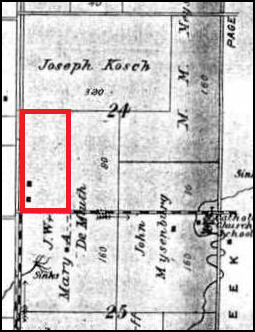
Fourteen Years in Nebraska
In spring of 1870, Fidelia and Elhanan W. Watson Sr. moved to Nebraska.
Elhanan was first of record in Nebraska on April 5, 1870, the day he started his application to settle and farm a parcel of land per the Homestead Act of 1862. On June 29, 1870, he was granted 80 acres in Butler county, this tract defined as the west half of the southwest quarter of Section 24 in Township 16. We’ve drawn a red rectangle on an excerpted portion of a 1906 plat map of Savannah Township to show where Elhanan’s 80 acres were located on the eastern side of the township. (The full plat map can be found at the Nebraska GenWeb website.) Today that property is bounded on the south by Road 41 (State Rte. 64) and on the west by L Road.
All settlers hoping to earn a “patent” to the land they homesteaded were required to improve the property by clearing and cultivating it; and by building and occupying a dwelling house there. After five years, the US government granted them full legal ownership of the property—provided, of course, that the homesteader met all requirements, completed the paperwork, and paid the registration fee.
Elhanan’s improvements to his acreage included building an 18x30 ft. frame house—“one story and a half high, containing 3 rooms, 8 doors [that seems like a lot of doors] and 10 windows.” He had cultivated 50 acres, planted about five acres of trees, dug a well, and built a frame barn.
In late spring of 1877, Elhanan filed his Final Homestead Proof and paid the $14 registration fee. He received the patent for his homestead land on December 10, 1877. At 61 years of age, Elhanan W. Watson Sr. finally held title to his own land.
Other people enumerated in Elhanan and Fidelia’s household in the 1870 and 1880 censuses played parts in the Watsons’ story.
Alice A. Walker (1833‐1911)
Alice Walker was living with Elhanan and Fidelia Watson when the census taker came calling on August 5, 1870.
Alice was Fidelia’s niece, the daughter of Thomas V. and Elisabeth (Whitman) Walker. Per a Butler county history, Alice “went west with her uncle and aunt and located in Nebraska in 1870. In the fall of that year she was united in marriage to Mr. Frederick Irwin, a homesteader in that locality.”
Alice’s brother Capt. Henry A. Walker, then living in Rhode Island, would move to Nebraska later on. We surmise that these two siblings stayed in touch, given how Henry figures into Elhanan and Fidelia’s eventual return to Connecticut.
Minerva E. George (1859‐1935)
In 1880, Minerva E. George, age 21, appears as part of the Watsons’ household, listed as a domestic servant. Minerva’s one‐year‐old daughter Hessie also lived there.
Minerva George was twelve or thirteen years old when she came to Nebraska with her sister Mary Elizabeth “Lizzie” (George) Evans and brother‐in‐law James Evans. Minerva lived with Lizzie and James in Cass, LaPorte county, Indiana, prior to their move to Nebraska around 1872.
James Evans homesteaded his own land in Bone Creek Township, six or seven miles east of where the Watsons lived. James received his land patent not long after Elhanan got his. In 1880, James and family were enumerated in nearby David City, suggesting that he sold his homestead and used the proceeds to move into town.
Family lore has it that Minerva “ran away” from her brother‐in‐law’s farm. We view this fragment of family history as likely pertaining to an earlier time in Minerva’s life (which we discuss here). When Lizzie and James moved from Bone Creek to David City, Minerva was old enough to set off on her own, and probably did.
We don't know where Minerva was living in summer of 1878 when she became pregnant. She gave birth to Hessie in Schuyler, Colfax co., NE, on April 4, 1879. On the 1880 census page where Hessie’s name is written, the line where her father’s birthplace should be listed is blank. It is our understanding that Hessie never knew who her father was.
Somehow, Minerva and her baby daughter came to be part of the Watson household. Two things suggest that the relationship was one of grace and gratitude: Hessie’s middle name was Walker—Fidelia’s maiden name. And when Elhanan and Fidelia moved back to Connecticut, Minerva and Hessie went with them.
Back To Connecticut
Another piece of family lore held that Elhanan W. Watson Sr. “swapped” his land in Nebraska for a farm in the town of Hampton, CT. There is a grain of truth in this lore, though it wasn’t about trading properties. It was more a matter of trading places.
In 1880, the Hampton farm in question was occupied by Samuel J. and Arthusa (Corbin) Brown. Samuel and Arthusa were the parents of Maria Antoinette Brown, wife of Capt. Henry A. Walker ( Alice Walker’s brother). We have not done land evidence research for this Hampton property, so we don’t know if the Browns were owners or tenant farmers.
Antoinette (Brown) Walker’s 1904 obituary gave an account of her life which offered these details: She and her husband Henry “lived in Providence, R. I., for fifteen years. Then they lived at Hampton, Conn., on a farm, and afterwards came west and settled at Schuyler in this state [Nebraska].” Henry Walker’s in‐laws, who were getting on in years, probably needed assistance on the farm. Sometime between 1880 and 1884, a change was deemed necessary; and the Hampton farm was for sale.
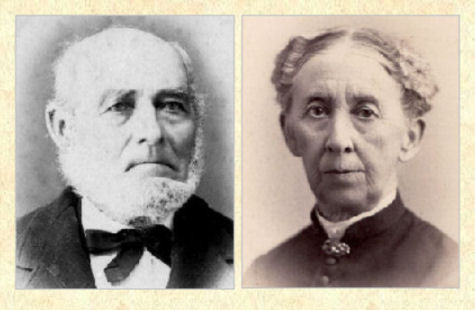
We imagine that news of the Hampton property reached Elhanan’s ears via his wife’s family contacts. Henry Walker likely facilitated the sale of that farm to the Watsons. And, by June of 1885, Henry and his family were residents of Schuyler, Colfax county, Nebraska.
LEFT: Late‐in‐life photos of Fidelia and Elhanan W. Watson Sr.
The plat map of Savannah Township, minus the red rectangle we drew to show the location of Elhanan’s homestead, indicates that by 1906 Joseph Kosch owned the land originally homesteaded by Elhanan. Mr. Kosch was a neighbor: His household immediately follows the Watsons in the 1880 federal census. Mr. Kosch also shows up in the 1885 NE state census in Savannah Township, living close by people surnamed Meysenburg—Elhanan’s old neighbors. There's a decent chance that Elhanan sold his homestead land to Joseph Kosch. The Watsons probably used the proceeds of that sale to buy the Hampton, CT, farm.
Elhanan, Fidelia, Minerva, and Hessie journeyed to New England in or around 1884, when Hessie was five years old. Many years later, Hessie told relatives that, en route from Nebraska to Connecticut, she had a chance to see Sioux Indian leader Sitting Bull when he was touring with Buffalo Bill Cody’s Wild West show. Since Sitting Bull’s time with the Wild West show is said to have been in 1885, perhaps that’s when Elhanan and company moved back to Connecticut.
The Farm in Hampton, CT
We discovered a very old photo of Fidelia and Elhanan Sr. standing proudly in front of their Hampton farmhouse. The composite image below includes that image next to a photo (taken by the author) of the very same house.
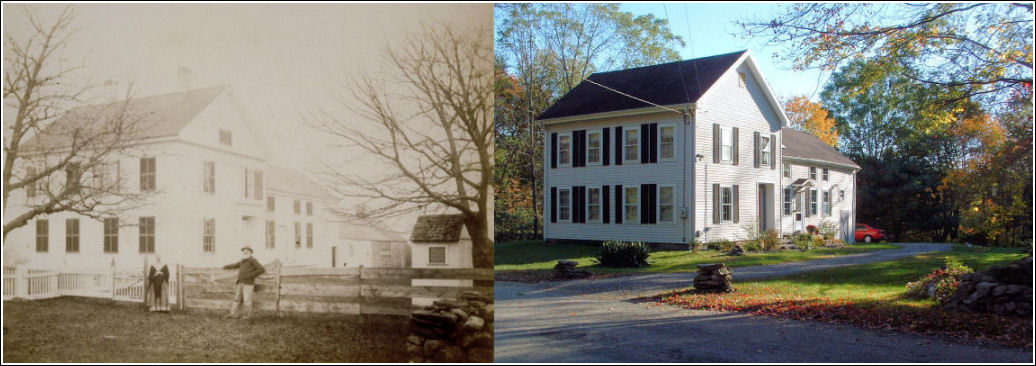
A real estate website has described the lovely old home on South Brook Road in Hampton as a “handsome 1779 colonial with [an] 1840’s addition.” When the Watsons lived there, it was an example of a New England Connected Farm, with “big house, little house, back house, barn.” The barn, and the back house that connected it to the little house, were gone by the time we arrived with our camera in 2006.
The original digital image of E.W. Watson family, Hampton, courtesy of the Connecticut Historical Society Museum, can be enlarged for better viewing. Here is their description for this photo:
“Elderly bearded man and elderly woman wearing a shawl stand near a picket fence and a board fence, in front of a two-story Greek revival house with two chimneys. Additions at the back connect to outbuildings and a barn. A small building and part of a stone wall are at the right. Two trees on either side are possibly fruit trees.”
The “small building” at the right of the old photo housed the hand pump for the well. The pump was still there in 2002, minus its little house; by 2006, it was gone, too.
Elhanan’s Final Years
In the decade that followed the Watsons’ return to Connecticut, Minerva George married Elhanan Sr.’s grandson Gurdon W. Watson and welcomed three children. And, sadly, Elhanan Jr., the younger of Elhanan Sr.’s two sons with his first wife, passed away in 1888 in Pomfret, CT.
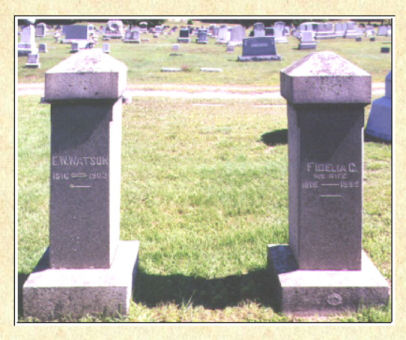
We learn from Fidelia Watson’s last will and testament, dated May 29, 1889, that she, not Elhanan, owned the Hampton farm. Fidelia named her “beloved husband” as executor of her estate, and left everything to him.
We wonder if Elhanan, having learned from his experience with Harriet, made Fidelia the owner of this property as a means of protecting their assets. Certainly it shows that Fidelia, to whom Elhanan was married the longest, had his absolute trust. Elhanan may also have wanted to provide for Fidelia in case he died first.
Fidelia C. (Walker) Watson died in Hampton on October 10, 1895, at around 80 years of age. She was laid to rest in Section M, Evergreen Cemetery, in the village of Moosup, Plainfield, Windham county, CT.
The property Elhanan inherited was described as a “Home Farm of 126 acres with buildings,” valued at $1500. Part of the acreage was in Hampton, part in the town of Chaplin—which is unsurprising, given that the Watsons’ farmhouse was within spitting distance of Chaplin. The title for this property passed from Fidelia to Elhanan in late May 1896. We don’t know how long it remained in Elhanan’s possession.
By 1900, Elhanan was living with Gurdon and Minerva (George) Watson and their family on Willetts Avenue in New London, CT. That is where Elhanan died on September 6, 1903, aged 87. Elhanan W. Watson Sr. was buried next to Fidelia in Evergreen Cemetery.
It is touching and significant that Minerva cared for Elhanan at the end of his life. He and Fidelia gave her a home when she was a vulnerable young woman with an out‐of‐wedlock child. She repaid his kindness in the best possible way.
ABOVE RIGHT: A photo, taken by the author, of the monuments marking the graves of “E. W. Watson” and “Fidelia C., his wife” in Evergreen Cemetery, Moosup, CT.
Section Summary:
Elhanan W. Watson Sr., born in Rhode Island in 1816, spent most of his life in Connecticut.
Elhanan married, first, Ardelia LAMB. Ardelia died at age 25, leaving him with two young sons, Nehemiah and Elhanan Jr.
Some family lore says that Elhanan was a “Forty‐Niner”– one of many who went to California in 1849 after gold was discovered there. We have reason to doubt this.
Elhanan Sr. married, second, Harriet M. HEMPSTEAD, with whom he had a son, Charles. Serious financial problems threatened this marriage early on, likely related to Harriet spending money without Elhanan’s knowledge. This marriage did not endure.
Elhanan married, third, Fidelia C. WALKER. In 1870, Elhanan and Fidelia Watson went to Nebraska, where they homesteaded land in Savannah Township, Butler county. In due course, Elhanan received a patent for that land from the US government. After fourteen or so years in Nebraska, they returned to Connecticut, bringing with them a young woman, Minerva E. George, and Minerva’s young daughter, Hessie.
Fidelia and Elhanan bought a farm in Hampton, CT. Fidelia was the owner of record for this property; when she died in 1895, Elhanan inherited it. Elhanan spent his last years living with his grandson Gurdon W. Watson and Gurdon’s wife—Minerva George. Elhanan W. Watson Sr. died in 1903 at Gurdon and Minerva’s home in New London, CT.
Sources for Elhanan W. Watson Sr.
Elhanan Winchester: Preacher and Traveler by John Emory Hoar, 1903; The Brookline (Massachusetts) Historical Society, accessed online 30 December 2022.
Ancestry.com. Genealogical sketch of the Lamb family [database on-line]. Provo, UT: Ancestry.com Operations Inc., 2004. Original data: Lamb, Fred W., Genealogical sketch of the Lamb family. Manchester, N.H.: Printed by the J.B. Clarke Co., 1903.
Ancestry.com Genealogy of the descendants of William Chesebrough of Boston, Rehoboth, Mass. [database on‐line]. Provo, UT: Ancestry.com Operations Inc, 2005. Original data: Wildey, Anna Chesebrough, Genealogy of the descendants of William Chesebrough of Boston, Rehoboth, Mass (1903): the founder and first white settler of Stonington, Conn., born 1594, in or near Boston, England, and died 1667, Stonington, Conn. He sailed from Cowes, England, in good ship “Arbella” (of Gov. John Winthrop’s Massachusetts Bay Colony), March 29, 1630, and arrived in Salem, Mass., New England, America, June 14, 1630.
Ancestry.com California, U.S., Voter Registers, 1866‐1898 [database on‐line]. Provo, UT: Ancestry.com Operations, Inc., 2011. Original data: California State Library; Sacramento, California; Great Registers, 1866‐1898; Collection Number: 4‐2A; CSL Roll Number: 2; FHL Roll Number: 976447
Records detailing the lawsuits against Elhanan W. and Harriet Watson, and the attachment liens against the Voluntown property, are detailed in Voluntown Land Evidence Book 14, pages 7‐14. Town Clerk’s Office, Voluntown Town Hall, 115 Main St., Voluntown, CT 06384
The Newtown Bee newspaper for Friday, 24 August 1888, page 3, mentions Alva B. Beecher, William B. Glover, and William A. Parsons in a lengthy column titled “Old Academicians.” Accessed at Newspapers.com on 11 June 2021.
We obtained our definition for satinet from Wikipedia.org
“E S Niles” (Elias S. Niles) listed in U.S., Indexed County Land Ownership Maps, 1860‐1918 for Wayne county, PA, 1872. Ancestry.com. U.S., Indexed County Land Ownership Maps, 1860-1918 [database on‐line]. Provo, UT: Ancestry.com Operations, Inc., 2010. Original data: Various publishers of County Land Ownership Atlases. Microfilmed by the Library of Congress, Washington, D.C.
“New York, New York City Marriage Records, 1829‐1938,” database at FamilySearch.org (https://www.familysearch.org/ark:/61903/1:1:24MX-HPP : 15 June 2023), Charles N. Watson [sic] and Jessie D. Blaurdt [sic], 1870.
Sanford Carlton E., 1911. Thomas Sanford, the Emigrant to New England: Ancestry, Life, and Descendants, 1632‐4, Volume 1.
Stephen V. Niles’ wife Sarah Sanford and their family are mentioned on page 710.
Bulletin of the Standard Oil Company of California, Volume 8, page 13; published in 1920 by the Standard Oil Company of California. Original from the University of Illinois at Urbana‐Champaign; digitized 11 October 2022; accessed via Google Books on 3 May 2023.
National Society Daughters of the American Revolution. DAR Library, 1776 D. Street NW, Washington, DC 20006‐5392. Connecticut Genealogical Records Committee, 1978; Series 1, Vol. 178, pg. 81: A record of the marriage of Elhanan W. Watson and Fidelia C. Walker, “both of Franklin,” CT, on 21 Nov 1858, by Rev. D. D. Lyons [sic, should be Lyon], 1843‐1892. We obtained our copy from the DAR in July 2005.
Job description for Dresser Tender found at website job-descriptions.org/dresser-tender
The image of the Savannah Township plat map comes from the 1906 Plat Book of Butler county, NE, as posted on the Nebraska GenWeb website. We obtained our copy on 25 May 2005.
Homestead Act (1862) Act of May 20, 1862 (Homestead Act), Public Law 37‐64 (12 STAT 392); 20 May 1862; Enrolled Acts and Resolutions of Congress, 1789 ‐ 2011; General Records of the United States Government, Record Group 11; National Archives Building, Washington, DC.
Details about the life of Alice A. (Walker) (Irwin) Andrews were published in the Memorial and Biographical Record and Illustrated Compendium of Biography Containing a Compendium of Local Biography ... of Butler, Polk, Seward, York and Fillmore Counties, Nebraska (Chicago: G.A. Ogle, 1899). Found via the usgennet.org website, beginning on this page, and continuing on the next.
Hessie George’s full name was included on the WWI draft registration of her first husband, Willis Elisha Wade. Ancestry.com U.S., World War I Draft Registration Cards, 1917‐1918 [database on‐line]. Provo, UT: Ancestry.com Operations, Inc., 2005. Original data: United States, Selective Service System. World War I Selective Service System Draft Registration Cards, 1917‐1918. Washington, D.C.: National Archives and Records Administration. M1509, 4,582 rolls. Imaged from Family History Library microfilm.
Obituary for Antoinette (Brown) Walker was found on page 5 of The Frontier newspaper (O’Neill City, Holt co., NE) for Thursday, 29 December 1904. Accessed at Newspapers.com on 26 June 2023.
We obtained our digital copy of “E.W. Watson family, Hampton” in September 2006 from the Connecticut Historical Society Museum, which seems to have morphed into The Connecticut Museum of Culture and History. Clark Collection: Accession number X.2000.1.287; Photo CD number 2801; img0004.pcd
Nehemiah Watson (1841‐1921)
Nehemiah7 Watson was born on June 10, 1841, in Lambtown, Ledyard, New London county, Connecticut. He was the older of two sons born to Elhanan W. Watson Sr. and his wife Ardelia Lamb.
In 1850, young Nehemiah was living in Voluntown, CT, with his paternal grandparents Jeffrey and Joanna (Gallop) Watson. It’s possible that’s where he spent most of his childhood years after the death of his mother in 1845.
Nehemiah Watson shows up twice in the 1860 census in Rhode Island. He was enumerated first on June 8th, living with the family of Jesse W. Richmond in the village of Arcadia, in Richmond. On July 9th, Nehemiah was enumerated a second time, then living with the Josiah Kingman family in Exeter. We don’t know why Nehemiah was moving around that summer. We do know that he was living with relatives in June 1860 and likely met his future wife, Mary Ellen, while residing in Richmond.
Jesse W. Richmond—apparently the W stood for Watson—was the son of Joseph Richmond and his wife Sarah Watson, daughter of Samuel4 #26 Watson. In other words, Jesse W. Richmond was a first cousin to Elhanan W. Watson Sr., Nehemiah’s father.
Caleb S. and Catharine (Matteson) LEWIS and their family also lived in Arcadia. In 1860 Caleb’s household was enumerated on the page just before Jesse W. Richmond’s. The oldest of Caleb’s and Catharine’s children was daughter Mary Ellen, born September 2, 1843, in Exeter, RI. By the end of that year, she would be Nehemiah Watson’s wife.
Marriage and Children

On December 25, 1860, in Hope Valley, Hopkinton, RI, Nehemiah Watson and Mary Ellen Lewis were joined in marriage by the Rev. Mr. Austin. Mary Ellen was seventeen years old at the time of their marriage; Nehemiah was nineteen.
We obtained the December 25th marriage date and the name of the clergyman from Nehemiah’s Civil War pension file. The announcement of the Watson‐Lewis marriage in Rhode Island’s Providence Daily Post (11 January 1861, pg. 2; shown at right) states the wedding date as December 30th. Since the pension file data is a primary source, i.e., provided by Nehemiah himself, we will prefer the Christmas date.
The clergyman who performed Nehemiah’s and Mary Ellen’s wedding ceremony was probably Rev. Stanton Sheffield Austin, a Methodist minister who lived in Hopkinton, RI, and is found there in the 1860 census.
George W. Richmond, Nehemiah’s second cousin, was a witness to the marriage ceremony.
Nehemiah Watson and Mary Ellen Lewis may have been third cousins. If Mary Ellen’s paternal grandmother, Waity L. (Young) Lewis, was the child of Benjamin Young Jr. and his wife Waity Hill, that would mean Nehemiah and Mary Ellen shared a set of great‐great‐grandparents: Benjamin Young Sr. and his wife Rebeckah, whose daughter Abiah married Samuel4 #26 Watson.
Nehemiah and Mary Ellen had twelve children:
- GURDON WINCHESTER8, born November 5, 1861, in Exeter, RI; died August 29, 1946, in Bridgeport, CT.
On July 19, 1886, in Thompson, CT, Gurdon wed Minerva E. GEORGE (1859‐1935). Gurdon and Minerva had three children: Elmer Ellsworth Watson (1887‐1942); Viella A. Watson (1889‐1961); and Grace Louise Watson (1894‐1940). - ELMER E., born April 9, 1864; died May 10, 1865. He is buried in Wood River Cemetery, Richmond, RI.
- FRANK A., born February 13, 1866, in Richmond, RI; died before 1875.
- SUSAN ARDELIA, born May 16, 1868, in Arcadia, Richmond, RI; died January 7, 1922, in New London, CT. She is buried in Jordan Cemetery, Waterford, CT.
Ardelia—she went by her middle name—married Frank DeWitt RAWSON (1859‐1915) on May 30, 1889, in Thompson, CT. They had one child, daughter Mildred Ardelia Rawson (1902‐1926). - HARRIET CATHERINE, born October 4, 1869, in Exeter, RI; died April 10, 1958, in Groton, CT. She is buried in Elm Grove Cemetery, Mystic, CT.
On November 29, 1899, in Stonington, CT, “Hattie” married Frederick Wesley TOURJEE (1872‐1951). Hattie and Fred had five children: John Braman Tourjee (1901‐1981); William Allen Tourjee (1902‐1999); Mabel Gladys Tourjee (1904‐1969); Elsie May Tourjee (July 1, 1906–April 26, 1907); and Beatrice Blanche Tourjee (1909‐1991). - PERMELIA, born May 15, 1871, in Westerly, RI; died August 10, 1877, in Arcadia, Richmond, RI.
- IRA C., born August 13, 1873, in Connecticut (likely Voluntown); died November 2, 1943, in New London, CT. He is buried in Jordan Cemetery, Waterford, CT.
Ira married Olive Nellie ORMSBY (1878‐1963), with whom he had children. We chronicled this disastrous marriage in The Saga of Ira Watson and Nellie Ormsby. Long story short: Not only did Nellie divorce Ira; she moved out‐of‐state and changed their kids’ surname from WATSON to WILSON. - LULA B., born January 14, 1875; died April 10, 1877, in Arcadia, Richmond, RI.
- EDNA IDELLA, born March 14, 1878, in Hopkinton, RI (probably Hope Valley); died May 28, 1898, in New London, CT. We believe she is buried in Jordan Cemetery, Waterford, CT.
- GEORGIA ANNA, born July 24, 1880, probably in Moosup, Plainfield, CT; died June 10, 1961, in Chatham county, GA (likely in Savannah, where she lived with one of her daughters). She is buried in Hillcrest Abbey East Cemetery in Savannah, Chatham co., GA.
Georgia Anna—called “Georgie,” which merged with her middle name into Georgiana—married Henry H. GAVITT (1875‐1948) on September 1, 1898, in New London, CT. Georgie and Henry had four children: Henry L. Gavitt (March 30, 1899–April 3, 1899); Mary Isabelle Gavitt (February 6, 1901–August 14, 1907); Elizabeth C. Gavitt (1906‐1982); and Eleanor Louise Gavitt (1911‐1966). - WALTER ALLEN, born March 9, 1882, in Wilsonville, Thompson, CT; died Nov. 6, 1917, in New London, CT.
He is buried in Jordan Cemetery, Waterford, CT.
On Nov. 3, 1905, in Groton, CT, Walter married Mary Ernestine LEWIS (1889‐1938). Walter and Mary had three children: Floyd Allen Watson (1906‐1988); Clarence Ellsworth Watson (April 1, 1908–August 20, 1908); and Clara Louise Watson (1909‐1981). - ERNEST EVERETT, born December 7, 1885, in North Grosvenor Dale, Thompson, CT; died April 22, 1929 in New London, CT. He is buried in Elm Grove Cemetery, Mystic, CT. On January 5, 1906*, in Groton, CT, Everett—he went by his middle name—married Minnie I. LAMB (b. circa 1865–d. after 1931).
The dissolution of Walter’s marriage is worth a few words here: By late June 1909, Mary had secured a divorce “on the grounds of intolerable cruelty,” as reported on June 26, 1909, in the New London newspaper The Day. Their daughter Clara was born slightly more than a week later, on July 4, 1909. It is sobering to think of Mary pursuing a divorce while pregnant.
Mary (Lewis) Watson went on to marry two more times. Her second husband was Frank W. Caswell, with whom Mary had four daughters and a son. After Frank’s death in 1924, Mary married John E. Hoy, with whom she had a daughter that died in infancy. Mary E. (Lewis) (Watson) (Caswell) Hoy died in Mystic, CT, on June 9, 1938. She is buried in Elm Grove Cemetery in Mystic.
Minnie Lamb was a first cousin to Everett’s father. Her father, Henry A. Lamb, was the younger brother of Ardelia Lamb, Nehemiah Watson’s mother.
Minnie lied about her age pretty consistently. She was five years old in 1870 and fifteen in 1880; yet her age was given as 27 when she and Everett wed in 1906*. For his part, Everett inflated his own age by a couple of years every time the census taker came around, reducing the age gap between him and Minnie in a mutual fiction.
*1. The Groton, CT, record of this marriage says that Everett and Minnie wed on January 5, 1905.
2. The Connecticut State Library’s index entry for this marriage gives a different date, January 3, 1906. The CSL’s indexed record also preserved Minnie’s surname as LAWK, which is a mistranscription of LAMB.
3. The New London, CT, newspaper The Day, in its January 1907 edition listing all the births, marriages, and deaths for the prior year, noted the marriage of Everett E. Watson and Minnie I. Lamb on January 5, 1906.
We decided to go with what the newspaper printed—January 5, 1906—for the following reasons:
Mary Ellen (Lewis) Watson’s death in August 1905 probably propelled both Walter and Everett out of their widowed father’s house. Walter was married by November 1905. Everett likely got married the following year, in 1906; and two of the three dates given are for January 5th.
We invite you to read The Watson Family’s Greatest Hits, our compilation of newspaper clippings; family stories; and an assortment of old photos—but mostly Watson men behaving badly. Nehemiah Watson’s children and some of their wives are the main feature of this piece.
Civil War Service
Nehemiah Watson was living in Arcadia, Richmond, RI, when he enlisted in the Union Army. He mustered into Company K, 9th Regiment Rhode Island Infantry on May 25, 1862, in Providence, RI. The 9th RI Regiment was sent to Washington, DC, to guard it against attack by Confederate forces. Company K was stationed at Fort Baker, in southeast DC. At the end of his 90‐day term, Nehemiah was honorably discharged in Providence, RI, on September 2, 1862. He did no other military service afterwards.
On December 21, 1899, Nehemiah filed for a government pension on the basis of his brief Civil War service. The wartime injury that earned him a pension was a double inguinal hernia. “The rupture of his right side was incurred in the service aforesaid, in the year 1862, and was caused by a strain incurred while engaged under orders in unloading a camp wagon at Fort Baker.” The “alleged rupture of the left side” occurred at a later time. “Said disabilities were not in any manner due to vicious habits.” Nehemiah managed the problem of his hernias by wearing a double truss.
Per a document in his pension file, Nehemiah’s “personal description at enlistment” was as follows: Height – 6 ft. 1 in.; Complexion – light; Color of eyes – brown; Color of hair – black; Occupation – farmer.
Twenty Years In Rhode Island
Lists of the places where Nehemiah Watson lived after his Civil War service are included in his pension documents, as are the names of his children and their birth dates. Nehemiah had little trouble remembering his sons’ and daughters’ birthdays. His recall of the places they lived generally aligns with other sources.
In 1907, Nehemiah wrote up his answer to the question “That [your] several places of residence since leaving the service have been as follows:”
Hope Valley, R.I.; Moosup, Conn.; Webster, Mass.; and Mystic, Conn.
In 1916, when asked essentially the same question, Nehemiah replied:
Arcadia, R.I., to 1877; N. Grosvenor Dale, Conn., to 1887; New London, Conn., to 1895; and Mystic, Conn., since 1895.
The inclusion of Webster, MA, in Nehemiah’s 1907 list is a surprise. Perhaps he worked in Webster at a time when he was living in the village of Wilsonville (where son Walter was born) in Thompson, CT, right along the Connecticut‐Massachusetts border.
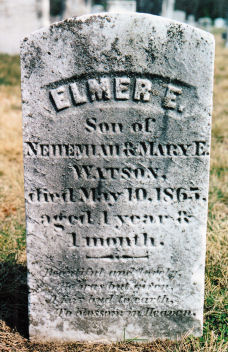
A RI military census, dated June 1863, lists Nehemiah Watson as a resident of Hopkinton; likely he was living in Hope Valley. After that, up to about 1868‐69, Nehemiah and family lived mainly in Arcadia, a mill village situated in both the towns of Richmond and Exeter in Washington county, RI. Nehemiah may have found employment at the local mill.
The birth place of a number of the children is specified as Richmond; we can guess that they lived on that side of the village. Given that eldest child Gurdon was born in Exeter in November 1861, perhaps the family home was located on the other side at the time.
Nehemiah appears twice in the 1865 RI state census: Once in Hope Valley, Hopkinton, with his wife “Ellen” and three‐year‐old son Gurdon; and again in East Greenwich, living in the household of Stephen A. and Mary A. Lewis. What was Nehemiah doing in East Greenwich in 1865? That census offers no clue.
In the Hope Valley listing, Nehemiah’s occupation was recorded as machinist. In East Greenwich, he was listed as a mechanic. This tells us that Nehemiah had moved beyond the traditional jobs he held in a textile mill (weaver; carder) in 1860.
Thirteen‐month‐old Elmer E. Watson died on May 10, 1865—which is why he’s missing from Nehemiah’s family listing in the 1865 state census (which recorded its inhabitants relative to the 1st of June). Little Elmer was laid to rest in Wood River Cemetery in Richmond, RI, in the same plot where his maternal grandparents, Caleb S. and Catherine S. (Matteson) Lewis are buried. (The photo of Elmer E. Watson’s gravestone, shown at right, was taken in August 2001 by the author.)
Apparently the Watsons were back in Richmond, RI, between 1865 and 1868, where their third and fourth children were born—Frank in February 1866; and Ardelia in May 1868. Daughter Hattie was born in Exeter, RI, in October 1869, so the family may have moved once again.
Nehemiah didn’t list Westerly, RI, in his list of places lived. But that’s where we find him in the 1870 census, along with wife Mary Ellen and children Gurdon, Frank, Ardelia, and Hattie. Nehemiah’s occupation was noted as “works in machine shop.” Oddly, his birth place was listed as New York. Did one of the kids answer the door when the census taker came calling?
The Watsons were still in Westerly in May 1871 when daughter Permelia was born.
The 1875 RI state census shows that they went back to Richmond where, presumably, daughter Lula B. was born in January of that year.
Son Frank, who appeared in the 1870 federal census as a four‐year‐old, is missing from this state census; we assume that he died in the interim. We don’t know why baby Lula’s name was left off the Watson family listing in 1875.
On April 23, 1877, Nehemiah Watson of Arcadia, Rhode Island, filed a patent application for his “Improvement in Pipe‐Cutting Machines.” He was granted Patent # 190798 on May 15th of that year.
Loss of Two Daughters in 1877
Nehemiah and Mary Ellen sustained a terrible loss to their family when their two youngest daughters, Permelia and Lula, died within four months of each other.
The Wood River Advertiser newspaper, Hope Valley, RI, reported:
“DIED. At Arcadia, April 10th, LULU, infant daughter of Nehemiah Watson.”
“Lulu, a little daughter of Nehemiah Watson of Arcadia, upset a cup of hot tea on its neck and breast, on Tuesday of last week from the effects of which it died the next evening.”
Tragedy struck again exactly four months later. Per the Wood River Advertiser newspaper:
“DIED. At Arcadia, August 10th, PERMILLA, daughter of Nehemiah Watson, aged 6 years.” No explanation for Permelia’s death was given.
We searched in vain for Lula’s and Permelia’s death records at the Richmond, RI, Town Hall. They were not found in records for 1877, nor for the years immediately before and after.
By March 14, 1878, when daughter Edna Idella was born, the Watsons were again living in Hopkinton, probably in Hope Valley. They were still there in early 1879. We know this from the pencil inscription on the inside of the back of a violin Nehemiah crafted: “Maid [sic] By Nehemiah Watson / Feb 10th 1879 / Hope Valley. (More about this violin can be found here.)
Return to Connecticut
Windham County
The 1880 census records Nehemiah and his family as residents of Plainfield, CT. They had moved a distance of about fourteen miles, as the crow flies, northwest of Arcadia, RI. Given that Nehemiah listed Moosup, CT—a village in Plainfield—as one of the places he’d lived, that’s probably where they were when daughter Georgia Anna was born on July 24, 1880.
On March 9, 1882, son Walter was born in a different part of Connecticut.
We found Walter A. Watson’s place of birth listed his death record (New London, CT, City Hall: Deaths, Vol. 8B). The index entry gave Walter’s birth place as “Willimantic, Connecticut.” His actual death record said “Williamsville, Connecticut.” While there is a Williamsville in Killingly, CT, we found no birth record for Walter in Killingly. We strongly suspect that Walter Watson was, in fact, born in Wilsonville, one of the villages of Thompson, CT, where Nehemiah and family lived for a number of years.
Ernest Everett Watson, the youngest of Nehemiah and Mary Ellen’s children, was born in Thompson, CT, on December 7, 1885. Everett’s 1929 obituary named his birth place as North Grosvenor Dale, another village in Thompson.
In Thompson, CT, in the years that followed, two of Nehemiah and Mary Ellen’s children got married; and two grandchildren were born.
- On July 19, 1886, Gurdon W. Watson married Minerva E. George. Both were residents of Thompson when they wed. The town clerk, who was a justice of the peace, performed the marriage ceremony.
Remember Minerva? She and her daughter Hessie traveled from Nebraska to Connecticut, circa 1884, with Nehemiah’s father Elhanan W. Watson Sr. - On April 26, 1887, Elmer Ellsworth Watson was born in North Grosvenor Dale, Thompson, CT—Gurdon and Minerva’s first child together.
- Gurdon and Minerva’s second child, daughter Viella A. Watson, also was born in North Grosvenor Dale, on March 19, 1889.
- On May 30, 1889, Ardelia Watson married Frank DeWitt Rawson, son of Nathan and Hannah (Miller) Rawson. Frank was a native of Thompson, CT.
New London
We find Nehemiah in the city directory for New London, CT, as early as 1891. It’s possible he moved his family from Thompson to the city of New London the previous year, given that it takes time to collect and then publish a city directory. (We located an 1890 New London city directory at Ancestry.com; but it was missing the two pages where any WATSON names would have been listed—hence, our lack of info.)
Nehemiah Watson’s first home in New London appears to have been at 45 Willetts Avenue. That address correlates to his listings in the 1891 and 1892 city directories, as well as in an October 1892 article in the New London newspaper The Day listing the names and addresses of newly registered voters that included Nehemiah.
By 1894, Nehemiah and family were living at 1 Wightman, on a side street off Willetts Ave. This is pretty much where they stayed until their next move, around 1899‐1900. We learned that the Watsons were renters, not owners, from an 1896 article in The Day that mentions 1 Wightman Street being struck by lightning.
Even with Gurdon and Ardelia married, Nehemiah and Mary Ellen still had plenty of children living at home: Hattie; Ira; Idella; Georgie; Walter; and Everett.
We know that Nehemiah Watson worked as a machinist. The New London city directories tell us where he worked—at the Brown Cotton Gin Company. B. C. Gin Co. was located “on Pequot Avenue, just below Fort Trumbull.” In our article The Saga of Ira Watson and Nellie Ormsby, we described the Brown Cotton Gin shop:
“Brown Cotton Gin Company” sounds like a place that mills cotton, but in fact it was a shop that made machine parts for cotton gins. Nehemiah Watson and his sons Gurdon and Ira worked there. Eventually Brown Cotton Gin evolved into the Babcock Printing Press Company, switching from making cotton gin machinery to manufacturing printing press components.
Notable events during the eight or so years Nehemiah and his family lived in New London include three marriages, a death, and lightning striking the house where they lived.
- Gurdon and Minerva Watson, who remained behind in North Grosvenor Dale for a few years, moved with their family to New London around 1893‐94. As mentioned above, Gurdon went to work for B. C. Gin Co. as a machinist.
- In June 1896, Ira Watson got married to Nellie Ormsby.
- In September 1896, the Watson family home was struck by lightning.
ANOTHER HOUSE STRUCK
The house No. 1 Wightman street, owned by Ronald Mussel and occupied by Nehemiah Watson, was struck by lightning Thursday night during the electric storm. The bolt came down the side of the house until it found an open window, which it entered, and then it zigzagged around and left by another window without harming in the least either of the three inmates of the house.
They were of course frightened but the trouble was over and the danger was past before they really knew what had happened. The damage to the house was trifling.
(Excerpt from the article “Lightning’s Queer Pranks in New London Houses” in the New London newspaper The Day for Friday, Sept. 4, 1896, page 7.)
- Daughter Edna Idella died on May 28, 1898.
MISS EDNA I. WATSON DEAD
Amiable Young Lady Passed Away at Her Home This Morning
Edna Idella Watson died this morning at her home on Wightman court after an illness of a few weeks.
Deceased was a well‐known young lady of many amiable traits of character, whose death will be sincerely regretted by a wide circle of friends. Her sickness was not considered of a very serious nature until within the past two or three days, when it took an alarming form, and in spite of all that medical science could do for her she succumbed to the disease.
Miss Watson was the daughter of Mr. and Mrs. Nehemiah Watson. She was 20 years and 2 months old.
(The Day newspaper, New London, CT; Sat., May 28, 1898, pg. 7)We learn from another of The Day’s death notices for Edna Idella that her family had moved from No. 1 Wightman Street to No. 3. Her death record also cited 3 Wightman St. as place of death.
WATSON—In New London, May 28, 1898, Edna Idella, daughter of Nehemiah and Mary E. Watson, aged 20 years and 2 months.
Funeral from the residence of her parents, 3 Wightman street, on Tuesday, 31st inst., at 2 p. m. Relatives and friends are invited to attend.
(The Day newspaper, New London, CT; Mon., May 30, 1898, pg. 6)Edna Idella Watson’s cause of death was Cerebro‐Spinal Meningitis, duration 3 weeks. Though the burial records available at Jordan Cemetery in Waterford, CT, don’t extend back to 1898, we suspect that Edna Idella was laid to rest in Lot #390, Avenue I, the 12‐grave lot that Nehemiah purchased in Jordan Cemetery.
- Daughter Georgia Anna—“Georgie”—got married on September 1, 1898. She and Henry H. Gavitt tied the knot at the Hotel Royal in New London.
Henry and two brothers owned this hotel, having inherited the family business following their parents’s deaths. By August 1899, Henry’s brother Thomas K. Gavitt had bought Henry’s share of the Gavitt Brothers firm. Henry stayed on in his brothers’ employ to manage the hotel.
The local newspaper provided details about the happy couple’s wedding and honeymoon:
The ceremony took place in the hotel parlor, which was elaborately decorated for the occasion, and it was witnessed by a large number of invited guests. Rev. Richard Povey officiated.
The bride and groom left for New York on the boat and will visit a number of southern cities before returning.
(The Day newspaper, New London, CT; Fri., Sep. 2, 1898, pg. 8)Rev. Richard Povey, associated with the Federal Street Methodist Episcopal Church in New London, was the same clergyman who officiated at Edna Idella Watson’s funeral three months earlier.
The Day ran a brief item about Henry and Georgie’s return from their honeymoon:
Henry H. Gavitt and wife have arrived home from their wedding tour to Washington. They are temporarily stopping with Mrs. Gavitt’s mother on Willets avenue before going to housekeeping.
(The Day newspaper, New London, CT; Wed., Sep. 7, 1898, pg. 7)“Going to housekeeping” means establishing one’s own household.
There is a subtle clue in the above newspaper item: It mentions that “Mrs. Gavitt’s mother”—Mary Ellen Watson—was living on Willetts Avenue in New London, three months after the death of daughter Edna Idella at their Wightman Street home. By 1899 Gurdon Watson’s residence was listed as Willetts Avenue in the city directory, while Nehemiah’s remained listed as Wightman. Did Mary Ellen live with son Gurdon for a time after the tragic loss of Edna Idella?
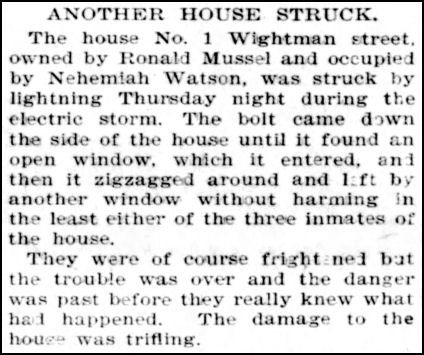
West Mystic
Sometime in 1899, Nehemiah Watson moved to West Mystic, a village in the town of Groton. That was the address he gave for himself on December 21, 1899, when he submitted his Declaration for Invalid Pension to the US government’s Pension Office. We expect he got there sooner than December, though, considering that his daughter Hattie got married in November 1899—not in New London, but on the Stonington side of Mystic. Nehemiah boarded at Burrows House in West Mystic before getting his own place—a fact gleaned from the 1900 Westerly, RI, city directory (whose coverage included Pawcatuck, Stonington, and Mystic in CT).
On June 5, 1900, the federal census recorded Nehemiah, Mary Ellen, 18‐year‐old Walter and 14‐year‐old Everett living together in “Groton Town” in a rental house.
Mary Ellen (Lewis) Watson died in Mystic, CT, on August 8, 1905. Her cause of death was noted as Cancer of Stomach, duration 3 months; her age at death was 61 years, 11 months, 5 days. We expect, as with daughter Edna Idella, that Mary Ellen was laid to rest in Lot #390, Avenue I, in Jordan Cemetery, Waterford, CT—in the 12‐grave lot owned by Nehemiah.
Within five months of Mary Ellen’s death, the remaining Watson children—sons Walter and Everett—were married. One wonders if they thought it a good idea to get away from the Old Man.
The 1910 census shows Nehemiah part of a household consisting of Frank and Ardelia (Watson) Rawson; their 7‐year‐old daughter Mildred Rawson; and Ira Watson’s daughters Nellie G., age 11, and Ethel M., age 4. Their house, a rental, was located on Orchard Street in West Mystic.
In The Saga of Ira Watson and Nellie Ormsby we wrote about Ira farming his children out to relatives early in 1909 after Nellie left him and initiated divorce proceedings. In November 1911, Nellie regained custody of her children and took them back with her to Rhode Island.
Frank and Ardelia Rawson moved to Mystic around 1905 or early in 1906. We base this assumption on Frank’s obituary in The Day (dated January 30, 1915), which noted that “he had been a resident of Mystic for about nine years.”
Nehemiah’s Final Years
Ardelia’s husband Frank D. Rawson died on January 29, 1915. With Ira’s daughters living elsewhere since late 1911, this left only Nehemiah, Ardelia, and her daughter Mildred living at 22 Orchard Street.
In February 1917, a Connecticut military census captured 75‐year‐old Nehemiah Watson’s answers to the question “Can you do any of the following”—
Ride a horse? no
Handle a team? yes
Drive an automobile? no
Ride a motorcycle? no
Understand telegraphy? no
Operate a wireless? no
Any experience with a steam engine? yes
Any experience with electrical machinery? some
Handle a boat, power or sail? yes
Any experience in simple coastwise navigation? no
Any experience with High Speed Marine Gasoline Engines? no
Are you a good swimmer? no
Later in 1917 Nehemiah Watson had a “shock.” In those days, the word shock in that context meant the person had suffered a stroke. On Thursday, August 22, 1918, Nehemiah was “taken by his daughter”—this had to be Ardelia— to Fitch’s Home for Soldiers in Noroton Heights, Darien, CT. A pair of newspaper items reported on this development:
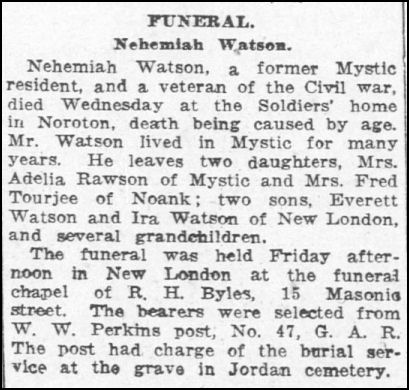
Nehemiah Watson, a Civil war veteran and who has been sick at his home on Orchard street for over a year, was on Thursday taken by his daughter to the Noroton home for soldiers. Mr. Watson anticipates a good time spending his last days with old comrades.
(Norwich Bulletin newspaper, Norwich, CT; Fri., August 23, 1918, pg. 2)
Admitted to Soldiers’ Home
Nehemiah Watson, one of Mystic’s well known veterans of the Civil War, has been admitted to the Soldiers’ home at Noroton. He sustained a shock about a year ago and his health has not been good since.
(The Day newspaper, New London, CT; Sat., Aug. 24, 1918, pg. 8)
In 1920, Nehemiah Watson was enumerated at the Soldiers’ Home in Darien, one of 246 inmates. He died there on July 27, 1921.
Primary cause of death was Arterio Sclerosis, duration three years. The secondary cause was Cerebral Hemorrhage, duration four days—Nehemiah had another stroke, this one fatal. Eighty years old when he died, Nehemiah outlived his wife and six of his twelve children.
Ardelia handled her father’s funeral arrangements. Nehemiah was buried in the lot he owned in Jordan Cemetery, Waterford, CT. (We wonder why Nehemiah’s obituary didn’t mention Gurdon and Georgie among the surviving family members.)
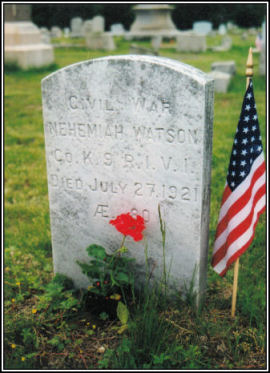
Nehemiah Watson’s Lot
We learned from the Jordan Cemetery Association that Nehemiah Watson was the owner of Lot #390, Avenue I. It’s a 20 x 20 ft. lot, with six graves in front, six in the back. Five burials were recorded for this lot since 1915: son Walter A. Watson in 1917; Nehemiah himself in 1921; daughter Ardelia (Watson) Rawson in 1922; granddaughter Mildred (Rawson) Grills in 1926; and son Ira C. Watson in 1943. Other burials almost certainly include Nehemiah's wife Mary Ellen (Lewis) Watson (1905); and their daughter Edna Idella Watson (1898).
Nehemiah’s burial is one of only two in that lot marked with a gravestone. The other one marks the grave of Nehemiah’s grandaughter “Myldred”—Ardelia’s daughter Mildred (Rawson) Grills, who died at age 24 in 1926.
In the image shown below, we have labeled the graves for which we were given information. The two marked with red asterisks are tentative assignments for Nehemiah’s wife Mary Ellen and for their daughter Edna Idella.
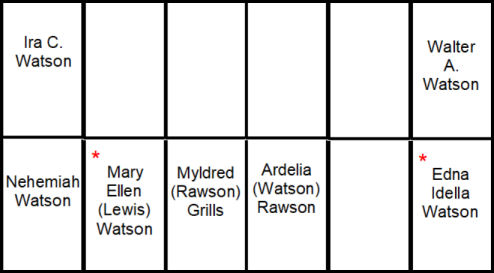
Many years ago, our uncle sought to know where Mary Ellen was buried. He told us that a Jordan Cemetery official went with him to Lot #390, Avenue I, and probed the grave to the immediate right of Nehemiah’s. The probe hit something solid at the expected level, and the official agreed that this was likely the grave where Mary Ellen was laid to rest.
Given that Edna Idella Watson’s burial in 1898 would have been the first in this lot, we have tentatively assigned her to the front right corner grave.
So what about those five unused graves? Someone, perhaps Gurdon Watson, must have assumed ownership of this lot after Nehemiah passed away in 1921, given that the last burial was Ira Watson’s in November 1943. We know that Gurdon had his own lot in Jordan Cemetery, likely purchased when his wife Minerva died in 1935. We have no knowledge of any part of Nehemiah Watson’s lot being sold to others. If that were so, the people at Jordan Cemetery, who helped us look up the interments in Nehemiah’s lot, should have had records regarding any transfers of ownership.
Violin‐Making
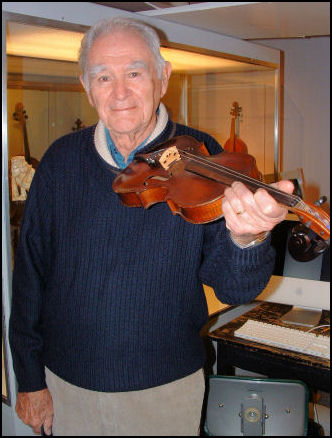
Nehemiah Watson made violins, likely as a hobby. We don’t know how many he produced over his lifetime.
At least two are still in existence. One is in the Yale (University) Collection of Musical Instruments museum in New Haven, CT. The other, crafted by Nehemiah in 1909 in Mystic, CT, was sold via an online auction house following the death of its owner in 2019. We don’t know where that violin went.
The violin that Yale holds is one Nehemiah made in 1879 when he was living in Rhode Island. His inscription, written in pencil and attached to the inside back of this violin, says, “Maid [sic] By Nehemiah Watson / Feb 10th 1879 / Hope Valley.” Images of this violin can be viewed at the Yale Collection of Musical Instruments web site. It was a gift to the Collection, made by Miss Elizabeth F. Gardner in 1975.
Oddly, Yale indexes this item at the web site as “Mystic, Connecticut, 1879.” The proper attribution should be Hope Valley, RI, 1879. Did Yale University purchase that other extant violin, made in Mystic, via the online auction? That might explain this confusion.
We had the pleasure of visiting Yale’s Musical Instruments museum on October 10, 2005. Curator Susan Thompson brought out Nehemiah Watson’s violin for us to see and touch. She described Nehemiah’s violin as “homely.” This sentiment was in keeping with its description in the 1985 exhibit catalog A Yankee Lyre : Musical Instruments by American Makers —
The roughly cut scroll and f‐holes of this instrument, its lack of symmetry in outline, and the clumsiness of the purfling, especially at the corners, all indicate the work of one who, if not an amateur, very likely represents a late representative of the venerable Yankee tradition of “jack‐of‐at‐least‐several‐trades.” The rustic appearance of this violin would tempt one to associate it with some aspect of the “folk fiddling” tradition.... However, even in remote and rural areas, often through the offices of the growing mail order houses, European factory‐made instruments became ever more widely available in the later 19th century.
“Factory‐made instruments” suggests that Nehemiah created this violin from a kit. It’s worth noting a somewhat impressive aspect of this violin: Its rib—the narrow piece of wood used to join the front to the back—is one continuous strip. The more common construction method uses two equal‐length strips of wood that meet at the top and the bottom of the instrument.
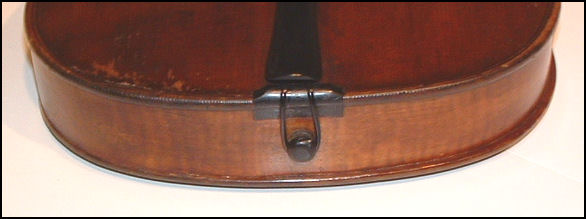
Watson family lore supports the idea that Nehemiah was part of the folk fiddling tradition referenced by A Yankee Lyre. His son Gurdon also made violins. Gurdon occasionally took his personal fiddle, which he called “the Old Black Crow,” down to the local bar in New London and played it there for the entertainment of the patrons. The payoff was free beers, a descendant told us. Gurdon’s son Elmer didn’t make violins, but he did play—and he called his instrument a fiddle.
Left: A close‐up view of the bottom of Nehemiah Watson’s 1879 violin, showing the seamless rib. Above right: A great‐grandson of Nehemiah Watson holds his violin at the Yale Musical Instruments museum on October 10, 2005.
Section Summary:
Nehemiah Watson, eldest son of Elhanan W. and Ardelia (LAMB) Watson, was born in Ledyard, CT, in 1841. When he was four years old, his mother died. A portion of Nehemiah’s childhood was spent in the household of his paternal grandparents, Jeffrey and Annie (Gallop) Watson, in Voluntown, CT.
As a young man, Nehemiah went to Rhode Island to live and work. He started out in traditional jobs at textile mills but soon advanced to employment as a machinist. When he enlisted into the US Army early in the Civil War, however, Nehemiah described himself as a farmer. Nehemiah Watson served with Company K, 9th Regiment Rhode Island Infantry between May and September 1862.
On Christmas Day in 1860, Nehemiah married Mary Ellen LEWIS, the daughter of Caleb S. and Catherine (Matteson) Lewis. They had a dozen children together, five of whom died before the age of 21.
In 1877 the US Patent Office granted a patent to Nehemiah Watson for his “Improvement in Pipe‐Cutting Machines.” He is known to have crafted violins by hand, two of which are still in existence.
During the twenty years Nehemiah and his family lived in Rhode Island, they resided mainly in the villages of Arcadia, in Richmond, and Hope Valley, in Hopkinton. By 1880, Nehemiah and his family had moved to Connecticut, where they remained. They lived primarily in three places: the village of North Grosvenor Dale, in Thompson; the city of New London; and the village of West Mystic, in Groton.
Mary Ellen (Lewis) Watson died in Mystic in 1905. Sometime in 1917, Nehemiah suffered a stroke. He continued living in Mystic with the help of his daughter Ardelia. In August 1918, Ardelia took him to live in Darien, CT, at Fitch’s Home for Soldiers. That is where he died in 1921, at age 80.
Sources for Nehemiah Watson
Nehemiah Watson (Pvt., Co. K, 9th RI Inf., Civil War), pension application no. 1,241,661, certificate no. 1,005,047, Case Files of Approved Pension Applications..., 1861-1934; Civil War and Later Pension Files; Department of Veterans Affairs, Record Group 15; National Archives, Washington, D.C.
Information regarding the 9th Rhode Island Volunteer Infantry Regiment was obtained from a variety of sources, including The Civil War in the East website.
Data from the Wood River Advertiser newspaper, Hope Valley, RI—published weekly on Thursdays—was obtained at the Historical Archives of the Langworthy Public Library, 24 Spring St., Hope Valley, RI 02832.
Death notice for “LULU, infant daughter of Nehemiah Watson” (Lula B. Watson) was found in the edition for April 19, 1877, pg. 2, col. 5.
Death notice for “PERMILLA, daughter of Nehemiah Watson” (Permelia Watson) was found in the edition for August 23, 1877, pg. 2, col. 5.
Marriage record for Gurdon W. Watson and Minerva E. George obtained at Thompson [CT] Town Hall: Index to Vital Statistics, Vol. 4, page 340; certificate page C‐190. Accessed (by the author, in person) on 12 June 2013.
Birth record for Elmer Ellsworth Watson obtained at Thompson [CT] Town Hall: Index to Vital Statistics, Vol. 4, page 152; certificate page C‐172. Accessed (by the author, in person) on 12 June 2013.
Birth record for Viella A. Watson obtained at Thompson [CT] Town Hall: Index to Vital Statistics, Vol. 4, page 168; certificate page C‐159. Accessed (by the author, in person) on 12 June 2013.
Marriage record for Susan Ardelia Watson and Frank DeWitt Rawson—Thompson [CT] Town Hall: Index to Vital Statistics, Vol. 4, page 348; certificate page C‐97. Accessed (by the author, in person) on 12 June 2013.
A certified copy of the Medical Certificate of Death for Mary Ellen (Lewis) Watson, dated 3 August 2005, was obtained by the author from Groton, CT, Town Clerk Barbara Tarbox.
Hurd, D. Hamilton. 1882. History of New London County Connecticut : With Biographical Sketches of Many of Its Pioneers and Prominent Men. Philadelphia: J. W. Lewis. Chapter XVIII, Part B, Biographical Sketches, includes Israel F. Brown, founder of the Brown Cotton Gin Co.
Nehemiah Watson’s obituary was found in the Norwich, CT, newspaper Norwich Bulletin for July 30, 1921, pg. 5. Image provided by the Connecticut State Library, Hartford, CT; and made available online by the Library of Congress. A digital image of the newspaper page can be found at this Persistent Link.
On July 27, 2010, we called the Jordan Cemetery Association and spoke with Mr. Robert Prentice, who provided us with info on Nehemiah Watson’s lot.
Jordan Cemetery Association, Inc., 240 Boston Post Rd., Waterford, CT 06385 (860) 442‐3893
Renouf, Nicholas. 1985. A Yankee Lyre : Musical Instruments by American Makers ; an Exhibition of Instruments by 19th Century American Makers with Supplementary Exhibits of Graphics, Books, and Furniture. New Haven, Conn: Yale University. Information about a violin made by Nehemiah Watson in 1879 is found on pages 4‐6.
Minerva E. George (1859‐1935)
We believe that Minerva E. George was the daughter of Harris GEORGE and his wife Mary Catherine WARD of Indiana. This assertion is based on census research and a process of elimination, because there is no other documentary evidence to tell us about Minerva’s family of origin.
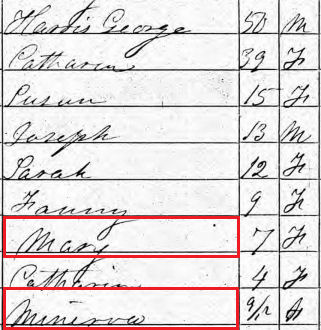
Harris George was born circa 1810 in North Carolina. Mary Catherine Ward (who went by her middle name) was born circa 1821 in Virginia. This info was gleaned from census data.
Harris and Catherine married in Crawford county, Indiana, on November 13, 1839. They were enumerated in Leavenworth, Crawford co., IN, in the 1840 census. In 1850 they resided in Deer Creek, Perry co., IN. By 1860, the George family was living in Cannelton, Perry co., IN, which is where they stayed.
Minerva was one of nine children—eight daughters and a son—born to Harris and Catherine George.
Minerva’s early history is inextricably tied to that of her older sister Lizzie.
Lizzie’s full name was Mary Elizabeth. She appears in the 1860 census simply as “Mary,” age 7. The youngest of the George children in that census year was nine‐month‐old Minerva.
We believe that Minerva E. George was born on August 14, 1859, probably in Cannelton, Perry county, IN.
Until Minerva married Gurdon Watson, her age as given in census records is reasonably accurate. After marriage, she represented herself as having been born in 1861, the same year as Gurdon.
On April 1, 1869, in Porter county, Indiana, Lizzie George married James EVANS (1847‐1933), the son of Edward Evans (1819‐1877) and Mary Snavely (1821‐1851). The 1870 census shows James, Lizzie, and their infant daughter Rosa Belle living in Wanatah, LaPorte county, IN. The fourth person in that household was 10‐year‐old “Minervia” George. Only one name separates James’ and Lizzie’s household from that of Edward Evans, James’ father (excerpt shown below, far right).
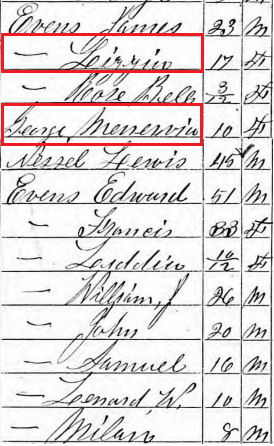
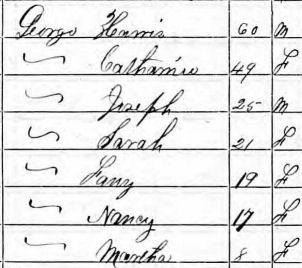
The 1870 enumeration of Harris George’s household (excerpt shown at near right) confirms that neither Lizzie nor Minerva were living there.
We note that two more children—Nancy and Martha—were born to the George family in the years following the 1860 census. Daughter Catherine, four years old in 1860, is missing by 1870; likely she died young. Daughter Susan, who married John Frankey in 1866, was enumerated in 1870 on the page preceding her parents’ listing.
There is no way that Nancy George was 17 years old in 1870—she was born after 1860. In 1880 she was listed as 21 years old, another inconsistent number.
In the years following, more family members would be lost. “Mrs. Harris George” was said to be “lying very sick at her residence,” per the Cannelton Reporter (Troy township, Perry co., IN; Nov. 4, 1876, pg. 3). Son Joseph got married in 1873, had two children, and died in 1878. Daughter Susan’s husband had a different wife by 1880, suggesting that Susan had passed away. By 1880, the George household consisted of Harris and his daughters Sarah, Fanny, Nancy, and “Mattie” (Martha). Harris George’s death in late 1880 was reported with a single line in an area newspaper : “Harris George, one of the oldest settlers in Cannelton, died last week.” (Daily Journal, Evansville, IN; Mon., November 29, 1880, pg. 2)
How did young Minerva end up 250 miles away from her parents’ home? Why was she living with her sister and brother‐in‐law in Wanatah? What an odd situation!
This is where that fragment of family lore we mentioned earlier—about how Minerva supposedly “ran away” from her brother‐in‐law’s farm in Nebraska—comes into play.
This lore had been used within the family to explain how Minerva came to live with Fidelia and Elhanan Watson in Nebraska. It also linked Minerva’s pregnancy with her departure from James and Lizzie’s home: Was Hessie’s father a hired hand on the Evans’ farm? Did James rape Minerva? Was <gasp> Elhanan the man who fathered Minerva’s child?
We now believe this business of running away pertains to Lizzie and Minerva leaving their childhood home, not to Minerva’s leaving her sister and brother‐in‐law’s Nebraska home.
It’s not that hard to imagine Lizzie running away. A resourceful teenager can put a lot of miles between herself and whatever she’s trying to escape. We have found references to Harris George being the constable for Cannelton. Perhaps Lizzie took issue with how her father laid down the law at home.
Lizzie was sixteen years old when she wed James Evans. Assuming she met James after running away, Lizzie might have been only fifteen when she left home. Minerva was eight years younger than Lizzie. How did she, as a 7 or 8‐year‐old child, get involved with Lizzie’s leaving?
Several possible scenarios spring to mind. In no particular order:
- Minerva caught Lizzie preparing to run away and begged to come with her. Lizzie agreed.
- Minerva caught Lizzie preparing to run away and threatened to tell their parents. Lizzie dragged Minerva with her to avoid being found out.
- Something or someone was threatening the wellbeing of one or both girls—sexual abuse, perhaps. Lizzie may have tried to protect herself and her little sister by leaving the ‘scene of the crime.’
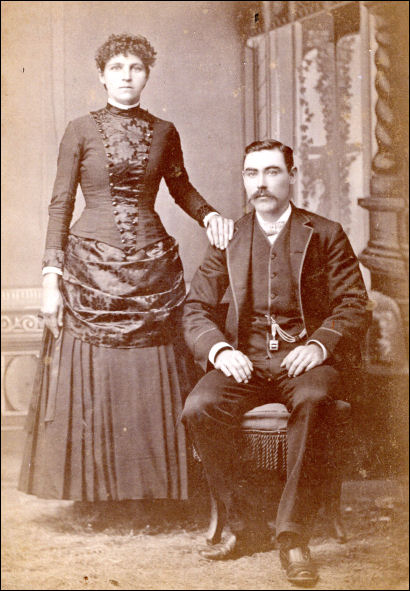
We have found nothing to suggest that Lizzie or Minerva ever communicated with their parents or siblings again. Interestingly, when asked by census takers about the birth places of their parents, both women said Indiana. We know from census data that their father was born in North Carolina, their mother in Virginia. Did Lizzie and Minerva not know the facts of their parents’ birth places? Were their responses meant to conceal those facts? (Or are we simply wrong about who their parents were?)
We had hoped to confirm the names of Minerva’s parents from her death record—and maybe even learn what her middle initial E stood for. Gurdon Watson was the informant; surely he would know these things, right?
No such luck. He gave Minerva’s birth place as Schuyler, Nebraska, which is incorrect. That is where Minerva gave birth to Hessie. The sections for Minerva’s father and mother (name and birth place) contained one answer, dittoed all the way down: Not Given. Grief, or memory problems (Gurdon was 75 years old), or a genuine lack of information may have caused him to answer these questions thus. Perhaps Gurdon was honoring some pledge to Minerva that he would never divulge her secret. In one last tip of his hat to his wife’s practice of lying about her age, Gurdon said she was born in 1863, whittling four years off her age at death.
If Lizzie’s and Minerva’s aim was not to be found by their family of origin, they appear to have succeeded. And they remained family for each other. After Minerva left Nebraska with Elhanan and Fidelia Watson to live in Connecticut, she stayed in touch with Lizzie and her family. Minerva’s daughter Hessie, who died in 1970, left behind some Evans family letters and an album containing lovely old photos of Lizzie, James, and the Evans children.
We have not yet seen the record of Lizzie’s death in Omaha, NE, in 1930. But we remain hopeful that her parents are named in that document.
Photo shown at right: Minerva E. George and Gurdon W. Watson, circa 1886.
Hessie W. (George) (Wade) Hammond (1879‐1970)
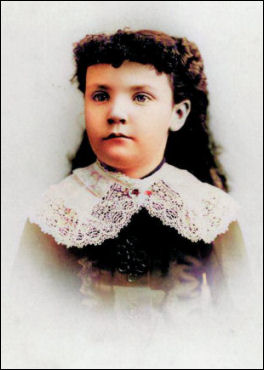
Our story here would not be complete without paying tribute to the life of Hessie George, Minerva (George) Watson’s eldest child.
The identity of Hessie’s father remains unknown. And Hessie had no children, removing the possibility of tracing her paternal side via descendant DNA.
And yet: Because of the memories she shared and the marvelous old photos she preserved, we have a clearer, more colorful insight into the Watson family history. We also have Hessie’s second husband, John Hammond, to thank for filling in some of the gaps.
As mentioned earlier, Hessie Walker George was born April 4, 1879, in Schuyler, Colfax county, Nebraska. She was five years old, or thereabouts, when she traveled with her mother Minerva, Elhanan W. Watson Sr., and his wife Fidelia, to live in Connecticut.
We “colorized” this portrait photo of Hessie as a girl at MyHeritage.com. We recall hearing that Hessie had red hair (or a lot of red in her hair) when she was young.
Minerva George and Gurdon Watson were both residents of Thompson, CT, when they wed in July 1886. It’s our impression that they remained in the North Grosvenor Dale area of Thompson until around 1893‐94. We assume, then, that Hessie grew up in North Grosvenor Dale and went to school there.
Per the 1940 census, Hessie completed the eighth grade—an accomplishment that happened around 1893, when she would have been fourteen years old. That timing corresponds to Gurdon’s and Minerva’s move to New London, CT. This transition may have given rise to a scrap of family lore about Gurdon Watson having “thrown Hessie out of the house.” More likely, Hessie was old enough to move on to other things, while her mother, stepfather, and half‐siblings left North Grosvenor Dale and went to New London to live. If she went with them, she probably didn’t stay too long.
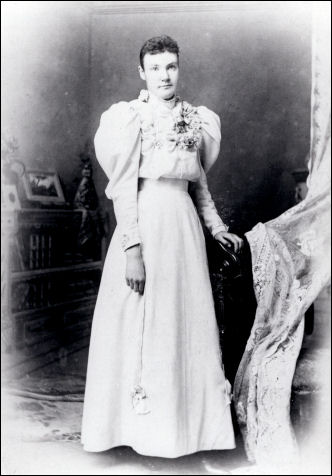
We have an idea of what Hessie may have done when her school days were over, based on the fact that she got married in the town of Chaplin, CT.
Elhanan W. Watson Sr. and his wife Fidelia lived in Hampton, CT, within a stone’s throw of the Chaplin town line and very near the house on South Brook Street that Willis and Hessie would later own.
Hessie was “very close to Elhanan,” we once were told. Certainly Hessie knew him from when she and Minerva lived with the Watsons in Nebraska, and when all of them journeyed from there to Connecticut. This is why we think it’s possible—likely, even—that Hessie lived for a time with Elhanan and Fidelia in Hampton.
The Watsons, in their 70s by that time, probably needed assistance. If Hessie stayed with them, she may have arrived to help out before Fidelia Watson’s death in October 1895. Elhanan’s eventual move to New London, to live with Gurdon and Minerva Watson, probably happened when Hessie was about to be married.
Hessie was nineteen when she married Willis Elisha Wade (1878‐1920) on October 26, 1898, in Chaplin, CT. This photo of Hessie, shown at left, may have been her wedding portrait.
Willis was the son of Jared Wade (1843‐1919) and his wife Mary Elizabeth Perkins (1844‐1894). Willis grew up in Hampton, CT, and was educated there.
In 1900 Willis and Hessie were living in Agawam, Hampden county, Massachusetts. An item from the Stafford Springs, CT, newspaper The Press for August 30, 1900, mentioned that “Mr. and Mrs. Willis Wade of Feeding Hills, Mass., have been the guests of Jared Wade.” Feeding Hills is a village in Agawam. Willis’s occupation was listed in that year’s census as “farm laborer.” We think he was working for a Massachusetts tobacco farming operation, based on notes and photos from Hessie’s photo album.
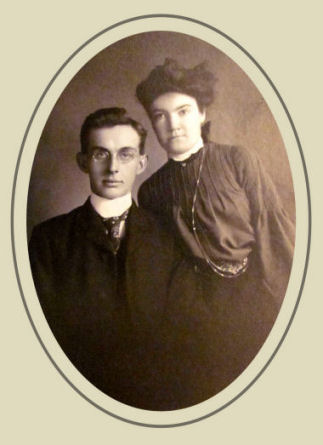
Probably by November 1907, Willis and Hessie were living in Hampton. A New London newspaper item mentioned that “Miss Viella Watson went Saturday afternoon to Hampton for a visit with her sister, Mrs. Willis Wade.” — The Day, New London, CT; November 25, 1907, pg. 6
In 1910, Hessie and Willis were enumerated in Clark’s Corner, Hampton, CT. Willis now worked as a “section hand” for the railroad. This would have been the New York, New Haven and Hartford Railroad Co., which ran through Hampton and had a couple of stations in town. The railroad tracks crossed into Hampton from neighboring Chaplin very close to Willis’s and Hessie’s house on South Brook Street.
Family tradition holds that the Hampton house in which Willis and Hessie Wade lived was built prior to the American Revolution. Old maps of Hampton show that location being occupied by “S. Robinson” (1856) and “D. Shippee” (1869).
“S. Robinson” was Sally (Burnham) Robinson, second wife of Abel Robinson, an early resident of Clark’s Corner. Widowed in 1830, Sally continued to live in the home that she’d shared with Abel. She died in 1859.
Darius Shippee’s residency in Hampton ranged from at least 1854 through 1901, the year he died. Based on who his neighbors were, it appears that Darius lived in the former Robinson house from 1860 onwards.
That old house still stands today; but in 2002 it was significantly remodeled and enlarged. Its original siding was red cedar shakes. The front doorstep was a rectangular stone whose top surface had a shallow concavity caused by countless years of foot traffic. An ancient metal boot scraper, embedded in another stone, stood to the right of the doorstep.
This photo of Willis and Hessie Wade, at right, was generously shared with us by Ancestry.com member “HighRider163,” who has Wade ancestry.
The 1920 census lists Willis Wade’s occupation as “farmer.” He and Hessie had someone boarding with them that year: Twenty‐eight‐year‐old John I. Hammond (who was fast approaching his 29th birthday). John Hammond’s presence in the Wade household in 1920 appears related to an existing friendship with Willis and Hessie.
John was a Hampton native: He was born in the house across the street from the train station in the Rawson section of town.
In 1907, when he was sixteen, John began working for farmer Frank Martin, who lived on the Chaplin side of Clark’s Corner (Hampton Remembers, pg. 27). This employment lasted for at least a couple of years.
The local gossip column in the Norwich Bulletin noted three occasions in 1912 when John was a guest at Willis Wade’s house. Two of those items referred to John as being “of East Hartford.” In 1917, when John visited the Wades over the Fourth of July, he was “of Mansfield.”
By late April 1920, Willis Wade was sick. He went to St. Joseph Hospital (now Windham Hospital) in Willimantic, CT, on April 28, 1920, for treatment. He died there on May 2nd. Willis was buried in North Cemetery (also known as Hammond Cemetery) in Hampton.
The Norwich Bulletin newspaper published this tribute:
“The late Willis E. Wade was born July 28, 1878, the son of Jared and Mary Perkins Wade. He was educated in the Hampton public school. Nearly all his life was spent in Hampton and Clark’s Corner. He was united in marriage with Miss Hessie I. Wade [sic], twenty‐one years ago. She survives him, as do his sister, Mrs. Henry Humes and brother, James Wade.
“Mr. Wade was of a sunny, cheery disposition, beloved by those who knew him. He was ready to help his neighbors and friends whenever they were in need of assistance.
“When friends learned of his serious illness and that he must undergo an operation, it was hoped he would gain rapidly, but those hopes were doomed to disappointment. The funeral was held Wednesday at the family house, at two o’clock. Rev. Charles G. Fogg officiated. Mrs. William Pearl sang Nearer My God to Thee [and] Some Time We’ll Know and Understand.
“The floral tributes were beautiful.
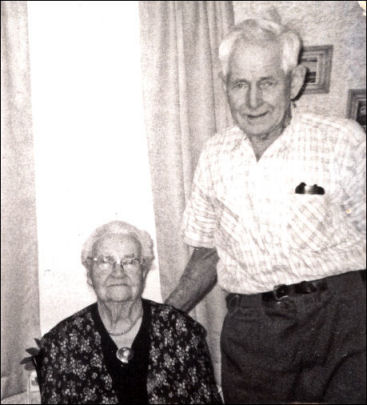
“The bearers were Howard Perkins, Gurdon Humes, James Wade, Elmer Watson, John Hammond and Charles Larrow. A large number of mourning relatives and friends attended the funeral.”
— Norwich Bulletin, Norwich, CT; May 13, 1920, pg. 9
Hessie’s nephew Elmer Watson Jr. recalled it was around the time of Will Wade’s death that John Hammond was “taken on as hired help” on the Wade farm.
Over time, this working relationship grew into something more permanent: On December 14, 1924, Hessie Wade and John Hammond got married in Hampton. Hessie was 45 years old at the time; John was 33. They continued farming there at Clark’s Corner until old age caught up with them.
Photo at right: Hessie and John, circa 1969. The occasion was probably a celebration of Hessie’s 90th birthday.
John milked their several cows by hand. Hessie made her own butter from the cream skimmed off the top of each day’s milk buckets. They kept a vegetable garden and tended a flock of chickens.
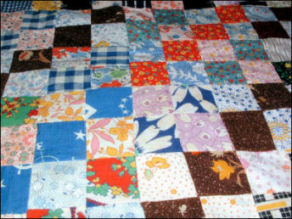
Like most farming women, Hessie canned and preserved much of the food they grew, keeping those items (sometimes for many years) in their dirt‐floor “cold cellar.” All of their cooking was done over four grates atop a wood stove in the kitchen. That stove also provided heat in the winter.
John planted potatoes in their five‐acre lot which Elmer Watson Jr., as a boy, helped to harvest. For several years in the 1930s John and Hessie raised large flocks of turkeys to sell.
Hessie pieced quilt tops from flour sack fabric that came in a variety of colorful prints in the 1930s. The photo at left shows one of Hessie’s quilt tops, made using 1.5‐inch finished squares of flour sack fabrics. Hessie also braided rugs by hand.
For many years Hessie belonged to the Grange in Hampton. And she always entered cakes to be judged at the annual Grange fair. Elmer Watson Jr. recalled: “She would tell us (with her nose stuck up in the air) that ‘I always won the first prize with my chocolate cake.’” Hessie kept her blue ribbons pinned to the calendar in the kitchen.
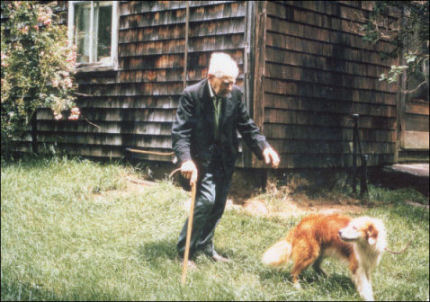
Hessie (George) (Wade) Hammond suffered a heart attack in January of 1970. She died in Putnam, CT (probably at Day Kimball Hospital), on January 14, 1970, at age 90. Hessie was laid to rest in North Cemetery in Hampton, next to her first husband Willis Wade.
With only his dogs for company, John Hammond lived for another seven or so years in the old house. The photo at left shows John, circa 1973, with his dog Prince in the front yard.
Following a fall that likely sent him to the hospital, John went to live in a nursing home where he spent his last few years.
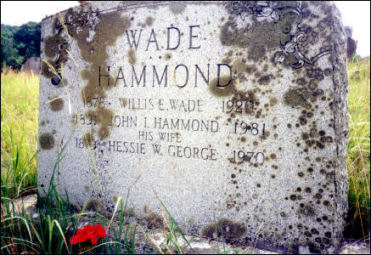
John Irving Hammond died in Killingly, CT, on April 16, 1981. He was buried alongside Hessie and Willis in North Cemetery in Hampton, where they share a large headstone.
Willis Wade’s name is listed first; he died fifty years before Hessie did. But there is no reference to the fact that he was Hessie’s first husband. John’s name comes next, with the words his wife preceding the final name on this stone, Hessie’s.
Hessie was married to Willis for over 21 years. She and John were married for 45 years. John was friends with both of them before Willis died. The inscription on their shared headstone seems just right.
You can find a few more stories about Hessie and the Hampton farm in The Watson Family’s Greatest Hits.
Elhanan W. Watson Jr. (1844‐1888)
Elhanan W.7 Watson Jr. was born around March of 1844, likely in Ledyard, New London county, Connecticut. He was the younger of two sons born to Elhanan W. and Ardelia (Lamb) Watson. Elhanan Jr.’s mother died in November 1845, when he was still a toddler.
The Excruciating Details:
We have found no formal birth record for Elhanan W. Watson Jr.
Our analysis of available records points to his birth occurring between March 18th and April 15th in 1844. A document from Elhanan Jr.’s Civil War pension file recorded his age at enlistment, on August 6, 1862, as 18 years, 5 months – which translates to a birth date of March 6, 1844. We therefore have settled on a circa birth date of March 1844.
Elhanan Jr.’s 1870 marriage record notes his place of birth as Groton, CT. We think it probable that, like his older brother Nehemiah, Elhanan Jr. was born in Ledyard which, until 1836, was part of Groton. Their mother was from Ledyard – the village of Lambtown, specifically. At least one other Watson researcher has concluded that Ardelia likely returned to her hometown to give birth.
In the Killingly, CT, birth records for two of Elhanan Jr.’s children, the father’s place of birth is given as Lebanon, CT.
Unless Elhanan Jr. himself went to Killingly Town Hall to report the births of his children, those records aren’t quite as reliable as the record of his marriage, for which he himself likely was the informant.
The informant for these birth records may have been Elhanan Jr.’s wife Melissa. How could she have gotten it wrong? We imagine she remembered that her husband’s birthplace began with Le… Instead of Ledyard, she landed on the only other Connecticut place name with a similar beginning sound. Indeed, there are only five towns in the state beginning with the letter L – Lebanon; Ledyard; Lisbon; Litchfield; and Lyme.
We therefore have settled on Lambtown, Ledyard, CT, as probably where Elhanan W. Watson Jr. was born.
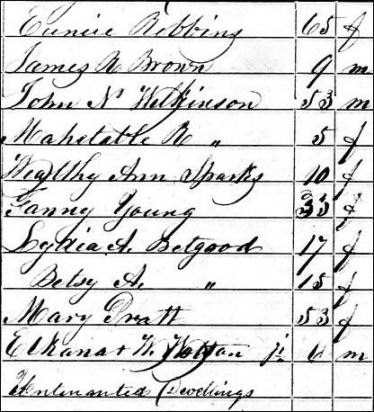
Childhood
We have yet to find any record of Elhanan W. Watson Jr. living with members of his own family during his childhood.
In 1850, six‐year‐old Elhanan Jr. was living in Voluntown, CT, in the household of Eunice Robbins. His census listing is at the bottom of the very last page for Voluntown, written above a line reading “Untenanted Dwellings.”
Miss Robbins seems to have been running a boardinghouse. Some of her tenants were family to each other. Three of the younger children were “unaccompanied.”
We wish we knew why Elhanan Jr. was living with Miss Robbins instead of with his older brother in the household of their paternal grandparents Jeffrey and Annie Watson, also in Voluntown.
By 1860, sixteen‐year‐old Elhanan Jr. was living in Pomfret, CT, with the family of Thomas V. Walker. As mentioned earlier: Though Elhanan Jr. was listed in that census as a farm laborer, it noted that he had “attended school within the year.”
We have already noted this Walker family’s close association with Elhanan Jr.’s father. For details, see “A Third Marriage” and “Estate Money” in Elhanan W. Watson Sr.’s own section.
Civil War Service
Elhanan W. Watson Jr. was a farmer, living in Brooklyn, Windham county, CT, when he enlisted in the Union Army on August 6, 1862. He served in Co. K, 21st Regiment, of the Connecticut Volunteer Infantry.
While the designation of this Connecticut regiment is what appears first and foremost in Elhanan Jr.’s Civil War pension documents – and on his gravestone – other record notations tell us with whom he actually spent his time in service.
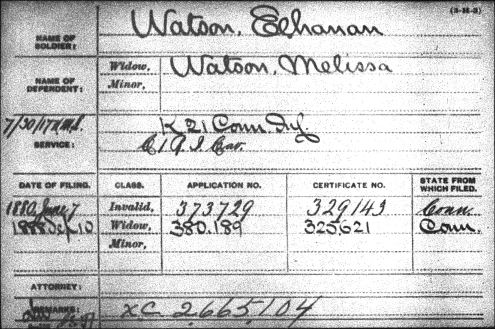
Elhanan Jr. was mustered in, at the rank of Private, on September 5, 1862. By October 16, 1862, he was part of a detachment serving with Battery E, 2nd US Artillery. Elhanan Jr. is on record as belonging to this detachment for slightly over a year, until October 31, 1863. But his active service was cut short when he became ill on or around July 15, 1863.
Elhanan Jr.’s pension file documents point to the Siege of Jackson, Mississippi, as the place and time when he fell ill with chronic diarrhea, and fever and ague. Elhanan Jr. attributed his poor health to “exposure and lack of rest.” He was treated for his symptoms in the field by the regimental surgeon.
When his condition did not improve, Elhanan Jr. was sent to a hospital which, by his own account, was in Cincinnati, Ohio. He spent six to seven weeks in that hospital before being sent to Camp Dennison, 16 miles northeast of Cincinnati.
Elhanan Jr.’s sickness rendered him unfit for active service for five months. He was deemed too disabled even to be placed in the Invalid Corps for light duty.
On January 27, 1864, at Camp Dennison, Elhanan W. Watson Jr. was honorably discharged from the Union Army with a certificate of disability. Noted at the bottom of his disability certificate: “The soldier desires to be addressed at Brooklyn, Conn.”
Was Elhanan Jr. feeling better by the spring of 1865? He must have been – because he mustered into Co. C, 1st Regiment, Rhode Island Cavalry on April 8th of that year. He joined up for the final months of this regiment’s service, which included “Duty in the Shenandoah Valley till June 22. At Monrovia Station and Relay House, Md., till August. Mustered out at Baltimore, Md., August 3, 1865,” per the National Park Service website. The August 3rd muster‐out date corresponds with the description of Elhanan Jr.’s short service with these “mounted volunteers.”
Things We Learned from Elhanan Jr.’s Civil War Pension File
Elhanan Jr. had brown hair and blue eyes. He was 5 feet, 9½ inches tall.
For the five years immediately prior to his enlistment, he resided in the towns of Pomfret and Brooklyn, Connecticut. His occupation was that of a day laborer on a farm. After his discharge, he lived in Brooklyn, Pomfret, and Killingly (all towns in Windham county, CT); and he worked on a farm, in a bobbin shop, and as a stationary engineer.
The people in Washington, DC, who processed Elhanan’s pension paperwork couldn’t figure out the correct spelling of his first name – which they needed to match to the War Department’s records. So Elhanan wrote it out for them again. Someone else wrote, very neatly, beneath Elhanan’s signature: “The correct spelling of Mr. Watson’s name is as he has written it above. E l h a n a n ”
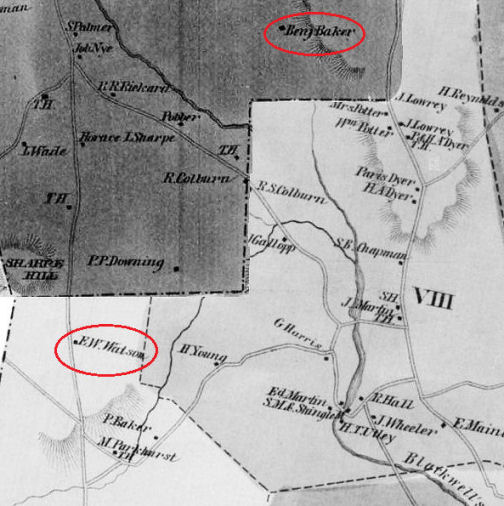
F. C. Watson of Plainfield, CT, handled the pension application for Elhanan Jr.’s widow.
This man, a pension attorney, was Frank C. Watson, Elhanan Watson Jr.’s second cousin. They shared a set of great‐grandparents: Samuel4 #26 Watson and his wife Abiah Young. Elhanan Jr.’s grandfather Jeffrey Watson and Frank’s grandmother Alice Watson were siblings.
Marriage and Children
Elhanan W. Watson Jr. did return to the town of Brooklyn, Connecticut, following his Civil War service. His residence there is preserved in a circa 1868 map of Brooklyn, in Windham county, showing that “E. W. Watson” lived on what is now called Cherry Hill Road.
Around that same time, Benjamin W. Baker – Elhanan Jr.’s future father‐in‐law – lived on the west side of a ridge southwest of present‐day Baker Hollow Road in Pomfret. (That locale is now part of Natchaug State Forest.)
The distance between Elhanan Jr.’s house and Benjamin Baker’s, as the crow flies, was roughly a mile and a half. We have annotated a composite map (at right) to show where these folks lived.
On April 8, 1870, in Killingly, CT, Elhanan W. Watson Jr. wed Melissa S. Baker. Melissa was born in Pomfret, CT, on April 13, 1850, the daughter and firstborn child of Benjamin W. Baker and his wife Lucinda Potter.
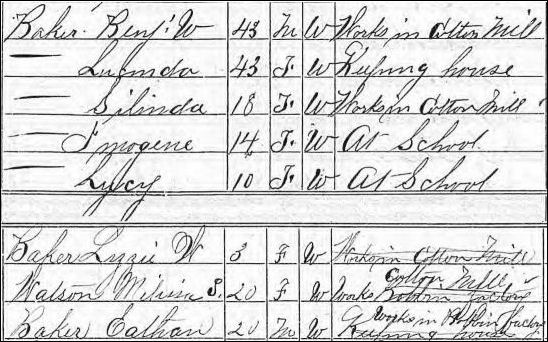
Their marriage record tells us that Elhanan Jr. lived in Killingly at the time, while Melissa was a resident of Abington, a village in Pomfret. So why didn’t they get married in the bride’s home town? – Probably because Melissa’s parents had also moved to Killingly: We find Benjamin Baker and his family in the 1870 census living in West Killingly. (In fact, both Benjamin and his wife Lucinda were residents of Killingly when they married there in September 1848.
The image shown at left combines the foot of one 1870 census page for Killingly – enumerating Benjamin, Lucinda, Celinda, Imogene, and Lucy Baker – with the top of the following page, which lists the rest of the Baker household – youngest daughter, Lizzie; Melissa S. Watson; and “Eathan Baker.” The census taker misspelled Elhanan’s first name; gave him his wife’s family’s surname; and made him the same age as Melissa. But we know it’s him, especially as his occupation was listed as “Works in Bobbin Factory.” In 1880 he was doing the same work.
Elhanan W. Jr. and Melissa (Baker) Watson had eight children, three of whom survived to adulthood:
- CLARENCE ELHANAN8, born October 30, 1871, in Killingly, CT; died December 11, 1952, in New London, CT. Clarence E. Watson married Eleanor “Nellie” PERKINS, with whom he had three children.
- FRANK, born and died in 1874.
- FRED, born and died in 1874.
- MELISSA ALNETTA (“Alnettie”), born June 22, 1875, in Killingly, CT; died May 8, 1946, in Pomfret, CT.
- FLOYD BENJAMIN, born April 9, 1878, in Killingly, CT; died March 29, 1942, in Holyoke, MA.
- LEONARD C. (“Lennie”), born November 14, 1882, in Pomfret, CT; died April 28, 1886, in Pomfret – a victim of diphtheria.
- ELMER, born and died in 1885.
- FLOSSIE, stillborn in Pomfret, CT, on February 12, 1887.
Notes regarding some of these children:
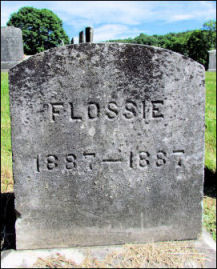
Frank and Fred Watson probably were twins. We know about them only because they have headstones at South Cemetery (also known as Sabin Cemetery) in Pomfret. We have found no birth/death/burial records for either of them. Given what we know about the other Watson children, we’d guess these babies were stillborn or lived their brief lives in Killingly, not Pomfret. Their stones in South Cemetery may be memorials – i.e., not marking their actual gravesites.
Elmer Watson, whether he was stillborn or died in infancy, likely made his brief appearance in Pomfret, CT.
Flossie Watson’s entry in the Hale Collection of Cemetery Inscriptions for Pomfret, CT, noted this child as a son, and mis‐transcribed its name as Flosie – despite the fact that the grave marker clearly says Flossie. The gravestone photo at right was obtained at Flossie’s Find a Grave memorial.
Dictionary.com defines the name Flossie as “a female given name, [a] form of Florence.” The Pomfret vital record noting this child’s stillbirth mentions neither its given name nor its sex.
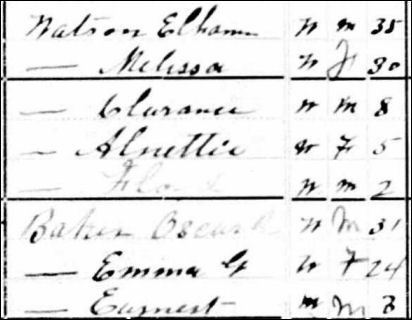
In 1880 we find Elhanan Jr. and Melissa in Pomfret. Living right next door to them was Melissa’s second cousin Oscar R. Baker and his family. Oscar’s wife was Melissa’s sister “Emma G.” (Emogene) Baker.
Both men were listed as working in a bobbin shop. Textile mills in New England needed bobbins for their spinning and weaving machinery. Back then, those bobbins were made out of wood.
Elhanan Jr., a wood turner, would have used a lathe to shape blocks of wood into bobbins of customized shapes and sizes specific to the mills’ machinery. In light of his health problems, this type of employment probably suited Elhanan Jr.: If necessary (and allowed), he could perform this work while seated.
Chronic Health Situation
Elhanan Jr.’s Civil War pension file tells us a lot about his physical condition.
Samuel Hutchins, M.D. (1818‐1886), of Danielsonville, CT, was the “examining surgeon” in August 1881 for Elhanan Jr.’s original application. Dr. Hutchins described him as
Considerably emaciated, appears weak. Says he has frequent attacks of diarrhea… Claimant says he has frequent attacks of chills and fever, which I think are of malarial origin…
While Hutchins believed Elhanan Jr.’s disability originated with his military service, he also was of the opinion that the disability was not permanent.
The following observations were recorded when Elhanan Jr. was examined again in March 1886:
Since his discharge, has not been able to perform manual labor more than one half of the time. Has had frequent attacks of diarrhea, especially in hot weather, & has never been free from attacks of chills and fever. His disability is such he can do only light work at present time.
General appearance sickly. Looks older than his age. The body is sparely nourished. Muscles flabby – lungs & liver normal. The impulse of the heart’s action seen through the skin. … The spleen is enlarged & extends two inches below the false ribs.
Per other pension file documents, Elhanan Jr. consistently reported “that he has not been able to labor more than about one third of the time in each year by reason of chills & fever & chronic diarrhea.” Friends testifying in 1882 on Elhanan Jr.’s behalf said, “He has not been able to perform manual labor more than one‐half to three‐quarters of the time in each year” and that “his earnings have been very much less in amount than he would have received if sound.”
We formatted some of the above in italics to focus attention on just how sick this man was. Elhanan W. Watson Jr. was skin and bones, emaciated to the point where the beating of his heart could be seen with the naked eye. And his yearslong illness significantly impaired his ability to earn a living for himself and his family.
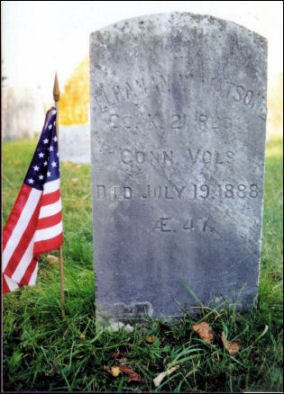
Death of Elhanan W. Watson Jr.
Elhanan Jr. died July 19, 1888, in Pomfret. Cause of death: An abdominal abscess. An account of Elhanan Jr.’s final illness, written by Asahel E. Darling, M.D. (1844‐1911), is found in a couple of the pension file documents:
“In regard to the illness and death of the late Mr. Elhanan Watson I give the following history of his case as near as I can now remember. His sickness commenced with an attack of diarrhea lasting for a few days and then followed by severe colic pains with great tenderness and swelling in the left inguinal region of the abdomen from which there developed an abscess terminating in death on July 19th 1888.”
Asked to supply additional information, Dr. Darling wrote:
“The abscess was located upon the left side of, and lower part of, the abdomen. No operation was performed but was examined with an exploring needle and about a teaspoonful of very offensive pus was obtained. The diarrhea did not continue throughout the whole course of the disease but for only about one week, after which no movement could be obtained. In addition, there were the usual symptoms of pain and fever which accompany such diseases.”
Elhanan Jr. was laid to rest in South Cemetery (also known as Sabin Cemetery) in Pomfret, CT. His age at death – 47 years – was carved into his gravestone. Elhanan Jr.’s true age at death almost certainly was 44 years (see “ The Excruciating Details,” above).
Widow Melissa and Her Children
Melissa Watson wasted little time in applying for a widow’s pension. She was successful at securing a pension for herself and her children under the age of 16 – Alnettie and Floyd. Son Clarence, 16 years old when his father died, was considered old enough to go to work – and probably was working already.
Melissa drew her widow’s pension until she got married again. Her second husband was Lyndon Mason, a widower who also lived in Pomfret.
Lyndon Mason’s first wife was Amanda Shippee, the daughter of Phillip and Dorcas Shippee. They had two children, both of whom died in infancy. Amanda died on April 22, 1874; she is buried in Smith‐Mason Cemetery in East Killingly, CT. (It’s possible she died in childbirth: Her unnamed infant son’s birth and death dates are 1874.)
Melissa (Baker) Watson wed Lyndon M. Mason on June 27, 1894, in Putnam, CT.
The timing of Melissa’s marriage to Lyndon Mason is interesting, coming six years after Elhanan Jr.’s death. In April 1894, youngest child Floyd B. Watson celebrated his 16th birthday – and “aged out” of his father’s pension benefits. Melissa could have gone on receiving her widow’s pension. But at age 44, beyond her childbearing years, with her children adequately grown, she may have felt freer to take a second husband and thus forfeit her right to draw pension benefits. We suspect also that Lyndon Mason was agreeable to Floyd’s continuing his studies: He was the only one of the Watson children to complete a high school education.
Melissa must have known Lyndon from way back. In 1880 he was a near neighbor, listed on the 1880 census page immediately following the Watson family’s enumeration, in Pomfret. Like Elhanan Jr., Lyndon was a bobbin maker and a veteran of the Civil War.
The 1900 census shows Lyndon and Melissa Mason living in Pomfret Center. They were enumerated in a two‐household dwelling, where Clarence Watson, his wife and family, and Alnettie Watson also lived.
In 1900 Floyd Watson was living in Charlemont, Massachusetts. His occupation was that of “butter maker.” He boarded with the family of Theron M. Totman, whose occupation was “butter manufacturer.”
Widowed Again
Lyndon M. Mason died in Pomfret on July 6, 1905, at 56 years of age. He was buried in South Cemetery in Pomfret, not far from Elhanan Watson Jr.’s gravesite.
Melissa (Baker) (Watson) Mason applied for a “Remarried Widow’s Pension,” detailing her first marriage to Elhanan Jr., his death, her second marriage to Lyndon, and his death. (The documentation for Lyndon Mason includes his death certificate, which is how we learned that he died from a cerebral hemorrhage.)
Melissa was again granted a widow’s pension on the basis of her first husband’s Civil War service.
Censuses for 1910 through 1940 show Melissa and Alnettie living with Clarence Watson and his family. Melissa was the head of her own “household” even as they shared a home. It must have been a good‐sized house, too, since a boarder named William H. King also appears in Melissa’s household in 1910 and 1920. (William was another a bobbin maker, per Connecticut Military Census of 1917.)
The 1930 census says that Melissa Mason owned the house in which she lived. Clarence Watson was a renter in that house, paying $15 a month to his mother.
We wonder if Lyndon Mason owned his home, and if Melissa inherited it upon his death. Its value was noted as $1200 in the 1930 census. We doubt Melissa had the means to buy a house while living on a widow’s pension.
We found Melissa and her family mentioned in a brief newspaper item from 1916.

“Visitors at I. W. Hammond’s Sunday were: Mrs. L. M. Mason, Mr. and Mrs. C. E. Watson, Miss Nettie Watson of Pomfret, Clarence Peckham of Woodstock and John Hammond of Clark’s Corner.” — Norwich Bulletin, Norwich, CT; Saturday, May 20, 1916, pg. 10.
Melissa was named in this local news item as Mrs. L. M. Mason – the initials belonging to her late husband Lyndon. Mr. and Mrs. C. E. Watson were Clarence and Nellie Watson, Melissa’s son and daughter‐in‐law. Miss Nettie Watson was, of course, Melissa’s daughter Alnetta.
Irving W. Hammond was the widower of Emma Baker, Melissa’s sister, who died in 1911. Irving lived in Hampton, CT, about ten miles from Melissa’s home in Pomfret.
This part of Windham county was a small world in those days: Irving Hammond’s son John, present at this 1916 gathering, eventually married Hessie (George) Wade. Hessie was the step‐daughter of Melissa’s nephew Gurdon W. Watson. (See also “An Unexpected Watson Connection,” story #24 in our collection of The Watson Family’s Greatest Hits.
Melissa died on December 30, 1942, at the age of 92. She was laid to rest near both of her husbands in South Cemetery in Pomfret. Melissa (Baker) (Watson) Mason was survived by two of her children, Clarence and Alnetta; a grandson, Frederick E. Watson; and two great‐granddaughters, Dorothy C. Watson and Jane E. Watson.
The Watson Children
Alnettie, Melissa’s and Elhanan Jr.’s only surviving daughter, never married.
Census records tell us that Alnettie was a dressmaker. She was active in the Wolf Den Grange in Pomfret, per several items in the Norwich Bulletin newspaper. Other newspaper items tell us that Alnettie was the administratrix of her mother’s estate following Melissa’s death in 1942.
As far as we know, Alnettie never left Pomfret to live elsewhere. She died in Pomfret on May 8, 1946, at the age of 70. Alnettie lies buried near her parents in South Cemetery in Pomfret.
Floyd shows up in a handful of news items in 1895 as a bicycle racing enthusiast. He was good enough at age 17 to place among the top competitors. Per the 1940 census, Floyd had a high school education—more schooling than most people got back then. Floyd’s brother Clarence and sister Alnettie were educated only through the eighth grade, which was far more common. Unlike his older siblings, Floyd sought employment and a life outside of Pomfret. (We wonder if his extra years of education somehow figured into this.)
In 1900 Floyd was living in Franklin county, MA. By July 22, 1918, the day he got married in Holyoke, MA, Floyd was “of Hartford,” CT. Floyd’s bride was Margaret Mary Dwyer, born October 9, 1884, in Holyoke, MA, the daughter of Irish immigrants James Dwyer and his wife Bridget McCoy.
We wish we knew how Floyd and Margaret met. It seems unlikely that they traveled in the same social circles. Margaret came from a Roman Catholic family. The priest who presided over their wedding Mass likely was Margaret’s uncle. The Watsons were Protestant. Margaret’s brother Edmund Dwyer was one of the attendants at the wedding Mass. Edmund was close in age to Floyd. However, unlike Floyd, he worked as a steam fitter. We’re thinking Margaret may have had a little more leeway in her social life following the death of her widowed mother in January 1915. And we’d guess that one of her brothers provided the connection for this unlikely pair to meet.
Margaret was a teacher in the Chicopee public schools. Floyd worked as a traveling salesman for the L. C. Cressey Grain Company of Boston, MA. Their marriage announcement in a Holyoke newspaper said that the happy couple would be living in Hartford, CT. Perhaps they did that at first. But by 1920 Floyd and Margaret were living in Holyoke, MA, Margaret’s hometown. And that is where they stayed.
Floyd and Margaret had no children.
Floyd Watson passed away in Holyoke on March 29, 1942. His obituary in the local newspaper fills in some of the gaps in Floyd’s personal history for us:
“Floyd B. Watson, sales manager of the Adco Glass Sterilizing Machine company, died yesterday in his home, 463 Appleton street, following a short illness. He was a brother‐in‐law of the late Edward [sic] J. Dwyer, founder of the Adco firm.
“Mr. Watson was born in Pomfret, Conn., where he was educated and lived for many years. He came to Holyoke 23 years ago. Before joining the Adco company he was a salesman for the Samuel Knighton Wholesale Flour company and also worked for the Gwim Milling company of Columbus, O. as its New England agent.
“Besides his wife, Mrs. Margaret (Dwyer) Watson, he leaves his mother, Mrs. Melisa [sic] Mason of Pomfret; one brother, Clarence; one sister, Miss Nettie Watson, both of Pomfret; and a nephew in Providence, R. I.
“The funeral will be held from Dillon’s funeral parlors, Tuesday morning, followed by a high mass of requiem in St. Patrick’s chapel. Burial will be in St. Jerome cemetery.” — Holyoke Daily Transcript and Holyoke Telegram, Holyoke, MA; Monday, March 30, 1942, pg. 10.
“Adco” was short for the American Dishwashing Company. In 1928, Margaret’s brother Edmund Dwyer applied for a patent for his “Apparatus for Washing Dishes.” US patent no. 2,228,205 was granted – in 1941, seven years after Edmund’s death. Though Floyd was still a flour salesman in 1940, per that year’s census, perhaps the granting of the patent encouraged him to work with and for his late brother‐in‐law’s business.
Margaret Watson survived Floyd by thirteen years. She passed away on Friday, October 14, 1955. Her obituary had this to say about her life:
“Mrs. Margaret (Dwyer) Watson, a retired teacher in the Holyoke School Department’s child care centers, died Friday in her home, 463 Appleton St., after a long illness. She was the widow of Floyd B. Watson.
“Born in this city, daughter of the late James and Bridget (McCoy) Dwyer, she received her early education in the Holyoke schools, and was graduated from Notre Dame High school in Chicopee and Miss Twitchell’s Kindergarten School in Springfield.
“Prior to her retirement two years ago, Mrs. Watson taught in the child care centers at South Chestnut, Morgan, and William Whiting schools for nine years. She was a member of the Holyoke Teachers Club.” — Holyoke Daily Transcript and Holyoke Telegram, Holyoke, MA; Saturday, October 15, 1955, pg. 12.
Margaret Mary (Dwyer) Watson was laid to rest in St. Jerome Cemetery in Holyoke, probably next to Floyd. We have found no listing for either Floyd or Margaret at the Find a Grave website; it’s likely that they have no headstones.
Clarence, the eldest of the Watson siblings, was the only one who had offspring.
Likely it was 1892 when Clarence married Eleanor Perkins, known as Nellie. We base this estimate on their 1900 census data – “married 8 years” – and the birth of their eldest child, Leonard, in May 1893.
Despite our best efforts, Nellie (Perkins) Watson’s origins remain unknown. We know her birth name only because it appears on the gravestone she shares with Clarence. Per that gravestone, they both were born in 1871. There are no Perkins burials in the cemetery where Nellie and Clarence are interred.
Multiple census records tell us that Nellie and both of her parents were born in Connecticut. But we don’t find a nine‐year‐old Nellie in 1880 census data for Pomfret or surrounding towns. We simply don’t know where, exactly, she came from, or who her parents were.
Clarence and Nellie had three children, two of whom survived to adulthood:
- LEONARD HOWARD9, born May 6, 1893, in Pomfret, CT; died October 22, 1932, in Cheshire, CT.
- FREDERICK ELLSWORTH, born January 10, 1895, in Pomfret, CT; died March 4, 1955, in Rocky Hill, CT.
- AUGUSTA I., born June 30, 1896; died March 1, 1900. “Gussie” died at age three from a varicella infection (chicken pox) and cerebral meningitis likely brought on by the viral infection. She is buried in South Cemetery in Pomfret, CT, not far from Elhanan Jr.
It seems Clarence named his firstborn child after his little brother Leonard C. (1882‐1886). And Clarence’s second‐born likely was named for his lost sibling Fred (1874‐1874).

Clarence Watson spent the bulk of his working life as a landscape gardener, per census data. His son Leonard followed him into this work for a time. Leonard’s WWI draft registration (excerpt shown at right) provided a clue as to where Leonard and Clarence labored.
What is your present trade, occupation or office? Gardener
By whom employed? Miss E. J. Clark
Where employed? Pomfret Center, Conn.
Miss Eleanor Jackson Clark (1839‐1923), heiress of a wealthy Boston family, spent summers at her country estate, La Plaisance, in Pomfret Center.
“The grounds consist of wide, sweeping lawns, with discriminating planting of shrubs and trees. There are extensive greenhouses and hothouses …”
— a description of La Plaisance, taken from A modern history of Windham county, Connecticut : a Windham county treasure book at Internet Archive.
Miss Clark’s “spacious home,” now part of the private Pomfret School, is a half‐mile south of the school’s Admissions building. Given what we found online, it’s easy to imagine the Watson men finding full‐time employment as landscape gardeners on the Clark estate.
More about Clarence later ….
The Watson Grandchildren
Leonard was the first to marry. On August 9, 1913, in the Abington neighborhood of Pomfret, CT, he wed Marion E. Smith. Marion, born in June 1892, was the only child of Albert B. and Mary I. Smith. Their newspaper wedding announcement said that the newly married couple would be living with the bride’s parents.
His effort to be exempted from WWI military service having failed, Leonard was inducted into the US Army on September 4, 1918. Most of his time was spent with Battery B, 33rd Artillery Regiment of the Connecticut Coast Artillery Corps. On December 6th, Leonard was honorably discharged, apparently having served his short term of service entirely stateside.
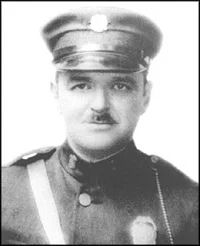
The 1920 census shows Leonard and Marion living in with her widowed mother. (Albert Smith died in May 1919.)
In August 1925, Leonard was one of fifteen men accepted into the Connecticut State Police’s training program. After training, he was assigned briefly to the CSP headquarters in Hartford, later going to the Westbrook barracks. Most of his term of service, however, was spent in Canaan, in the northwest corner of Connecticut.
Marion and Leonard’s marriage broke up in or before 1929. We don’t know who divorced whom. But we’d imagine that conflict arose out of Leonard’s working so far from home and/or Marion’s possible resistance to moving away from Pomfret.
For the record: Leonard and Marion had no children together. We lose all sight of Marion (Smith) Watson after the 1930 census, which lists her as a divorced woman still living in Pomfret with her mother.
In 1930 Leonard was living in North Canaan, where he was stationed. He had a new wife, Clara Castagna. Leonard and Clara wed in Valatie, Columbia co., NY, on August 25, 1929. Clara, born May 28, 1903, in Canaan, CT, was the daughter of Italian immigrants Augusto Giovanni Castagna and his wife Maria Angela Vanotti.
Leonard and Clara (Castagna) Watson had one child, a daughter:
- JANE ELEANOR10, born December 30, 1930, in Great Barrington, MA; died November 12, 1990, in Marlboro, Ulster co., NY.
Leonard Watson was 39 years old when he died in Cheshire, CT, in a motorcycle accident on October 22, 1932. Cause of death was a fractured skull.
A Connecticut State Police Union “In Memoriam” website mentions Leonard Watson. We have appended an asterisk to one sentence of their tribute because it conflicts with an eyewitness account of the cause of Leonard’s accident.
“Trooper Leonard Watson was killed in a motorcycle crash on the Waterbury‐Cheshire Road (modern‐day Route 70), in front of the Connecticut Quarries, while en route to work crowd control at a Yale University football game in New Haven.
* “His motorcycle slid on a wet railroad crossing and he was struck by an oncoming truck.
“Trooper Watson had served with the Connecticut State Police for seven years. He was survived by his wife and 18‐month‐old daughter.”
*Newspaper accounts of Leonard’s death include the testimony of Joseph Bernier of Meriden, CT. Bernier, a steam shovel operator working at the quarry, witnessed the accident.
“He said the ‘jiffy’ stand, which holds the motorcycle upright when stationary, fell from its clasp and threw the motorcycle out of control.” — The Hartford Courant, Hartford, CT; Sunday, October 23, 1932, pg. 1
Leonard H. Watson was buried in South Cemetery in Pomfret, CT, near his grandfather Elhanan Watson Jr. and his little sister Augusta.
Clara (Castagna) Watson never remarried. Eventually she left Canaan to live in Hartford. Clara died at age 81 on January 29, 1985, in Hartford. Per her obituary, she was laid to rest in Rose Hill Memorial Park in Rocky Hill, CT.
If Frederick Watson worked with his father and brother as a gardener, he didn’t do it for long. Fred’s career was rooted in telegraphy.
On February 23, 1917, Fred’s occupation was noted as “telegraph operator – clerk,” per the Connecticut military census. His P.O. address was Pomfret Center. On June 5th of that same year, Fred’s WWI draft registration listed his occupation as “Morse repeater operator” for the American Telephone & Telegraph Co. (AT&T). Fred’s address was given as 315 Pearl St. in Hartford.
Unlike his older brother, Fred didn’t wait to be drafted into military service. He enlisted at Ft. Slocum, NY, on July 31, 1917. After four months with the 100th Aero Squadron (per Wikipedia, an Air Service, US Army squadron during WWI), he was assigned to Company C, Ninth Field Battalion, Signal Corps, 5th Division (Regular Army).
On April 30, 1918, Fred Watson departed Hoboken, NJ, on a US Army transport ship, to serve with the American Expeditionary Forces in Europe. He was there until July 15, 1919, when he departed Brest, France, to return home. Fred rose from Private First Class to the rank of Sergeant during his term of service. He landed in New York, NY, on the 28th of July in 1919 and received his honorable discharge on August 1, 1919.
By September 4, 1919, Fred Watson was working for the railroad as a signal station operator in Hartford. The 1920 census, however, lists him as living in his father’s home in Pomfret while also working as telegraph operator for the railroad.
The railroad Frederick E. Watson worked for was “The New Haven.” Per the New Haven Railroad Historical and Technical Association:
“The New York, New Haven and Hartford Railroad Company, commonly known as the New Haven Railroad or simply ‘The New Haven,’ operated in the states of New York, Connecticut, Rhode Island, and Massachusetts. The New Haven operated freight and passenger trains over a Boston‐New York City main line and a number of branch lines.”
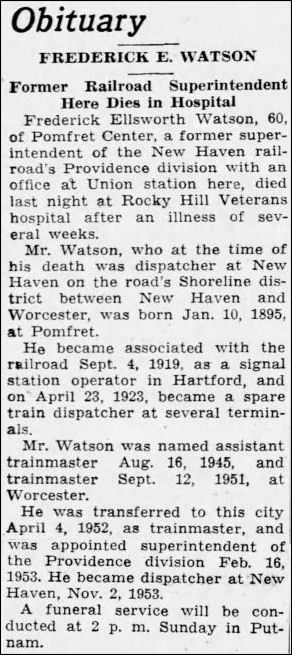
On April 23, 1923, Fred became a “spare train dispatcher at several terminals.” (Fred’s 1955 obituary is our source for the history of his railroad career.)
We have found no formal record of Fred’s marriage, circa 1922‐23. The 1930 census, listing Fred with wife Estelle, says they’d been married seven years. We know the name of Fred’s wife – Estelle Hurley – from their shared gravestone in South Cemetery, Pomfret. That gravestone gives her birth year as 1900.
Who were Estelle’s parents? Likely she was the daughter of Thomas and Helena (Brennan?) Hurley of Providence, RI. We find Estelle in this family in the 1910 and 1920 censuses. Her father Thomas worked as a locomotive engineer for the “steam railroad.” According to the 1922 Providence city directory, Estelle worked as a railroad telegrapher. It’s no mystery how she and Fred met each other.
Frederick and Estelle (Hurley) Watson had one child:
- DOROTHY CAROL10, born April 7, 1929, probably in New London, CT.
This Watson family continued to live in New London until at least 1935. By 1940 they were residents of Providence, RI. During this time, Fred worked as a train dispatcher.
Fred was named assistant trainmaster at Worcester, MA, on August 16, 1945. The 1950 census shows Fred and family still in Providence. In September 1951, Fred was promoted to trainmaster at Worcester. In April 1952 he was transferred to New London, CT, as trainmaster.
Fred Watson reached the pinnacle of his career with the New Haven railroad in February 1953 when he was appointed superintendent of the Providence division – “with an office at Union station in New London.” By November 2nd of that year, he was again a dispatcher. We wonder if his demotion was due to declining health.
Frederick Ellsworth Watson died on March 4, 1955 at the Veteran’s Hospital in Rocky Hill, CT, “after an illness of several weeks.” Family lore says that Fred’s cause of death was cancer. At the time of his death, Fred was a dispatcher at New Haven “on the road’s Shoreline district between New Haven and Worcester,” per his obituary in the New London Evening Day (March 4, 1955, page 2; image shown at right).
Fred was buried in the Watson plot in South Cemetery, Pomfret, CT. He was survived by his wife and his mother, “both of Pomfret;” his daughter, Dorothy Bockoven of Washington, DC; and a grandson.
More About Clarence Watson
Clarence’s household in 1920 contained more than one generation and branch of his family. Besides himself and his wife – and their son Fred, who may actually have been living in Hartford, where he worked – it included his sister Alnetta; his twice‐widowed mother Melissa (mislabeled as his mother‐in‐law); and his Aunt Lizzie Baker (Melissa’s sister). A boarder, William King, also lived there.
We highlight the above because it speaks of the responsibility Clarence assumed from a young age. Likely he worked to support his parents and siblings prior to his father’s death, and then afterwards. With the exception of his earliest years in Killingly, where he was born, Clarence apparently spent his entire life in Pomfret, never far from family.
In 1930, Clarence’s household was down to four – himself and wife Nellie, mother Melissa and sister Alnettie. Clarence still worked as a landscape gardener. The 1940 census found all four of them still there, living in Melissa Mason’s house on Route 101 in Pomfret.
By 1950, only Clarence and Nellie remained. Melissa had died at the end of 1942; Alnettie passed away in spring of 1946. Clarence was retired from his landscape gardening career.
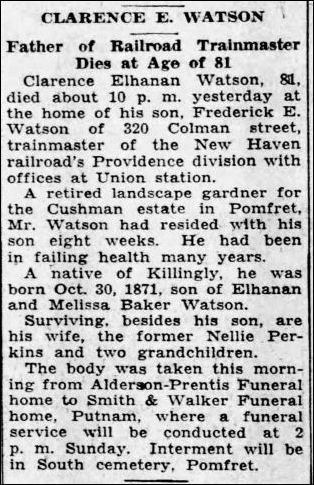
Clarence Watson died on December 11, 1952, at his son Fred’s home in New London. He was buried in South Cemetery in Pomfret, nearby his parents. His obituary in the New London, CT, local newspaper read:
“CLARENCE E. WATSON
“Father of Railroad Trainmaster Dies at Age of 81
“Clarence Elhanan Watson, 81, died about 10 p.m. yesterday at the home of his son Frederick E. Watson of 320 Colman street, trainmaster of the New Haven railroad’s Providence division with offices at Union station.
“A retired landscape gardener for the Cushman estate in Pomfret, Mr. Watson had resided with his son eight weeks. He had been in failing health many years.
“A native of Killingly, he was born Oct. 30, 1871, son of Elhanan and Melissa Baker Watson.
“Surviving, besides his son, are his wife, the former Nellie Perkins and two grandchildren.
“The body was taken this morning from Alderson‐Prentis Funeral home to Smith & Walker Funeral home, Putnam, where a funeral service will be conducted at 2 p.m. Sunday. Interment will be in South Cemetery, Pomfret.”
— The New London Evening Day, New London, CT; Friday, December 12, 1952, pg. 2
The Cushman estate in Pomfret, mentioned in Clarence’s obituary, was owned originally by Miss Eleanor J. Clark. Miss Clark bequeathed half of her Pomfret estate to her grandnephew Charles Van Brunt Cushman, who took ownership after her death in 1923.
It was Clarence’s good luck to be kept on as a gardener at this estate. And Miss Clark remembered both Clarence and his son Leonard in her will, bequeathing $500 to each of them.
Clarence’s wife Eleanor “Nellie” (Perkins) Watson was 91 years old when she died in Killingly, CT, on November 22, 1962. She was laid to rest in South Cemetery, Pomfret, in the Watson lot with husband Clarence and all three of their children.
Nellie’s son Frederick and his wife Estelle both predeceased her. Nellie outlived all but her daughter‐in‐law Clara (Castagna) Watson; her granddaughters Jane and Dorothy; and four great‐grandchildren.
Section Summary:
Born around March 1844, Elhanan W.7 Watson Jr. was the son of Elhanan W.6 Watson Sr. and his wife Ardelia Lamb. Elhanan Jr. was just a toddler when his mother died in November 1845. He grew up mostly in Windham county, CT.
Elhanan Jr. was 18 years old when he enlisted in the Union Army in August 1862. He served in Co. K, 21st Regiment, of the Connecticut Volunteer Infantry. During his military service, Elhanan became ill with malaria and chronic diarrhea. These health issues not only brought about his honorable discharge from the Army in January1864; they also plagued him for the rest of his life.
Returning to live in Windham county after the war, Elhanan worked mostly in bobbin shops where he was a “wood‐turner,” making the bobbins used in local textile mills.
In 1870 Elhanan married Melissa S. Baker. They had eight children, but only three of them survived to adulthood. Their early years as a family were spent in Killingly, CT. Between 1878 and 1880 they moved to Pomfret, CT.
Elhanan was granted a federal pension for his Civil War service, based on his health problems acquired during his time in the military. That pension may have kept this Watson family financially afloat during the times Elhanan was too sick to earn a living.
On July 19, 1888, Elhanan W. Watson Jr. died in Pomfret from an abdominal abscess.
Melissa Watson obtained and drew a widow’s pension until she got married again in 1894. Her second husband was Lyndon Mason, a widower who also lived in Pomfret. When Lyndon died in 1905, Melissa succeeded yet again at procuring a widow’s pension.
Melissa (Baker) (Watson) Mason died at age 92, having outlived two husbands and six of her eight children.
Siblings Clarence and Alnettie Watson remained in Pomfret. Their brother Floyd Watson left Connecticut to live in Holyoke, MA, his wife’s hometown.
Elhanan W. Watson Jr.’s descendants were few. Of his three surviving children, only his son Clarence had children. Elhanan Jr.’s male line “daughtered out” when his grandsons Leonard and Frederick produced no sons of their own. Great‐granddaughters Jane and Dorothy married and had children. Elhanan Jr.’s great‐great‐grandchildren carried Watson genes (but not Watson Y‐DNA) into subsequent generations.
Sources for Elhanan W. Watson Jr.
We thank Rep. James P. McGovern (D‐MA, 2nd District) for procuring a copy of Elhanan W. Watson Jr.’s Civil War pension file # XC2665104 from the Veterans Administration.
After 1934, Melissa Mason’s still‐active widow’s file was transferred to the Veteran’s Administration, which handled her pension benefits from that time. This is why it has the XC designation, and why it wasn’t available from the National Archives in Washington, DC.
We began trying to obtain this file in 2002 and could not get a reply from anyone. In 2010, we asked Rep. McGovern for his help (we were residing in Massachusetts at the time). Elhanan Jr.’s pension file was in our hands five months to the day after we submitted our request.
Wikipedia’s Bobbin wiki page, citing “Wooden Bobbins: Woven in History,” by Jim Therriault, October 21, 2011, as published in The Old Farmer’s Almanac (Almanac.com), Dublin, NH: Yankee Publishing. [Note: The link provided at this wiki page for this citation is broken.]
Connecticut Vital Records — Index of Deaths, 1897‐2001
Ancestry.com, for census records and more.
FamilySearch.org, for stuff that Ancestry.com doesn’t have. (And it’s free.)
“Connecticut Deaths and Burials, 1772‐1934,” FamilySearch <https://familysearch.org/ark:/61903/1:1:QLM4-9WKT> : 22 July 2021, Augusta I. Watson, 1900.
Newspapers.com, for death notices, obituaries, local gossip column items, and more.
Find a Grave, for these Watson memorial pages:
Elhanan W. Watson Jr. in South Cemetery, Pomfret, CT
Melissa (Baker) (Watson) Mason in South Cemetery, Pomfret, CT
Clarence E. Watson in South Cemetery, Pomfret, CT
Alnettie M. Watson in South Cemetery, Pomfret, CT
Leonard H. Watson in South Cemetery, Pomfret, CT
Frederick E. Watson in South Cemetery, Pomfret, CT
Augusta I. Watson in South Cemetery, Pomfret, CT
Jane E. (Watson) Ford in Rose Hill Memorial Park, Rocky Hill, CT
An article regarding Miss E. J. Clark’s will, including her bequests to Clarence and Leonard Watson, was published in the Windham County Observer newspaper (Putnam, CT) on 14 May 1924, pg. 2. We found that newspaper page at the Library of Congress’s “Chronicling America” website.
The above article erroneously gives Miss Clark’s first name as Elizabeth. Her first name was Eleanor.
Historical maps of Pomfret, CT, and Brooklyn, CT, were obtained at the University of Connecticut Library Map and Geographic Information Center (MAGIC) website.
Appendix
Joanna Gallop’s Origins
Though we have found no birth record for Joanna, likely she was a daughter of Samuel Gallop and his wife Sarah Draper, who lived in West Greenwich.
Sarah was the daughter of William Draper who was born in West Greenwich, Rhode Island, on July 23, 1719. William was the son of Thomas Draper and Jane Brayman, who wed in “Kings Towne,” Rhode Island, on October 5, 1718.
Sarah Draper’s mother apparently was William Draper’s wife Joannah (maiden name unknown). We have found no birth record for Sarah Draper: but it sure looks like Sarah named one of her daughters for her own mother.
Joannah (—) Draper was widowed early: Exeter town council records for August 12, 1746, note that she was administratrix for the estate of her deceased husband William, “late of Exeter.”
WG town council records for the last Saturday in September 1772 include notes regarding the estate of Thomas Draper, “late of West Greenwich.” Thomas’s will, dated June 20, 1763, was proved on October 26, 1771. In that will, Thomas Draper mentions his granddaughters Elizabeth Mumford, Sarah Gallup, and Hannah Draper, all daughters of his son William. (Apparently, Hannah Draper had a different mother than Elizabeth and Sarah.)
Sarah Draper married Samuel Gallop in West Greenwich on September 3, 1761. (Typically a wedding took place in the hometown of the bride.) Samuel Gallop is “of West Greenwich” in records spanning from 1773 to 1794.
Section Summary:
Joanna Gallop likely was the daughter of Samuel and Sarah (Draper) Gallop of West Greenwich. Sarah Draper was the daughter of William Draper and Joannah (—). William Draper was the son of Thomas Draper and Jane Brayman.
Samuel Gallop of West Greenwich
A West Greenwich Town Council record for the last Saturday of July 1773 lists a highway crew, headed by Elisha Greene, that includes Samuel Gallop’s name (WG TC: Book 3, unpaginated).
In the 1774 Rhode Island census for West Greenwich, the numbers for Samuel Gallop’s household include one white male above 16 years of age (Samuel); one white female above16 years of age (Sarah); and three white females under the age of 16.
Samuel Gallop served in the Revolutionary War at the same time, in the same regiment, at the same rank (private) as Samuel #26 Watson, son of the patriarch – Capt. Thomas Gorton’s company, in the Rhode Island militia regiment commanded by Col. Christopher Lippett. Both men’s names appear on the payroll for this company in September 1776; Samuel Gallop was listed as “Saml. Gallap.” Given that he continued to be “of West Greenwich” in subsequent years, we may assume that Samuel Gallop enlisted in Captain Gorton’s company around the same time and place that Samuel Watson joined up:
“I Elisha Sweet of West Greenwich in the County of Kent in the State of Rhode Island aged seventy three years do testify and say that in the year 1776 I was at a Justice Court in said West Greenwich at which place was Samuel Watson and also Capt. Thomas Gorton who it was then said was enlisting men for a Company of Continental soldiers and it was said enlisted among others Samuel Watson of said West Greenwich – ” (From a deposition made by Elisha Sweet on October 7, 1836, in support of widow Abiah Watson’s application for a widow’s pension.)
The 1777 Rhode Island military census records Samuel Gallup of West Greenwich as “from 16 to 50 years” of age and able to bear arms.
In 1778 Jacob Lewis sold land in West Greenwich to Samuel Gallop (WG LE: Book 7 [old series], p. 354‐355). We regret that we do not have a copy of the deed for this transaction.
In 1779, Samuel sold 18 acres of land in West Greenwich to Caleb Greene (WG LE: Book 7 [old series], p. 450‐451). From the deed associated with this sale, we learn that Sarah (Draper) Gallop was a party to this transaction: She signed away her dower rights to the property. Both she and her husband signed their names with X’s, showing that they – like so many others of that time – were not literate.
West Greenwich town council records for September 29, 1781, include an item regarding those exempted from being fined for their inability to equip themselves with “war like essentials.” Samuel Gallop was listed among the currently unarmed men.
The Rhode Island census of 1782 (transcribed by the late Katharine U. Waterman of North Scituate, RI, and published in the NEHGR) lists Samuel Gallop just ahead of Samuel “Watteson,” the patriarch. Samuel Gallop’s household that year consisted of one male and four females, all under the age of 16: one female aged 16‐22: and one male & one female, both aged 22‐50. Samuel and Sarah Gallop appear to have been the parents of five daughters and one son.
We have found nothing to indicate that Samuel and Sarah’s son survived to add another generation to the Gallop lineage. The William Gallup who appears in West Greenwich censuses between 1800 and 1840 is mentioned in the 1893 edition of The Genealogical History of the Gallup Family in the United States (see excerpt, below). He was the fourth son of Isaac and Margaret Gallup of Voluntown – a member of the far better known Connecticut branch of the family.
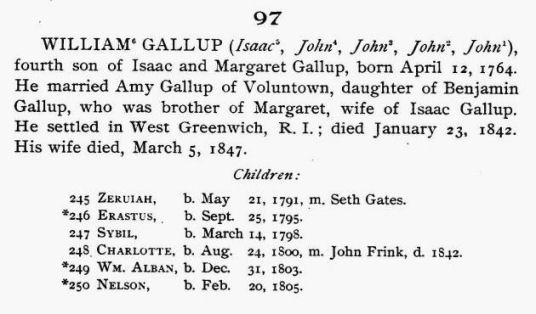
Sarah (Draper) Gallop may have died prior to 1784, the year in which her widowed grandmother Jane (Brayman) Draper passed away. Jane Draper’s will, dated April 14, 1784, and proved on August 28th of that same year, mentions three sons, two daughters, and grandchildren Amos Draper, Abel Aylesworth, and Ruth Budlong. There is no mention of Sarah Gallop or any of Sarah’s children.
West Greenwich town council records for September 8, 1787, include questions about the extent of the charges presented for reimbursement by Dr. Stephen Allen for “doctoring” Ruth Gallop (WG TC: Book 3, unpaginated). We note this with interest, as Ruth may have been one of Samuel and Sarah Gallop’s daughters.
The 1790 federal census for West Greenwich does not include a listing for the household of Samuel Gallop. Given that his name appears twice in West Greenwich town council records in the years following, likely he did not move out of town. While those council records imply that Samuel Gallop had fallen into some degree of poverty, they don’t suggest that he and his family were impoverished enough to have been absorbed into someone else’s household.
Those particular town council records are dated for 1792 and 1794.
On June 25, 1792, Nathaniel Pulman had an order on the Town Treasurer for 1 pound, 4 shillings for 8 bushels of corn provided to Samuel Gallop (WG TC: Book 4, unpaginated).
On April 28, 1794, Thomas Tillinghast had an order on the Town Treasurer for £1:15:2:½ for “necessaries” for Samuel Gallop, by order of Ellis Austin, overseer of the poor (WG TC: Book 4, unpaginated).
After that last entry, Samuel Gallop’s name disappears from the town council records of West Greenwich. We assume that he died between 1794 and 1800.
Later in 1794, a woman named Sarah Gallop – quite likely Samuel Gallop’s daughter – petitioned the WG town council for child support money assessed from John Wilcox, the father of her out-of-wedlock child.
On August 25, 1794, Sarah Gallop requested “£5:19:6 for supporting her child laid to John Wilcox from the 30th day of July 1793 to this date” (WG TC: Book 4, unpaginated).
As mentioned earlier, a child “laid to” a man meant that the mother had identified the father of her out‐of‐wedlock child, so that the town could assess the father for child support. The town would then dole it out over time to the person caring for the child, often the mother.
Sarah Gallop’s situation was mentioned in several more entries in the West Greenwich town council minutes.
On November 30, 1795, Sarah Gallop again requested child support, in the amount of 1:6 (either one pound, six shillings; or $1.06) “for keeping her child laid to John Wilcox 65 weeks up to this date” (WG TC: Book 4, unpaginated).
On April 24, 1797, the town council recorded that “Stephen Wilcox have liberty to take and keep the bastard laid to John Wilcox by Sarah Gallop provided said Sarah will not keep it for $7 per year, the sd Stephen having given bond to indemnify sd Town on account of sd bastard child” (WG TC: Book 4, unpaginated).
We’re guessing that Stephen Wilcox was the grandfather of Sarah’s child, who would have been nearly four years old by then. We don’t know if Sarah agreed to retain custody of this child “for $7 per year,” or not.
An entry from the spring of 1798 involves a midwife’s fee for two Gallop women.
On March 26, 1798, Phoebe Mowry requested $3.50 from the town treasurer “for attending as a midwife with Sarah and Joanna Gallop when they Lay In with Bastard Children” (WG TC: Book 4, unpaginated).
Section Summary:
Samuel Gallop appears in records for West Greenwich between 1761 and 1994, including his marriage to Sarah Draper; early censuses; land evidence; and a few town council items. Census records show that Samuel and Sarah Gallop likely had five daughters and one son.
Samuel Gallop’s Origins
A problematic source
In the decades we’ve spent looking for the origins of Samuel Gallop, we have found only one item declaring which family he came from. That item was in the typescript genealogical compilation Draper, Lothrop, Rogers, Byington, Goodsell, Etc: Allied Families of Van Leuven, published in 1999 by Audrey Van Leuven (1910‐2004).
On page 17 of this work, Ms. Van Leuven states that Sarah Draper’s husband Samuel Gallop was the son of William Gallop; and she cites the October 1727 date of Samuel’s baptism in Bristol, Rhode Island. There was, indeed, a Gallop family of Bristol, RI, with a descendant named William who had a son named Samuel – whose baptism in 1727 appears in records for Bristol. Yet Ms. Van Leuven offers nothing about why she made this particular designation.
One of the sources we consulted for an overview of the Bristol branch was an article by Dorothy Chapman Saunders, Ph.D., Was Samuel Gallop/Gallup of Bristol, RI the “Lost” Son of Captain John Gallop of Boston, MA and Stonington, CT? On page 213, Dr. Saunders mentions this same Samuel Gallop, son of William Gallop and his wife, Mary Antill, and cites the same date of Samuel’s baptism at St. Michael’s church in Bristol.
This particular Samuel Gallop’s story stops right there with his baptism. Apparently there are no other records in Bristol to tell us what became of him.
Some researchers associate William Gallop’s son Samuel with the Samuel Gallop who wed Mary Mason in Boston, MA, in April 1751. That’s not a bad guess, given that William Gallop is said to have died in Cambridge, MA, right across the river from Boston. Perhaps members of this Bristol, RI, Gallop family relocated to the Boston area.
The things that could link Samuel Gallop of Bristol to Sarah Draper of West Greenwich are his name; his residence in the same colony; his date of baptism, which tells us he was more than old enough to marry Sarah; and no real competing accounts of his life. Yet we question Ms. Van Leuven’s assertion, given with no supporting evidence. We suspect she made an assumption based on the reasoning we’ve suggested here, not on any additional records to which we are not privy.
Was Samuel Gallop the son of Richard Gallop Jr.?
We have found evidence to suggest that Sarah Draper’s husband might have come from a Gallop family living in West Greenwich. And we give more weight to the possibility that Sarah married a man from her own place of residence, a man who likely was closer in age to Sarah than the Samuel Gallop baptized in Bristol in 1727.
We formed our hypothesis – that Sarah Draper’s husband Samuel Gallop was local to West Greenwich – by studying and consulting a variety of sources:
We think that Samuel Gallop, the man who married Sarah Draper, may be an unidentified son of Richard Gallop Jr. of West Greenwich. We base our assumption on time frame, proximity, and a set of military records that suggests a possible sibling relationship.
Richard Gallop Jr.
Richard Gallop Jr. was born circa 1705, possibly in North Kingstown, Rhode Island.
The book William Gallop, Revolutionary Soldier says that “Richard apparently moved to West Greenwich, R.I., early in 1738” (Walker, pg. 216). When Ms. Walker wrote her book, she included Richard as a “stray” Gallop; she did not know his origins or that he was Richard Junior.
Richard Gallop’s name appears repeatedly in West Greenwich and Exeter town council records in 1743 and 1744, when the legality of his presence was questioned by both towns.
It began late in November 1743, when the WG town council demanded that Richard Gallop appear at its December meeting to show cause why he remained in town. Things escalated on February 27, 1743/4, when the council ordered its clerk to “draw a summons for Robert Haszard to appear and show the reason why he harboured Richard Gallup in his house.”
Apparently Richard Gallop Jr. solved his problem by moving his family to the town of Exeter, immediately south of West Greenwich. This triggered a response from the Exeter town council. At its July 10, 1744 meeting, it demanded that Richard Gallop show up at the next council meeting to explain why he continued in that town.
Exeter’s town council records for August 4, 1744, include an examination of Richard Gallop: Where did you live when the line was run between West Greenwich and Exeter? Richard’s answer: In West Greenwich, where he’d resided for six or seven years; he had gained no settlement before that.
In 1741 the town of Greenwich, RI, was split into East and West Greenwich. The town of Exeter was formed in 1742 from the western part of North Kingstown. Where Richard Gallop likely was born (North Kingstown) might have dictated his legal settlement as Exeter, formed from NK. But the fact of his years‐long residence in Greenwich prior to its split might have determined his legal settlement as WG.
Exeter sent Richard Gallop back to West Greenwich.
West Greenwich sent Richard Gallop back to Exeter.
In the fall of 1744, Exeter deputized two men, John Weight and John Reynolds, to draw up a petition to be presented to the next session of the “Assembly” (presumably the colony’s General Assembly). This petition asked the Assembly to determine whether Richard Gallop was, legally, an inhabitant of West Greenwich or of Exeter. John Weight and John Reynolds traveled to West Greenwich to involve that town’s councilmen in this matter.
We don’t have the results of this petition to the Assembly; but what happened afterwards suggests that the town of Exeter won that round. On March 11, 1745, the Exeter town council ordered that Richard Gallop Jr. “be and he is hereby rejected as being Inhabitant of the town of Exeter” (Walker, pg. 217).
Family Projected for Richard Gallop Jr.
Louise Gallup Walker outlines Richard Gallop’s family on page 217 of William Gallop, Revolutionary Soldier:
Joseph, born circa 1726
Richard, probably the “son” born Dec. 6, 1727, in North Kingstown, RI
Daughter, born January 9, 1738
Ben‐Adam, born circa 1741
This line‐up of children has plenty of gaps to accommodate and account for other children born to Richard Gallop Jr., whose wife’s name was Lydia (per Walker, pg. 216).
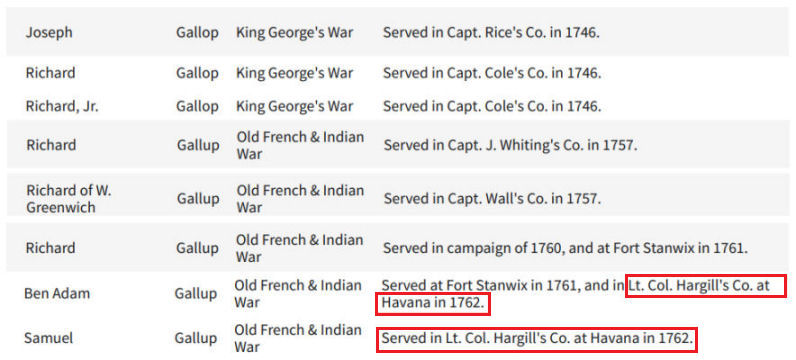
Records show that Richard Gallop and Richard Gallop Jr. served in Capt. Cole’s company in King George’s War in 1746 – the “Canadian Expedition” (Walker, pg. 217). By that time, the Richard Gallop bearing the generational suffix “Junior” was not the same man who’d repeatedly been warned out of West Greenwich and Exeter; he was his son, born circa 1727. Benjamin Adam Gallop – “Ben Adam” – born circa 1741, was his brother.
Both Ben Adam Gallop and Samuel Gallop served in the company commanded by Lieutenant Colonel Christopher Hargill at Havana in 1762 in the Old French & Indian War.
Benjamin Adam Gallop of West Greenwich was one of two men who attested to the 1762 death of Hazard Watson of Exeter, who also served in Lt. Col. Hargill’s company (Exeter, RI, Probate records, Vol. 2, pgs. 182-183: the will of Hazard4 Watson).
Records for West Greenwich marriages tell us that Benjamin Adam was the son of Richard Gallop. (Note that the surname spellings “Gallop” and “Gallup” were pretty much used interchangeably.)

Benjamin Adam’s marriage to Mary Ripley is the only Gallup entry in West Greenwich’s records (as compiled by James N. Arnold) that identifies the bride’s and groom’s fathers. It’s helpful to have that distinction, given that the name Ben‐Adam Gallup was fairly common in Voluntown and Stonington, Connecticut, towns close to West Greenwich.
Benjamin Adam’s first child with his bride Mary Ripley was a son, Matteson Gallop, born 19 July 1762 in West Greenwich – little more than five months after Ben‐Adam and Mary tied the knot.
We are struck by the choice of name for this baby son. We wonder if Benjamin Adam’s mother Lydia’s maiden name, sometimes given as Mathewson, was actually Matteson. The Matteson surname was quite common in Rhode Island.
We may assume that Benjamin Adam Gallop was still resident in West Greenwich in 1763, based on a “writ of attachment” from June 6, 1763. This document was signed by David Hopkins, J. P., a transcription of which was preserved in Descendants of James Hopkins and Jean Thompson of Voluntown, Conn.
To the Sheriff his Deputy or to either of the town Sergeants or Constables in the County of Kent
Greeting
You are hereby in his Majesty’s name George the Third King of Great Brittian &c Required to arrest the body of Benj Adam Gallop of West Greenwich in the County of Kent, husbandman if he may be found in your precinct and for want of his body to attach his goods and Chattels or him or them in safe Costody keep until he give sufficient bond to answer the complaint of James Tanner of West Greenwich aforesaid husbandman at a Justice’s Court to be holden in said West Greenwich and at the Dwelling house of Abel Potter of said West Greenwich. Innholder on the thirteenth day of this Instant June at one of the clock in the afternoon in said Day in an action of the case sartrover for the convertion of a certain white cur doge with some black on his head and a black spot on his rump being the Property of the Plaintiff and to him– which Doge the Plaintiff was on the twenty fifth Day of May AD. 1761 possessed of as his own proper estate and continued to possessed of said Doge till on or about the thirteenth Day Doge and since came into the hands of the Deft. by finding said white Cur Doge now the Plaintiff in fact saith that he was possessed of said Cur Doge untill about the thirteenth Day of May AD. 1763 when he came into the hands of the Deft. by –finding him at which time the Deft. Did take the said Doge and Convert him to his own use without making any satisfaction to the Plaintiff for the same and still Doth withhold said Doge from the Plaintiff when legaly demanded which is contrary to the Law and to the Damage of the Plaintiff forty pounds old tenor and hereopon he brings his suit &c hereof failnot but true Return make with your Doings thereon.
Given under my hand and seal at West Greenwich afore‐said this sixth Day of June in the third year of his said Majesty’s Reign AD. 1763
(signed) David Hopkins, Justice peace.
If a pair of queries (posted in a New England Historic Genealogical Society publication) contain accurate information, Benjamin Adam Gallop left West Greenwich circa 1764 with other family members.
NOTE: We have not confirmed the info contained in those two queries, found at the NEHGS website (AmericanAncestors.org) and shown below:
GALLOP/CASE Seeking family data on Joseph GALLOP (1726‐1799), m. (1) at W. Greenwich, RI., 1747 Mary CASE; m. (2) Fear ___; d. at Hebron, Washington Co., N.Y. Joseph came to Williamstown, Berkshire Co., Mass., in 1764 with sister Elsey GALLOP, w. of Nehemah [sic] WILLIAMS (1736‐1792) and their bro. Benjamin Adam GALLOP (1741-?), husband of Mary RIPLEY. — John H. Schultz, 1085 Bowen Dr., W., No. Tonawanda, NY 14120
GALLOP/RILEY [sic] Searching for date and place of death of Benjamin Adam GALLOP, b. 1741, son of Richard Jr. & Lydia (___) GALLOP. He m. at W. Greenwich, RI., 14 Feb. 1762 Mary, dau. of John & Merebeth (LEE) RIPLEY. A son Matteson GALLOP was b. 19 July 1762 and is believed to be identical with the Jesse M. GALLOP (1762‐1826) who served in the 17th Regiment of the Albany Co., N.Y. Militia, “Kings District,” and d. at Lake Pleasant, Hamilton Co., N.Y. — John H. Schultz, 1085 Bowen Dr., W., No. Tonawanda, NY 14120
We don’t have an unequivocal record tying Samuel Gallop to the West Greenwich family of Richard Gallop. But the framework of the available evidence suggests that, rather than coming out of nowhere to marry Sarah Draper in 1761, he could have been part of Richard Gallop’s family. Given that the other candidate, Samuel Gallop of Bristol, RI, hailed from a town 20 miles distant from West Greenwich (as the crow flies) and was significantly older than Sarah, we favor the idea of a local man who likely was closer in age to Sarah.
Regarding Sarah Draper’s age: Audrey Van Leuven, author of the compiled genealogy mentioned earlier, assigns Sarah a birth year of circa 1743 – two years after the birth of her sister Elizabeth, and a year before the arrival of her half-brother Thomas (born apparently out of wedlock to her father and a woman named Mary). This suggests that Sarah was 18 years old when she wed Samuel Gallop in 1761.
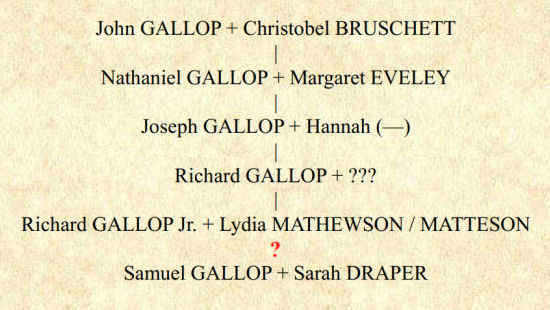
As mentioned earlier, both Ben Adam Gallop and Samuel Gallop served in the same company in 1762 in the Old French & Indian War. They both got married in West Greenwich in a six‐month span of time. The likelihood is that Samuel Gallop was near in age to Benjamin Adam, born circa 1741.
IF Samuel Gallop were an unidentified son of Richard Gallop Jr., his line of descent from English immigrant ancestor John Gallop would look like this graphic, at right, composed by the author:
We developed this line of descent by drawing upon the research and scholarship of Gallup descendant Carmen M. Johnson. It is necessarily tentative, since the branch descending from Nathaniel Gallop is the least well known of the Gallop/Gallup family. Ms. Johnson confirmed for us, in an email dated 15 February 2021, that this line of descent through Richard Gallop Jr. appears to be correct. The addition of Samuel Gallop to this line-up is the author’s own proposal, as is the alternate maiden name for Lydia Mathewson.
Section Summary:
There are no specific records to tell us about Samuel Gallop’s family of origin.
Audrey Van Leuven, author of a compiled genealogy that includes the Draper family, says that Sarah Draper’s husband Samuel hailed from the Bristol, RI, branch of the Gallop family.
We found evidence of a Gallop family in the same town where Sarah Draper married Samuel Gallop. A series of records and documents pointing to the family of Richard Gallop Jr. of West Greenwich, RI, suggests that Samuel Gallop may, in fact, have been an unidentified son of Richard Gallop Jr.
More About the Draper Family of West Greenwich
Our aim in this section is to convey more of what we found in Audry Van Leuven’s book Draper, Lothrop, Rogers, Byington, Goodsell, Etc: Allied Families of Van Leuven. Please note that we have not verified all of Ms. Van Leuven’s findings.
In the Draper section of this book, we find two items of particular interest. The first is a transcription of Thomas Draper’s will, dated June 20, 1763, and proved October 26, 1771. The second is a transcription of a deed, dated March 24, 1764, for land in West Greenwich, for which Ms. Leuven cites West Greenwich, Kent co., RI, Land Evidence, Book 4. These records name two more children imputed to Thomas Draper’s son William but not by his wife Joannah.
Thomas Draper’s will includes a bequest for granddaughter Hannah Draper:
“Item - I give and bequeath unto my granddaughter, Hannah Draper, the deputed [sic] daughter of my son, William Draper, deceased, two dollars to be paid in one year after my decease.”
We would guess that the word “deputed” in the above ought to be “imputed.” Thomas Draper was acknowledging a child born to his late son William, either illegitimately or through a marriage contracted after William left his (first) wife Joannah.
Less than a year after drawing up his will, Thomas Draper deeded eighty‐four acres of property in West Greenwich to a namesake grandson:
“ … for the Love and goodwill I ... do bear unto my well Beloved grandson Thomas Draper the imputed son of my son William Draper deceased …”
Ms. Van Leuven did an admirable job of transcribing Thomas Draper’s will, resorting to a question mark in only one place. The language (and, no doubt, the old‐style cursive handwriting) in the deed proved far more challenging. Ms. Van Leuven’s transcription of the deed is littered with question marks and a frank admission that it was “too hard to read.” And yet, the portions of the deed she was able to decipher resemble much of the boilerplate of that time. We accept that the intent of this document was to convey real estate from Thomas Draper to his imputed grandson of the same name. Once again, Thomas Draper was acknowledging a child born to his late son William, either illegitimately or through a marriage contracted after William left his (first) wife Joannah.
Ms. Van Leuven reveals that she found birth records for these children, Thomas and Hannah, in Groton, Connecticut, saying that “these just have to be the children of our William.” Indeed, they do: The names are a match for the grandchildren named by Thomas Draper in his will and in that land evidence.
Ms. Van Leuven assumed that these two of William Draper’s children were illegitimate, likely based on the language used in the will and the deed. If siblings Thomas and Hannah were born to married parents, words like “imputed” would be unnecessary. We are inclined to agree, despite the wording on an image copy of the Groton, CT, birth records, obtained at FamilySearch:

This excerpt shows only the entries for the Draper children. It clearly says that Thomas Draper was the son of “Wm. Draper & his wife Mary.” But elsewhere on that page are listings of entire family groups, many with dates of marriage for the parents. This strongly suggests that this handwritten record was a compilation copy made at a later date. The original birth records may have made no reference to William’s and Mary’s marital status.
Either way, the reality seems to be that William Draper abandoned his wife Joannah and their daughters Elizabeth and Sarah. He left Rhode Island to live in Groton, CT, where he created a new family with a woman named Mary. By August 12, 1746, William was dead, leaving both women with young children – and Joannah to deal with probate issues since he had died intestate.
A remark made by Ms. Van Leuven about the distance between Exeter, RI, and Groton, CT, is in error. She says (emphasis ours):
“... when William [Draper] died, he evidently was living over in Groton, Connecticut. Overland from Exeter to Groton is about 100 miles, longer if he went by water.”
In fact, the straight‐line distance between Exeter, RI, and Groton, CT, is only about 32 miles. Our guess is that Ms. Van Leuven inadvertently determined the distance between Exeter, RI, and Groton, Massachusetts, which is about 72 miles “as the crow flies.” (Google Maps computes the driving distance between Exeter, RI, and Groton, MA, as about 94 miles.)
Ms. Van Leuven also writes about the origins of Thomas Draper, the man who married Jane Brayman in 1718, saying that Thomas was an English immigrant:
“The native place of the ancestors of the American families was the village of Heptonstall, in Halifax Parish, West Riding, Yorkshire.”
She does not describe the process by which she traced him to the Draper family of Yorkshire, England, though she lists a number of pertinent resources in her References section (pgs. 211‐213), including
Again, because we have not verified all of Ms. Van Leuven’s findings, we don’t know if she is correct about the Yorkshire family to which she assigns Thomas Draper. Apparently there were Draper men from Heptonstall who emigrated to the Massachusetts Bay colony very early on. Perhaps they were related.
Section Summary:
Author Audry Van Leuven describes how William Draper, son of Thomas Draper of West Greenwich, apparently abandoned his wife Joannah and daughters Elizabeth and Sarah in Exeter, Rhode Island. William moved to nearby Groton, Connecticut, where he had two children with a woman named Mary (who may have been his second wife – or not). Thomas Draper acknowledged his possibly illegitimate grandchildren in his will and in a deed.
Ms. Van Leuven also writes about the English origins of Thomas Draper of West Greenwich.
About Eunice, Jeffrey Watson’s Second Wife
Eunice’s maiden name was Niles. We do not know the names of her parents.
Eunice Niles was first married to Austin Adams on August 30, 1835, in Southbridge, Worcester county, MA, where both were resident at the time. They had at least five children together – daughters Marinda/Malinda; Phebe; Eunice; and Hellen; and one son, John Niles Adams.
We don’t know what happened to break up Austin’s and Eunice’s marriage. In 1850 this family was still intact and residing in Griswold, CT. By 1860 both Austin and Eunice were living in Voluntown, but in two different places.
Eunice Adams, “factory operative,” was listed with her daughters Phebe and Eunice as their own household in the same residence as that of Ira G. Briggs and his family. Ira G. Briggs owned the cotton mill in which Eunice likely worked.
On the very next census page, Austin Adams (“farm laborer”) and his children John and Hellen were listed as their own household in the same residence as that of laborer Jacob Smith. The 1870 and 1880 censuses show Austin living with a woman named Matilda, in North Stonington and then in Plainfield, CT.
Austin Adams died in Connecticut on February 24, 1890; he was buried in Robbins Cemetery in Voluntown. Afterwards, Matilda A. Adams was granted a widow’s pension on the basis of Austin’s service in the Union Army during the Civil War.
Watson Burials in Gallup Cemetery, Sterling, Connecticut
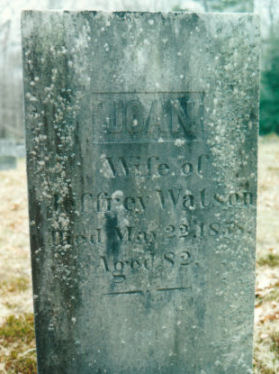
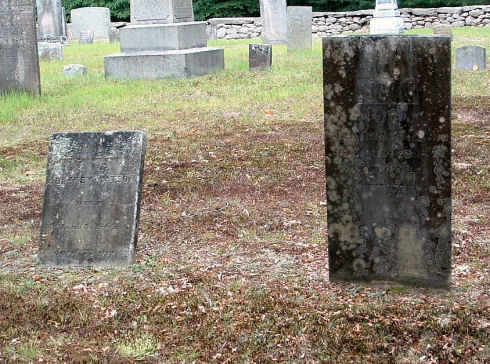
Gallup Cemetery in Sterling, CT, is located on the west side of Porter Pond Rd. north of Cedar Swamp Rd. The coordinates, as given by Google Maps, are 41.657721454373686, ‐71.8229750021804.
In the early 1930s, when Charles R. Hale directed a Works Progress Administration (WPA) project transcribing headstone inscriptions for Connecticut cemeteries, the only Watson names recorded for Gallup Cemetery in Sterling were those of Jeffrey and Joanna Watson.
There is, in fact, one other Watson headstone in this cemetery. And there may be Watson burials lacking grave markers.
As mentioned earlier, the name inscribed at the top of Joanna’s headstone is “Joan” (why, we don’t know).
Her inscription: JOAN / Wife of / Jeffrey Watson / Died May 22, 1858 / Aged 82
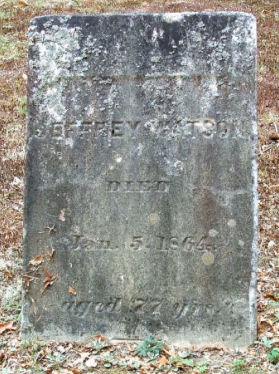
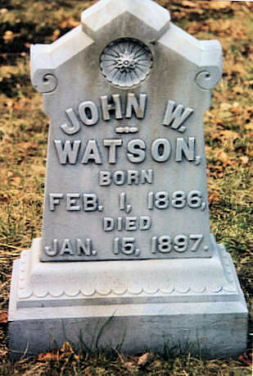
Though its beauty has been obscured by lichens and weathering, the size and elegant simplicity of Joanna Watson’s headstone is striking. Joanna’s stone is almost twice as tall as Jeffrey’s. Her family clearly sought to honor her with a distinctive grave marker.
Jeffrey Watson is buried next to Joanna. His headstone is smaller and made of a different kind of stone.
His inscription: JEFFREY WATSON / DIED / Jan. 5, 1864 / aged 77 yrs.
Jeffrey’s stone is tilted slightly backwards.
John W. Watson, great‐grandson of John Willet Watson
The small headstone for John W. Watson, who died in 1897 at age 10, might have been overlooked and left undocumented by Charles R. Hale’s WPA crew. We say this because that particular headstone appears to be made of cast zinc.
Cast zinc grave markers have raised lettering and a characteristic bluish‐gray color. They were manufactured by the Monumental Bronze Company of Bridgeport, CT, between about 1870 and 1912, which marketed them as “white bronze” to make it sound classier.
While it’s possible for any gravestone to be installed many years after a burial, John W. Watson’s grave marker itself predates the WPA documentation of Gallup Cemetery.
Records in the Sterling, CT, Town Hall tell us that John W. Watson was born in Sterling on January 31, 1886 – which differs by one day with what John’s gravestone says (Feb. 1, 1886). John was the son of George O. and Ida A. (Fenner) Watson. The date of death on John’s gravestone agrees with the record of his death in Sterling – Jan. 15, 1897, at age 10. Cause of death: “Strangulation.”
Though there is no marker for her, young John’s mother might also be buried in Gallup Cemetery. Ida (Fenner) Watson died on February 20, 1903.
George O. Watson – father of young John – was the son of George Perry Watson. “Perry” Watson died in Sterling on March 16, 1915; perhaps he, too, rests in Gallup Cemetery. Perry was the son of John Willet Watson (∼1808 ‐ 1858), known as “Willet.” Willet Watson likely was the son of Jeffrey Watson’s oldest brother, Hazzard. Jeffrey and Joanna Watson would have known Willet from the time he was born in West Greenwich. Indeed, Willet’s daughter Sarah, wife of Joseph Cory, was listed in the 1850 census just ahead of Jeffrey.
There is a poignant coincidence in the timing of Joanna (Gallop) Watson’s death and that of Willet Watson.
Joanna’s headstone tells us that she died on May 22, 1858. Willet Watson also died in May 1858.
When Willet’s death was recorded in West Greenwich, RI, his was the first entry for that month, but no day was given. The very next entry, for Thomas Matteson, was recorded for May 20, 1858. The entry after Matteson’s begins the record for June 1858. Can we reasonably assume that Willet Watson died prior to May 20th? Perhaps.
The lack of detail for Willet may have been due to how he perished: “Suicide – by hanging.” By the time they found Willet’s body, they might not have been able to determine how long he had been dead.
Joanna’s death happening so soon after Willet’s makes us wonder: Was the shock of such news too much for her?
To view Jeffrey Watson’s Find A Grave memorial, click here.
To view Joanna Watson’s Find A Grave memorial, click here.
To view young John W. Watson’s Find A Grave memorial, click here.
The Hale Collection of cemetery inscriptions for Gallup Cemetery in Sterling can be viewed at this CT Genweb site.
Harriet Hempstead After Elhanan
We know from the 1860 census that Harriet (Hempstead) Watson and her son Charlie were living in Newtown with Harriet’s mother Asenath Hempstead. It was just the three of them: Harriet’s father, Zabdiel, had died on November 1, 1858. This census recorded Harriet’s occupation as weaver, so it’s probable that Asenath took care of Charlie when Harriet was at work.
Asenath Hempstead passed away on the 21st or 22nd of June 1863 (depending on which source you consult). She was laid to rest in Sandy Hook Cemetery in Newtown, where Zabdiel was buried.
The date of Harriet’s marriage to Stephen V. Niles as provided by the Genealogy of the descendants of William Chesebrough of Boston, Rehoboth, Mass.—June 29, 1864—probably is correct, given that their son Stephen Dwight Niles was born on April 9, 1865. Stephen V. Niles was a widower. His first wife, Sarah “Sallie” Sanford, died January 16, 1863, leaving him with five children—Elias S.; William Sanford; Henry Jackson; “Bird;” and Jennie A. The 1870 census shows this family living on the Niles family farm in Mount Pleasant, Wayne county, PA. Charlie Watson—age 18, a bookkeeper—lived there, too, along with his stepfather’s parents, Spencer and Dorothy Niles.
Apparently sick enough to anticipate his own demise, Stephen V. Niles drew up his last will and testament on February 13, 1871. He died on March 1st, little more than two weeks later.
In his will, Stephen V. Niles left all his estate, “both real and personal,” to his son Elias S. Niles, the only child to have reached the age of majority. He also made provision for Harriet and his younger children to continue living on the farm. Stepson Charlie Watson was mentioned thus:
“It is my desire that my wife, Harriet M. Niles, shall stay with Elias until Stephen D. Niles arrives at the age of twenty years, at which time Elias shall pay to her the sum of Three Hundred Dollars; but if she gives to Charles Watson one dollar of the amount herein willed, then she is to forfeit the same, and it shall be equally divided between my children then living”
It’s probably safe to say that stepfather and stepson didn’t get along. But Charlie was already on his way out of this family. On October 17, 1870, in the village of East New York, Kings co., NY, Charlie married Jessie D. Blauvelt of Union Township, Bergen county, New Jersey. (Charlie’s father’s name was recorded as Hanan Watson.)
An 1872 land ownership map for Wayne county, PA, lists “E. S. Niles” in Mount Pleasant. Comparing that 1872 map with a contemporary map, we deduced that the Niles farm was located on the west side of present‐day Bigelow Lake Rd. north of Lake Cross Rd. We expected to find Elias S. Niles and all the others in the 1880 census for Mount Pleasant, Wayne county, PA. But they weren’t there. As far as we can tell, only William Sanford Niles (known as Sanford) remained in Mount Pleasant, living with his wife Isabelle in the household of her parents, George and Ruth Mumford.
In 1880, Harriet was living in Union Township, Bergen county, NJ—her daughter‐in‐law Jessie D. Blauvelt’s hometown. Living in her household in that census year were her 15‐year‐old son Stephen Niles; 60‐year‐old Charles Ingersoll (who, in 1870, resided in Jessie’s parents’ household); and 70‐year‐old James Blauvelt (who we’d guess was a relative of Jessie’s). Charlie Watson and his wife Jessie were even further away: In 1880 they were enumerated in Columbia Township, Elko county, Nevada, where Charlie worked as a mining superintendent.
What happened to Stephen V. Niles’ dying wish that his family remain on his farm? We found our first clue in Thomas Sanford, the Emigrant to New England, a compiled family history mentioning Stephen and Sarah (Sanford) Niles. The Thomas Sanford book indicates that their eldest child Elias Niles “d[ied] early.”
In August 1872, a notice was published in a local newspaper regarding five widows who had “filed their claims for appraisement of $300, and the same would be presented to the Court at the ensuing September term, unless exceptions are filed.” That list included the widow of Stephen V. Niles of Mount Pleasant. (Wayne County Herald, Honesdale, PA; August 28, 1873, pg. 2)
In the summer of 1875, an auditor’s notice was published in the same newspaper:
“The undersigned having been appointed auditor by the Orphan’s Court of Wayne county to make distribution of the money in the hands of the executor of the estate of Stephen V. Niles, deceased, among the persons entitled, will attend to the duties of said appointment at the office of the County Treasurer, in the borough of Honesdale, on Saturday, August 14, 1875, at two o’clock P.M., at which time and place all persons having claims upon said money are required to present the same or be forever debarred from coming in upon said fund. WM. H. LEE, Auditor, Honesdale, July 12, 1875”
(Wayne County Herald, Honesdale, PA; August 5, 1875, pg. 2)
This auditor’s notice could mean simply that Stephen V. Niles’ estate was in the process of being probated. But the mention of “distribution of the money in the hands of the executor” suggests that the Niles family farm had been sold. Given that Elias S. Niles disappears completely from the record after 1871‐72, we lean towards the likelihood that Elias passed away in the years immediately following his father’s death.
Harriet lived for years in East Rutherford, Bergen co., NJ. On May 28, 1893, in Rutherford, her son Stephen D. Niles married Helena “Lena” Giebner. After 1900, Harriet moved to Portland, Multnomah county, Oregon—where Stephen, Lena, and their children Irving and Florence lived.
Harriet M. (Hempstead) (Watson) Niles passed away on April 25, 1912, at age 81, in Portland, OR. Stephen Dwight Niles died on February 24, 1937, also in Portland.
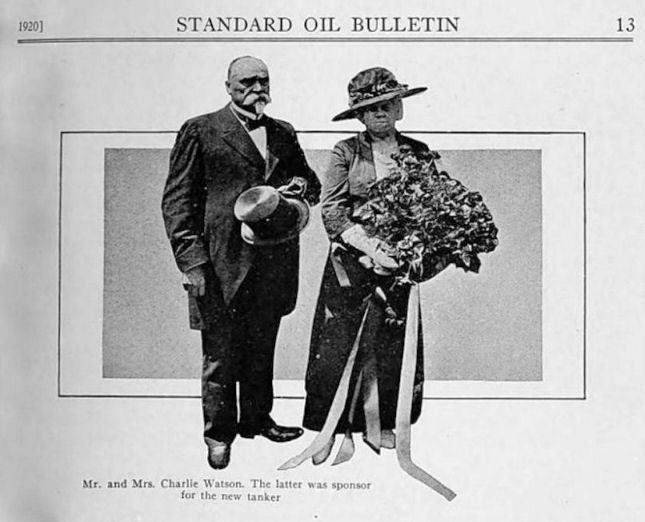
Charlie and Jessie Watson ended up living for many years in Oakland, Alameda co., California. He enjoyed a long career in management with the Standard Oil Company of California.
In August 1920, a Standard Oil tanker was named for him in honor of his years of valuable service to the company. The Oakland Tribune newspaper reported on the event:
ELECTRIC TANKER GLIDES TO WAVES TO FLARE OF BAND
Amid cheers the last remaining prop was knocked away, the Richmond band struck up “The Star Spangled Banner,” Mrs. C. A. Watson smashed a bottle of champagne across the bows [sic], and the new tanker Charlie Watson glided down the waves into the water at the Union Construction company yard yesterday noon.
The vessel is named in honor of Charles A. Watson, identified with the construction activities of the Standard Oil Company since 1882. He was on the platform at the side of Mrs. Watson when she christened the ship. The Watsons live at 4171 Opal Street, Oakland.
(Oakland Tribune, 15 August 1920, page 13)
Charles Arthur Watson died at home in Oakland, CA, on July 23, 1926. His wife Jessie (Blauvelt) Watson died in Oakland on August 14, 1932—twelve years to the day after she christened the tanker Charlie Watson. They had no children.
Sources — somewhat in order of their appearance in the text, and with no consistent format
Cowell, Benjamin, and James N. Arnold. Spirit of ’76 in Rhode Island; Boston: 1850. Pay Abstract of Capt. Gorton’s Company, for the month of September, 1776 (page 36). ebook obtained from Google Books, 17 April 2007
Katharine U. Waterman, “The Rhode Island Census of 1782,” New England Historical and Genealogical Register Vol. 129, no. 1, January1975: West Greenwich, pages 57 – 62; the entry for Samuel Gallop’s household appearing on page 61. Digital images, AmericanAncestors.org (http://www.americanancestors.org/ : accessed 8 December 2001)
Abstract of the will of Thomas Draper, West Greenwich Wills Vol. 2 1760‐1790; pgs 126‐128. Rhode Island Genealogical Register, Vol. 2, No. 3, Abstracts of West Greenwich, Rhode Island, Wills by Nellie M. C. Beaman. Printed from Family Archive Viewer, CD215 Vital Records: Rhode Island, 1500s‐1900s. © MyFamily.com, Inc.
Abstract of the will of Jane (Brayman) Draper, West Greenwich Wills Vol. 2 1760‐1790, pgs 266‐267. Rhode Island Genealogical Register, Vol. 2, No. 4, Abstracts of West Greenwich, Rhode Island, Wills by Nellie M. C. Beaman. Printed from Family Archive Viewer, CD215 Vital Records: Rhode Island, 1500s‐1900s. © MyFamily.com, Inc.
Ancestry.com – our favorite source for census and military records, and more.
William Gallop, Revolutionary Soldier, by Louise Gallup Walker, published in 1973. Downloadable PDF selections of this work can be found at this web page; Pages 216 and 217, regarding Richard Gallop, are among those selections, which we first accessed on 23 September 2005.
Rhode Island Roots, “Gleanings from Rhode Island Town Records: West Greenwich Town Council Records, 1741‐1772” (Special Bonus Issue, April 2015), by Catherine Hey; pgs. 5, 7, 101, and 109. Warwick, RI: Rhode Island Genealogical Society, 1975‐.
The research and scholarship of Gallup descendant Carmen M. Johnson, much of it posted online at her Gallup Family genealogy web site. Thank you, Carmen!
Town Clerk’s office, Exeter Town Hall, 675 Ten Rod Road, Exeter, RI; Exeter Probate records, Volume 2, pages 182‐183: the will of Hazard Watson.
Flint, James, ed. Rhode Island Colonial War Servicemen, 1740-62 [database on‐line]. Provo, UT, USA: Ancestry.com Operations Inc, 1999. Original data: Chapin, Howard. Rhode Island in the Colonial Wars. Providence, RI, USA: The Society, 1920.
Van Leuven, Audrey. Draper, Lothrop, Rogers, Byington, Goodsell, Etc: Allied Families of Van Leuven. [Fallbrook, California]: [A. Van Leuven], 1999. Accessed from the Family History Library; familysearch.org
Was Samuel Gallop/Gallup of Bristol, RI the “Lost” Son of Captain John Gallop of Boston, MA and Stonington, CT? by Dorothy Chapman Saunders, Ph.D. Rhode Island Genealogical Register, 1990, Vol. 13, pgs. 205‐214. Printed from Family Archive Viewer, CD215 Vital Records: Rhode Island, 1500s‐1900s. © MyFamily.com, Inc.
Rhode Island, U.S., Vital Extracts, 1636‐1899, Volume 01: Kent county: Births, Marriages and Deaths [database on‐line]. Volume 08: Church Records: Member Lists, Baptisms, Marriages, Deaths. Provo, UT, USA: Ancestry.com Operations, Inc., 2014. Original data: Arnold, James Newell. Rhode Island Vital Extracts, 1636‐1850. 21 volumes. Providence, R.I. : Narragansett Historical Publishing Company, 1891‐1912. Digitized images from New England Historic Genealogical Society, Boston, Massachusetts.
Hopkins, Daniel Franklin. Descendants of James Hopkins and Jean Thompson of Voluntown, Conn. Cleveland: H. Carr, 1917; Appendix III, pg. 32‐33. Accessed on 4 January 2020 at this web page and also at this other web page.
Two queries posted by John H. Schultz in a New England Historic Genealogical Society publication found at the NEHGS web site American Ancestors (accessed 11 March 2021). Title given as “Queries Vol. 3 No. 1” with an original publication date of February 1986.
The genealogical history of the Gallup family in the United States : also biographical sketches of members of the family [database on‐line]. Provo, UT: Ancestry.com Operations Inc., 2005. Original data: Gallup, John D. Genealogical History of the Gallup Family in the United States, Also, Biographical Sketches of Members of the Family. Hartford, Connecticut, 1893; page 52.
Connecticut Marriages, 1640‐1939, database with images, FamilySearch : 12 May 2016), 004016000 > image 70 of 746; Connecticut State Library, Hartford.
Groton Vital Records 1704‐1853, from Connecticut, U.S., Town Birth Records, pre‐1870 (Barbour Collection) [database on‐line]. Provo, UT, USA: Ancestry.com Operations Inc., 2006. Original data: White, Lorraine Cook, ed. The Barbour Collection of Connecticut Town Vital Records. Vol. 1‐55. Baltimore, MD, USA: Genealogical Publishing Co., 1994‐2002.
Gerrish, E. P., W. C. Eaton, D. S. Osborn, H. C. Osborn, E. M. Woodford, and W. H. Rease. Map of Windham County, Connecticut. Philadelphia: E.M. Woodford, 1856. Retrieved from the Library of Congress, <www.loc.gov/item/2001620487/>.
Map of Voluntown, Connecticut, circa 1868 (Petersen Collection), was obtained at <https://www.flickr.com/photos/uconnlibrariesmagic/3426845684>. The University of Connecticut library’s Map & Geographic Information Center (MAGIC) offers a broad array of historical maps <http://magic.lib.uconn.edu/historical_maps.htm> “View MAGIC's entire Historical Map Collection on Flickr including the ability to view maps by year and by geographic location.”
Voluntown, CT, Town Clerk; Vital Records (Births – Marriages – Deaths), page 20: The marriage of Jeffrey Watson and Eunice Adams on December 12, 1861.
Eunice (Niles) (Adams) Watson’s death was reported in the March 22, 1865, issue of the Christian Secretary newspaper. We obtained that record from Ancestry.com. U.S., Newspaper Extractions from the Northeast, 1704-1930 [database on-line]. Provo, UT, USA: Ancestry.com Operations, Inc., 2014. This collection was indexed by Ancestry World Archives Project contributors. Original data: Newspapers and Periodicals. American Antiquarian Society, Worcester, MA.
Willet Watson 1858 death record: West Greenwich, RI, Town Clerk; West Greenwich Deaths 1853-1905, page 6.
The New England Historical Society’s online article 1816: The Year Without A Summer, accessed 29 December 2022.
Samuel Watson file, no. W18249, Revolutionary War Pension and Bounty-Land Warrant Application Files, micropublication M804, roll 2508 (Washington: National Archives); NARA, Frederick C. Murphy Federal Center, 380 Trapelo Rd., Waltham, MA, cabinet 32, drawer 1.
Marshall, Benjamin Tinkham. A Modern History of New London County, Connecticut. New York: Lewis Historical Publishing Company, 1922.
© 2023 Elaine Schenot
Click here to read The Watson Family’s Greatest Hits, our compilation of newspaper clippings; family stories; and an assortment of old photos— but mostly Watson men behaving badly. Nehemiah Watson’s children and some of their wives are the main feature of this piece.
Click here to read Regarding Samuel #26 Watson in The American Family of John Watson of the Narragansett Country, Rhode Island
Click here to see Images for Samuel #26 Watson
Click here to read Where’s Alice? The Location of the “Lost Watson Lot”